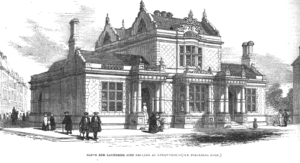The Pipe Organ in China Project: Updates for June 2024
30 June 2024
Updates for June 2024:
The new organ for Christ Church, Shamian, Guangzhou, CAN2024, was installed during June. It is not clear when or if there will be a dedication of the instrument and/or a concert.
The Project is still waiting for an adequate photo of the organ in situ in Guangzhou. In the mean time, the new page for CAN2024 has a photo of the organ when it was still located in the Netherlands. The move of the organ from Europe to China was facilitated by Van den Heuvel Orgelbouw. Here is a photo, kindly sent to us by Emily Ke, of the organ under reinstallation:

Organs in the Census: 209
Hits this month: 1,211
Top Ten Countries:

The Pipe Organ in China Project: Updates for May 2024
31 May 2024
There is only one update for May: we received some nice photos of HAR2015 from one of our friends, which have been put on the page for that installation.
During mid-May, the POCP Website was down for most of a week, due to migration of our host’s sites to new servers. We are sorry for any problems this may have caused our visitors. It caught us off guard as well, and was the source of some worry. Although everything is back to normal, it seems that in the process some pictures got resized downwards, and corrections will be made as we find them.
Organs in the Census: 208
Hits this month: 859
Top Ten Countries:

The Pipe Organ in China Project: Updates for April 2024
30 April 2024
A new 4-manual and pedal Rieger organ with 86 stops, PEK2024, has been installed in the new ‘Beijing Performing Arts Center’, which is actually not in Bejing itself but in the city of Tongzhou, which now lies on the eastern side of a huge Beijing administrative district surrounding the Mainland Chinese capital. The Project assumes that this organ and the new hall were planned long prior to the COVID-19 epidemic, and that installation was delayed as a result. The Belgian firm, Kahle Acoustics, was a consultant on the project, and interesting details of their work on the hall can be found here: https://kahle.be/en/ref/beijingPerformingArtsCentreTongzhou.html
The pages for FCW1931 and FCW2005 have been updated. The Project thanks our correspondent, Emily Ke, for a photo we have used for the latter installation. The page for HKG2009 has also been updated, and the Project is grateful for new photos by organ builder, Cealwyn Tagle.
The Links page has also been updated.
Finally, clips from the Jesuita Cantat 2.0 concert, held in November 2023 as part of the 3rd Hong Kong Hymnos Festival, have now been uploaded to YouTube. Sung by Vox Antiqua, and conducted by Project founder Prof. David Francis Urrows, this program included Henry du Mont’s Messe royale du première Ton, sung in the form published and used in Shanghai by the Jesuits in the nineteenth century, and accompanied for the first time in 150 years by the ensemble formed by François Ravary SJ, of organ, dizi, and sheng.
Another major work, part of which was performed at Zikawei, was the Salut pour le jour du Saint Sacrement by Louis Lambillotte SJ, one of Fr. Ravary’s teachers. Again, this is probably the first time in at least a century since this work was last performed, at least publicly. Other works by Lambillotte, as well as compositions by Jules Dufour d’Astafort SJ, one of Lambillotte’s students and later his literary executor, and Saverio Mercadante, were also on the program.
The clips of these works from this concert, as well as music from the 2022 Jesuita Cantat 1.0 performance, can be found here: https://www.youtube.com/@voxantiquahk
Organs in the Census: 208
Hits this month: 1,116
Top Ten Countries for April 2024:
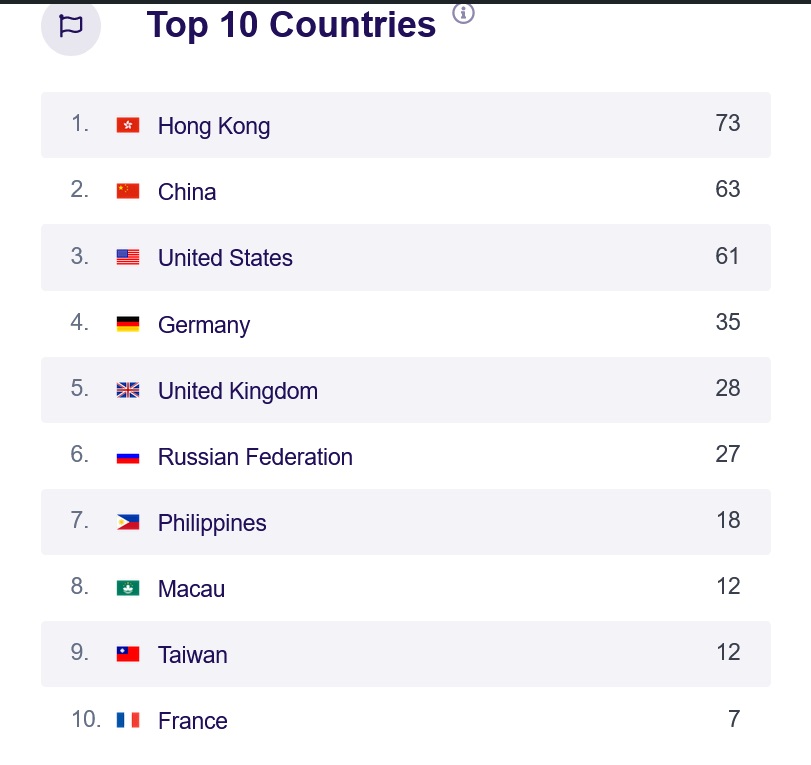
The Pipe Organ in China Project: Updates for March 2024
31 March 2024
The pages for PEK1989 and PEK2014 have been updated, as well as the FAQs.
Word has reached The Project that PEK2015a, the Casavant organ in the Nantang in Beijing, is now under renovation by Carillon Technology Singapore (see photo below). The 1904 church (the Church of the Immaculate Conception) has been closed for most of the past nine years. On the heels of the dedication of the organ, it was shut after Christmas 2015 for no apparent reason. At some point it was reopened, and then closed again at the beginning of the COVID-19 epidemic. The entire interior of the church is being rebuilt/redecorated, as far as photographs seen by The Project appear to show.
On another topic, one of our correspondents has drawn The Project’s attention to an installation from the past ten years, where the builder has apparently removed the specs from their website. This is a concern to us, as we have relied on organ builders keeping this information on their webpages, and saving us the trouble of having to create a chart for these instruments (which would necessarily be less comprehensive.) We will follow this matter and try to replace the now-missing information where possible. To any of our visitors who finds that a link to a builder’s site no longer has the specs for the corresponding organ in the Census, we ask you to please let us know about this through an email to calcant@organcn.org
We wish all our visitors and friends a happy and blessed Easter Day.
Organs in the Census: 207
Hits this month: 900
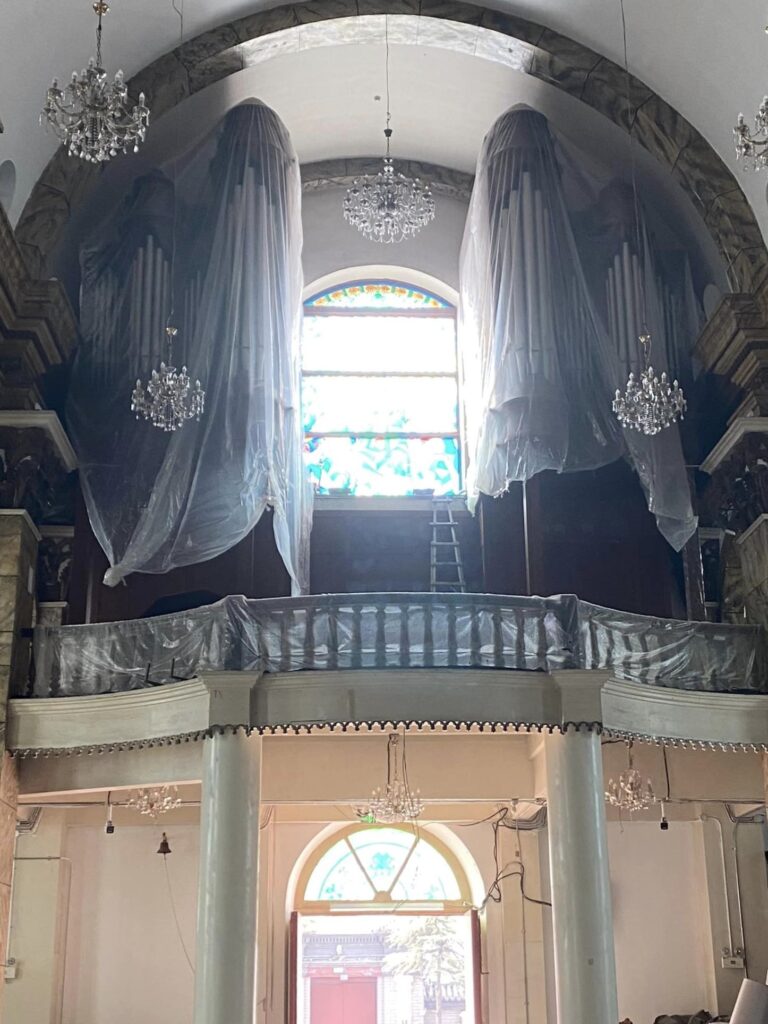
PEK2015a in March 2024. Photo courtesy of Roster Wu/ Carillon Technology Singapore
The Pipe Organ in China Project: Updates for February 2024
29 February 2024
The FAQs have been updated, as well as the Errata list for Keys to the Kingdom.
The page for SHA1865 has been updated, with a new 1855 image of the Church of Our Savior, Hongkou, Shanghai.
Word has reached the Project of the upcoming (re-)installation of a 1964 II/7 Pels organ in Christ Church, Shamian, Guangzhou. The former Anglican church (now controlled by TSPM, and known as the shamian tang) is a historic building, completed around 1864 and replacing an earlier church destroyed by fire in 1856. The sale-and-relocation of the Pels organ has been facilitated by Van den Heuvel Orgelbouw, Dordrecht. This organ replaces CAN1904, a similarly-sized Walker organ which disappeared at some point after the late 1930s. Presently being packed for shipment, when the installation of the Pels organ is complete we will add it to the Census with all details. It is a positive sign to see another redundant organ installed in a church in Mainland China.
We wish all of our viewers and visitors a Happy Intercalary Day.
Organs in the Census: 207
Hits this month: 878
Top Ten Countries:
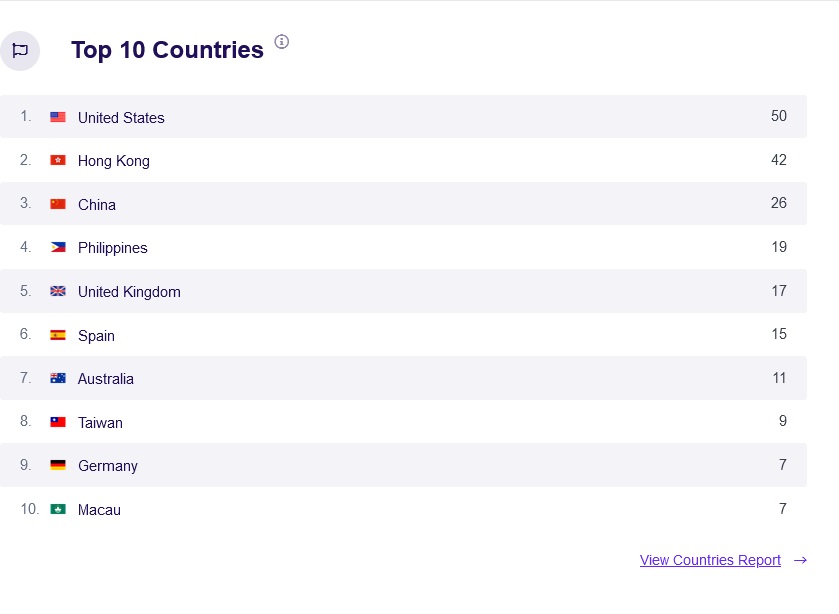
The Pipe Organ in China Project Website: Updates for January 2024
31 January 2024
The only update for this month come from JL Weiler in Chicago, who sent us some photographs of their work on the restoration, along with Casavant, of PEK1920. We now have a nice picture of the newly-installed (though vintage) Kimball two-manual stopkey console (stopkey consoles were standard for theater organs, and take up slightly less space than drawknob consoles.)
Chinese Lunar New Year begins on the evening of 10 February. We wish all our friends and visitors a Happy Year of the Dragon.
–The Pipe Organ in China Project
Organs in the Census: 207
Hits this month: 862
Photo of the Month: The I/7+Ped 1919 Hinners tracker action organ in Seoul, (now) South Korea, regrettably destroyed in the Korean War of 1950-53. (The photo is probably from The Diapason, 1 April 1919.) This is said to have been the first pipe organ installed in Korea.
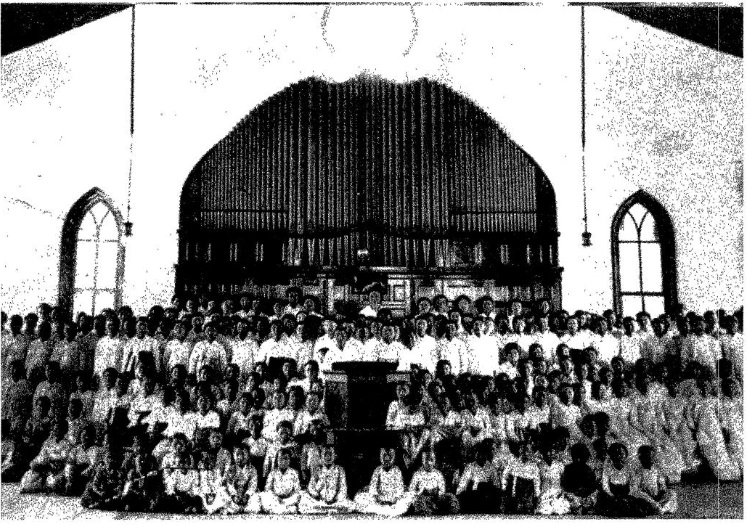
Seoul, Korea, 1919 Hinners organ after installation.
The Pipe Organ in China Project Website: Updates for December 2023
26 December 2023
A Happy Boxing Day to all of our visitors and friends.
A new two-manual chapel organ in Hong Kong, built by Diego Cera Organ Builders, has been installed in the historic Bishop’s House, and added to the Census: HKG2023.
The Project was informed on Christmas Day that PEK1920, the Kimball theater organ in the Auditorium of PUMC, has now been completely restored and reinstalled (with a new console) by Casavant and J.L. Weiler. It was re-dedicated in a concert held on 7 April 2023. Billed as a ‘Centennial Concert’, it in fact took place almost 102 years after the September 1921 dedication of the Auditorium and organ. Along with performances of various patriotic choral pieces by Chinese composers, organist Shen Yuan played the Toccata and Fugue in D minor (Bach), the Allegro, Chorale, and Fugue in D Major (Mendelssohn), Pomp and Circumstance March No. 1 (Elgar), the Wagner and Mendelssohn wedding marches, and accompanied the ‘Ode to Joy’ (Beethoven). We have requested the specs of the rebuilt organ as well as new photos, and will update the page for this installation when we receive them.
Prof. Urrows posted a blog entry in December on the 1969 Catholic Hymnal, published in Hong Kong. This hymnal includes a number of original liturgical works by Hong Kong composers of the time, including Father Antonio Riganti (1893-1965), who was discussed in a What’s New post in 2019. An interesting essay on his musical background by Father Riganti may be found here: https://musicasacra.org.hk/publish/composers/riganti_en.html
We wish all of our friends and visitors a Happy and Blessed Christmastide. Please enjoy singing the Chinese version of Venez, divin Messie, from the score below! This comes the 1926 SVD hymnal, Cantiques en Chinois, and this version is still sung in Roman Catholic churches in Mainland China to this day.
Organs in the Census: 206
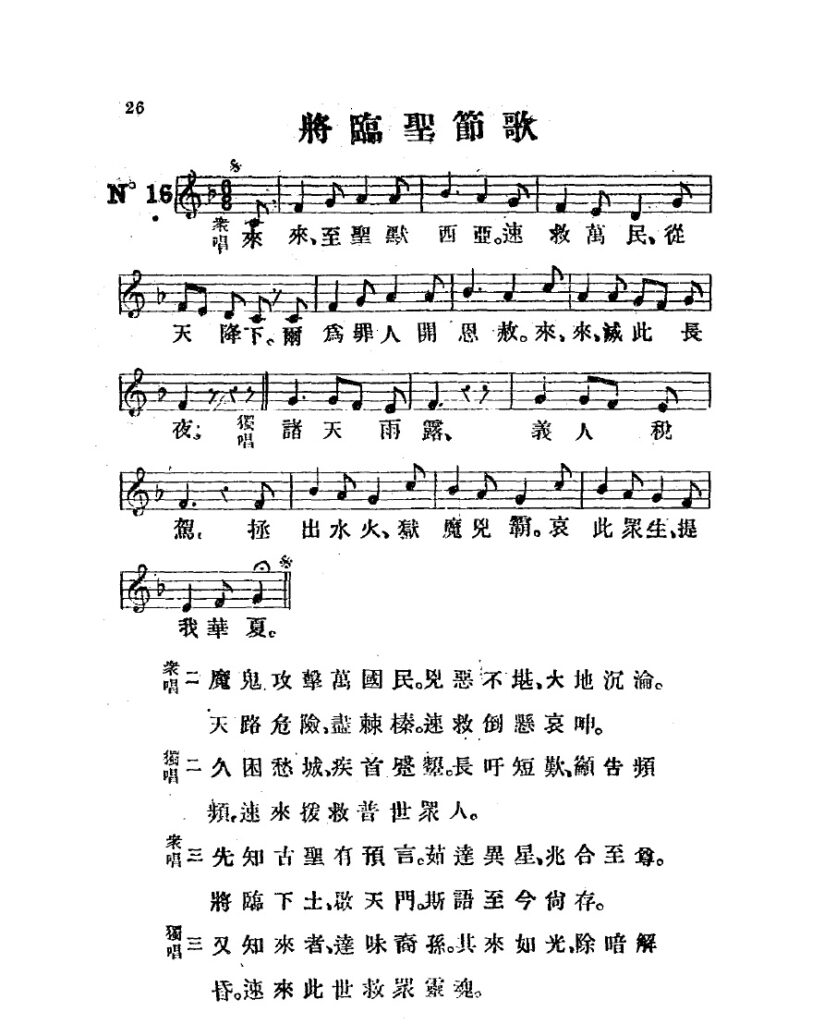
A Catholic Hymnal from the 1960s, and more on Father Riganti.
19 December 2023
Prof. Urrows writes:
Over the years I have found a number of treasures in unlikely places in Hong Kong, but my favorite haunt is the Michaelmas Fair at St. John’s Cathedral at the end of October each year. This year, one of the things I picked up is a small hymnal, simply entitled Catholic Hymnal, and published in March 1969 by the Hong Kong Catholic Truth Society.
In the Foreword, we learn that this hymnal took seven years (1962-69) to complete. Since it is only 158 pages in a small format (13x19cm), one might wonder what took the Hong Kong Diocesan Hymnal Committee so long to finish its work. There appear to have been two reasons, both of which hit the Committee in 1965. The first of these was the end of the Second Ecumenical Council (known popularly as Vatican II), which sat from 1962 to 1965. This is noted with a dour comment about “liturgical changes introduced in recent years”, but that doesn’t begin to describe the earthquake of reforms that hit the Roman Catholic church worldwide in 1965, with those affecting music satirized in Tom Lehrer’s classic comedy song, The Vatican Rag. Obviously, in 1965 the Committee had to some extent to begin all over again with a new set of (confusing) directives.
The second reason was the death of P. Antonio Riganti PIME (1893-1965) in the same year. Father Riganti has appeared in What’s New before (for July 2019), and he was the first Chairman of this hymnal’s Committee. I found in this hymnal two hymns composed by Father Riganti, as well as two ‘Psalm Refrains’ (what we would today call Responsorial Psalms) for Psalms 2 and 21, as well as five complete Psalms settings (22, 99, 116, 129, and 135). All of these are given with words and melody only. If there was an accompaniment edition, I have not seen it.
Father Riganti’s hymns are through-composed, and not verse-hymns. The first, Now in the week’s new dawn, is an entrance hymn in English with a traditional four-square feel, but also a fluid sense of melody. The words seem to be by one of Riganti’s committee colleagues, a Sister Maria Eucharistica. The second hymn in in Chinese, Lead the Holy Church. This is written in a hexatonic scale (no leading tone) and is printed with Western music notation and Chinese jianpu numerical notation. This is also the approach Riganti took with the responsorials, and the five complete Psalms (see Psalm 135 (=Psalm 136 in most psalters) below).
We see several different demands being catered to here. First, the emphasis on local-language worship. The second, is the approximation of melody using scales other than the European major/minor tradition (there are quite a few well-known hymns included, with both English and Chinese words.) Third, increasing congregational participation in singing. And finally, this hymnal reflects a period of transition in the Catholic church worldwide, as it tried to digest the directives of Vatican II. When it came to music, these directives were widely misrepresented and misunderstood. The Hong Kong 1969 Catholic Hymnal does better than many others from this period in balancing new and old, in my opinion. And I think much of this success must be due to the three years during which Father Riganti led the committee.
Earlier this year, a descendant of Father Riganti, who still lives in Italy, contacted The Project. We replied, with a request for more information about him, but to date we have unfortunately heard nothing back.
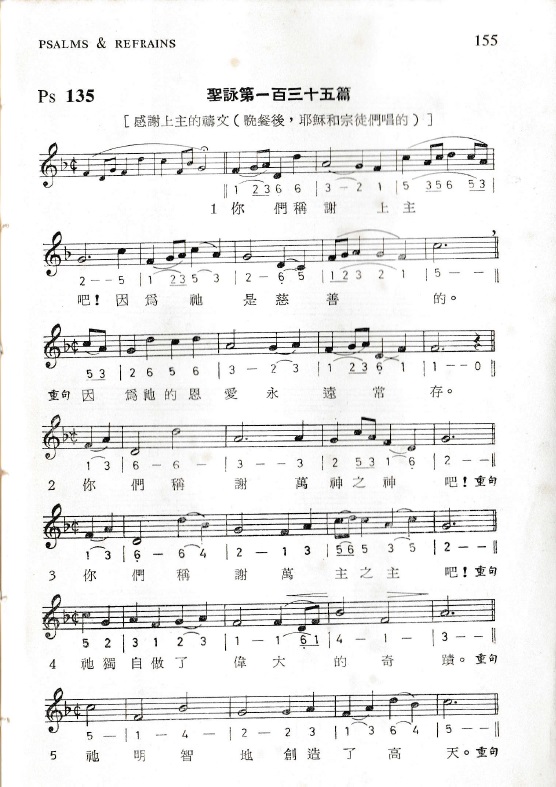
Psalm 135 (136), setting by Father Antonio Riganti.
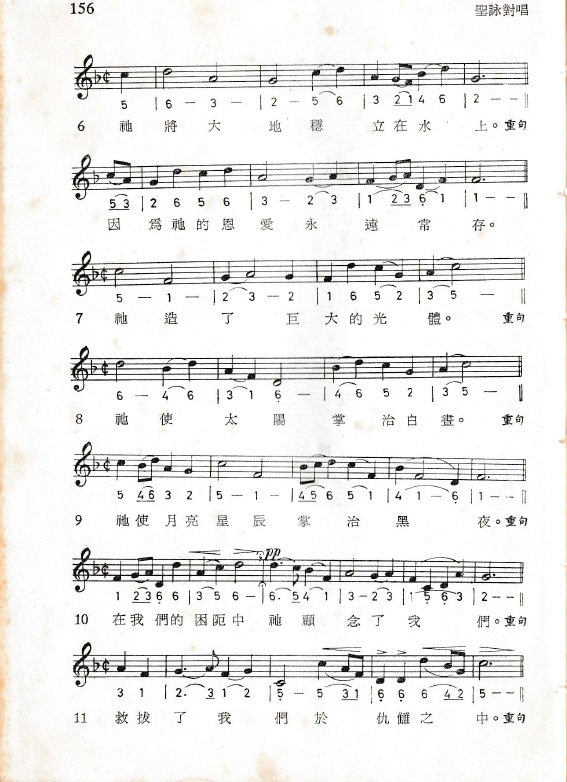
The Pipe Organ in China Project: Updates for November 2023
30 November 2023
With the disastrous effects of China’s ‘Zero-Covid Policy’ subsiding in some ways, long-delayed installations are finally taking place. But this month we have added a new organ to the Census with a different origin. This is a two-rank positive made at the Dalian University of Technology by Prof. Wang Xiaohu and his graduate students between 2021 and 2023. Prof. Hu’s goal is to stimulate pipe organ building locally in China. This means that DRN2023 is the first pipe organ built entirely in Mainland China, Hong Kong, or Macau since the closure of the firms of W.C. Blackett (Hong Kong), and Moutrie and Sam Lazaro (Shanghai) at the start of the Sino-Japanese War around 1939. The Project will follow with interest these developments.
Pages for TJN1913, DRN1914, and SHA1925 have been updated.
The Hong Kong Chapter of the American Guild of Organists held their annual member’s recital on 24 November. The program featured music by Albright, Bach, Boëllmann, Bolcom, Langlais, Mendelssohn-Bartholdy, and Vierne. The program is shown below.
Prof. Urrows contributed a blog post in November on the mystery of a harmonium that used to be in the Chapel of St. Joseph in Ma On Shan Village. Any communications about the whereabouts of this instrument will be gratefully received at calcant@organcn.org.
And the fourth annual Hymnos Festival is taking place in Hong Kong and Macau as this update is posted. On 25 November, the second Jesuita Cantat (Jesuita Cantat 2.0) concert took place in Hong Kong, presenting more music from the mid-19th Century French Roman Catholic missions in Shanghai. It was held at the little-known (but enormous) Chapel of Christ the King in Causeway Bay, with its superb 3.5 second reverberation time, ideal for choral music.
Prof. Urrows and Andrew Leung conducted the choir, Vox Antiqua, with guest players from Good Hope School on dizi (transverse flute), and sheng (bamboo mouth organ), Karen Yeung, dulzian, Chere Ko, organ, and guest singers Rachel Kwok, soprano, and Samantha Chong, mezzo-soprano. The major works were the Salut pour le jour du St. Sacrement of Louis Lambillotte, of which the last movement was sung in Shanghai under the direction of Fr. François Ravary, and the Messe royale du premier Ton of Henry du Mont, which was the standard setting of the Ordinary in the China missions until the 1920s. This was the first time that Father Ravary’s liturgical ensemble of organ, dizi, and sheng– a hidden ‘soundworld’ –had been recreated in 150 years (photo below). Other works known to have been sung in Shanghai (by Lambillotte, Jules Dufour SJ, Saverio Mercadante, and a Marian hymn sung to the melody of the French folksong, Des concert avec les anges), were also on the program. When clips from this concert of music from ‘China’s Hidden Century’ are available, we will post the links.
Organs in the Census: 205
Hits this month: 1,176
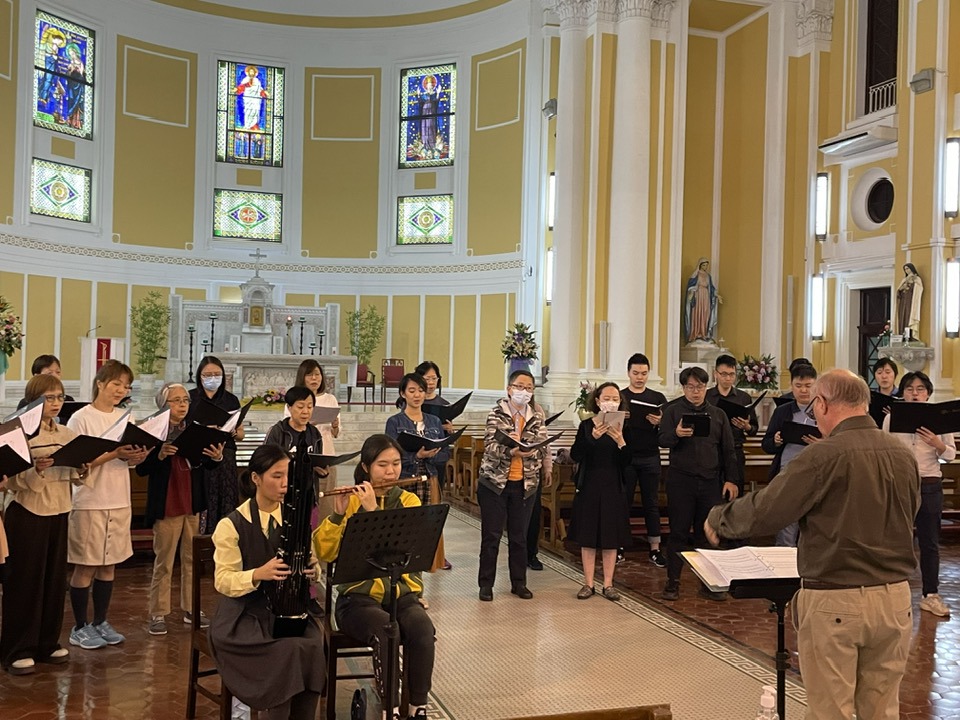
Prof. Urrows conducts a rehearsal of du Mont’s Missa Regia at the Chapel of Christ the King, Hong Kong.
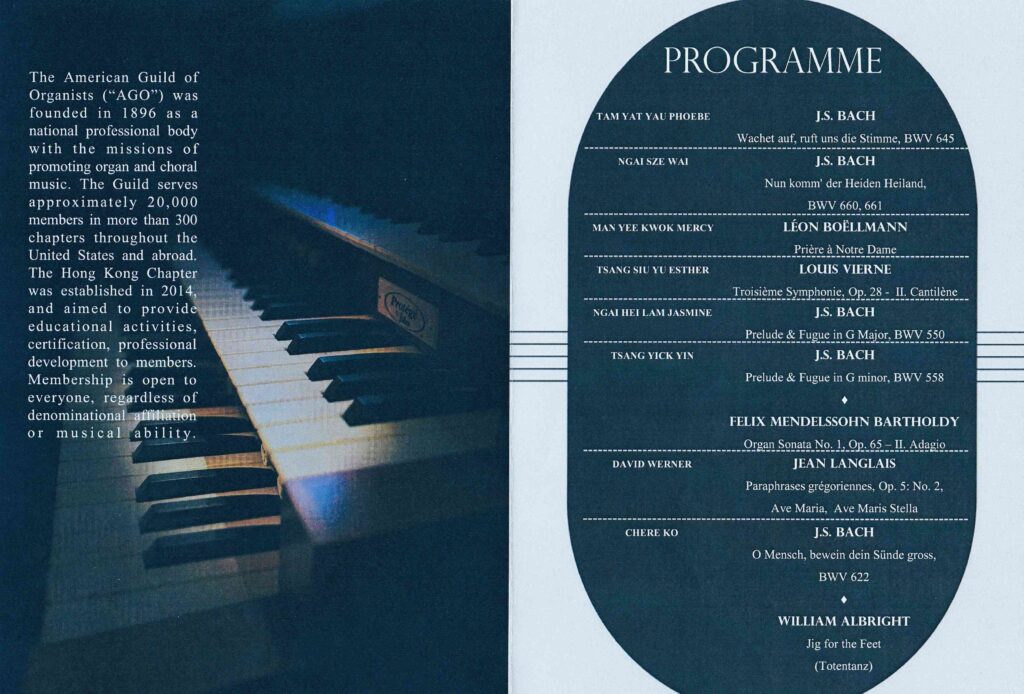
What happened to the Ma On Shan Harmonium?
5 November 2023
Prof. Urrows writes:
One of the small, nagging mysteries that I have dealt with during my many years in Hong Kong is the question of what became of a harmonium that used to be in the Chapel of St. Joseph in Ma On Shan Village (馬鞍山村)? The Project usually doesn’t concern itself with harmoniums, but a derelict harmonium in a nearby derelict church invites investigation.
The chapel is an early 20th Century building, perched on a hill overlooking the former tiny mining community in the hills of Ma On Shan (Horse Saddle Hill) on the east side of the Shing Mun River. The mining industry collapsed after the Second World War due to exhaustion of the ore in the hills. With the development in the 1980s of Ma On Shan New Town, the later Chapel of St. Francis near the river was eventually rebuilt in a more central location as a new parish church to serve the local population. The Chapel of St. Joseph was formally closed in 1999, but the church remained accessible for some years, perhaps until about 2013. https://www.stfrancis.org.hk/en/patron-history/
I happen to know this, because two magazine articles published between the mid-2000s and about 2012 contained photos of the harmonium in the tiny organ loft of the chapel. The first was a Hallowe’en-themed fashion spread (“Princesses of Darkness”) that appeared the Sunday Morning Post Magazine around 2007.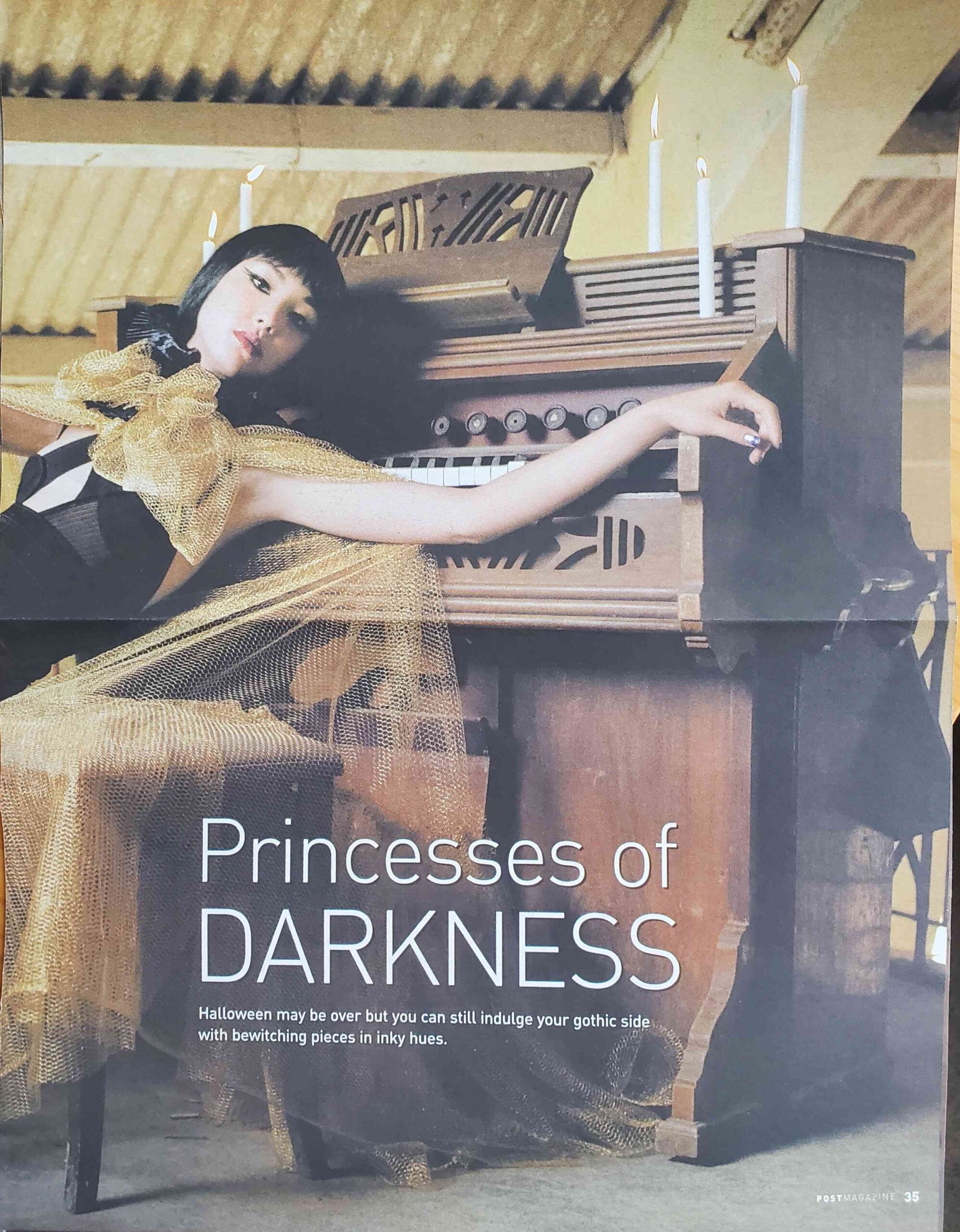
The second photo appeared in the Chinese-language magazine, Weekend Weekly (新假期) around 2012, in a things-to-do piece about Ma On Shan Village. The church was still clearly open to visitors at that time.
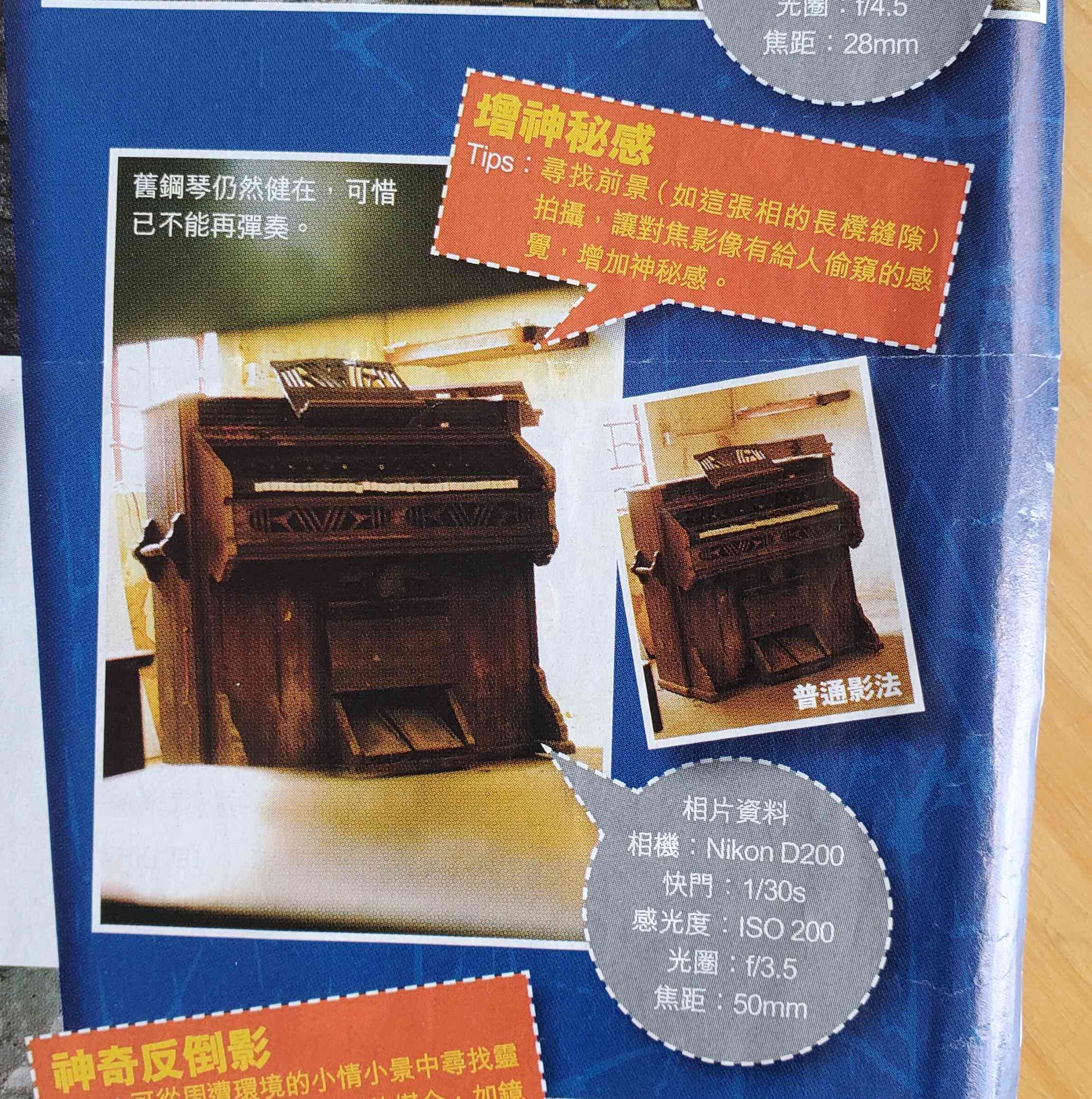
By 2014, when I managed to get up to the village, the church was closed, and several heavy padlocks secured the gate. Attempts to call a phone number on a small sign there failed to reach anyone.
But: what happened to the harmonium? And can anyone recognize the builder/catalog type? Except for the missing stop plates, it doesn’t look to have been in such bad condition. All info gratefully received at calcant@organcn.org
The Pipe Organ in China Project Website: Updates for October 2023
1 November 2023
Everything, Everywhere, All at Once. There are many things for The Project to report after a quiet summer.
The main event has been the long-awaited dedication of SHA2023, a three-manual and pedal 34-stop organ in the Cathedral of St. Ignatius Loyola at Zikawei (Xujiahui) in Shanghai. Built by Diego Cera Organ Builders, the installation was planned for 2020; COVID got in the way, leading to over 3 years of delays.
This new organ is closely related to the origins of The Project. The cathedral church itself is the 1910 successor to the first Church of St. Ignatius built in 1847. For this earlier church, Léopold Deleuze and François Ravary eventually built a bamboo organ (SHA1859), their third instrument after the groundbreaking organ for St. Francis Xavier (SHA1857), and the three-rank positive for the son of Napoléon III (SHA1858). In fact, one of the interesting discoveries of the past year has been that the 1847 church survived the Second World War, and may have still stood until the 1960s. The photo (below, looking north), taken from Fr. Thomas F. Ryan’s 1942 book, China Through Catholic Eyes, is an aerial view from the 1930s. The old church, with its Chinese-style lantern, is seen just slightly to the northeast of the 1910 Neo-Gothic Cathedral.
As a result of information shared with The Project by the Tushanwan Museum (which is functioning as a museum for the whole of the Zikawei Jesuit ‘village’), the page for SHA1883 (which was moved to the 1910 cathedral in 1925) has been updated significantly, with new photos, for which The Project is grateful.
The Links page has also been updated with corrected and added links, in particular www.formosaorganist.com, a Chinese-language website relating to organ performances and audience development in Taiwan. Prof. Urrows was a guest of Fu Jen Catholic University in Taipei in early October, and gave a lecture on “François Ravary SJ: Missionario musicista in China’s ‘Hidden Century’” on 3 October.
The pages for PEK2003 and TAO2008 have also been updated.
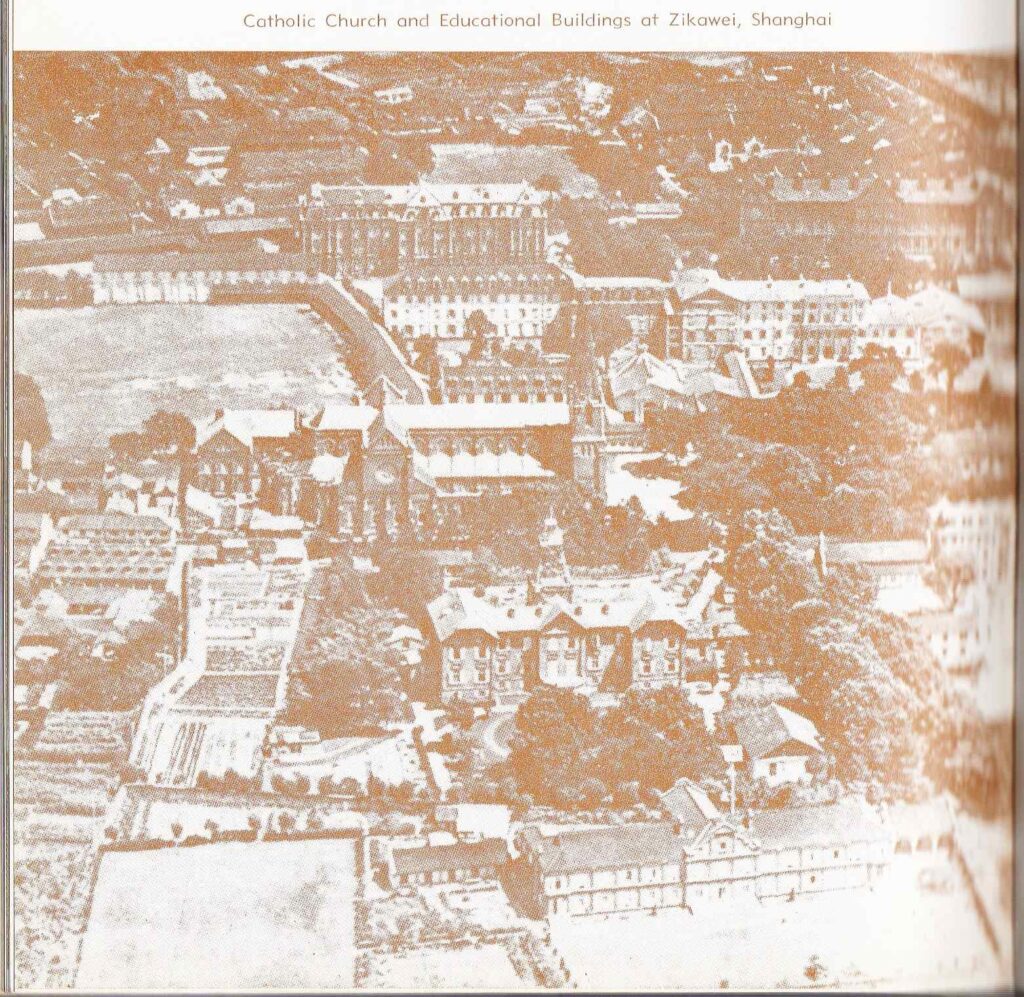
Aerial view of Zikawei, 1930s.
Organs in the Census: 204
Hits this month: 964
The Pipe Organ in China Project Website: Updates for September 2023
30 September 2023
The new Diego Cera Organ Builders III/34 installation at the Cathedral of St. Ignatius Loyola at Zikawei (Xujiahui) in Shanghai has now been completed. A dedication was held on Sunday, 24 September, with Philippine organist Alejandro Consolacion II playing the instrument for the service. This is the first installation of an organ in the cathedral in 98 years. The Project is waiting for photos of the organ and details of the event. An entry in the Census for this instrument will be made sometime in October, however we have updated the number of organs in the Census to 204.
At the same time, The Project has learned that the installation of the long-awaited Casavant organ for the Cathedral in Macau has been postponed yet again. The tentative date for start of the work now seems to be in 2024.
And while The Project does not really cover the area of organ repertory in China, The American Organist issue for September 2023 included an interesting article on four women composer/organists, now living in the US and Canada, of Chinese descent and their works (Calvert Johnson, “Organ Works by Women of Chinese Ancestry”, TAO, Vol. 57/9, pp. 48-59.) They are: Wang An-Ming (b. Shanghai, 1926), also known as Marion Wang Mak; Hope Lee (b. Taiwan, 1953); Vicky Chang Pei-lun (b. Taiwan, 1966); and Chelsea Chen (b. San Diego, CA, 1983).
Organs in the Census: 204
Hits this month: 1,241
Top 10 Countries:
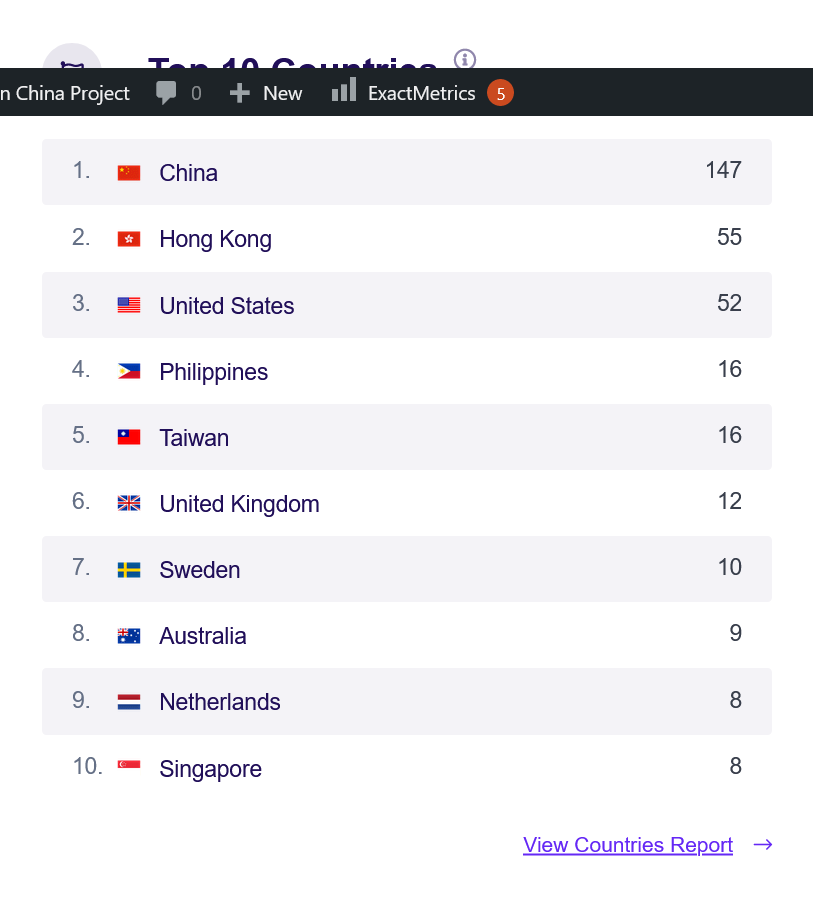
The Pipe Organ in China Project Website: Updates for August 2023
31 August 2023
Minor fixes have been made to HKG1933a.
The Project understands that the erection of the new organ in the Cathedral of St. Ignatius at Zikawei (Xujiahui), Shanghai has reached the tuning and voicing stage. A dedication is planned for the last week of September.
Photo(s) of the Month: The Cathedral of the Sacred Heart, Guangzhou (Canton) in 1973. Prof. Urrows writes:
“I came across this photo in a September 1973 magazine, published exactly fifty years ago. This shows, in the background, the Cathedral, finished in 1888. The photo was taken in April 1973, on the occasion of the first Export Commodities Fair to be held in Canton since the start of the Cultural Revolution (which ended only in 1976). A large contingent of Western business people attended the fair (coming up by train from Hong Kong, which took 4 hours in those days). The ramshackle neighborhood was essentially the same when I first visited the church in October 1989, sixteen years later. When I last visited, in 2010, the neighborhood was under total demolition, a telling example of the domicide movement of the 1990s and 2000s (see second photo). The church had been renovated, with some tasteless stained glass added (see fourth photo, with the Project’s invaluable RA, Florence Cheng, standing next to me.)
“We have never been able to trace an organ in this church, but a 1917 report mentioned one. I have long thought this was probably a large harmonium.”
Organs in the Census: 203
Hits this month: 688
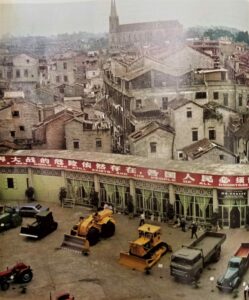
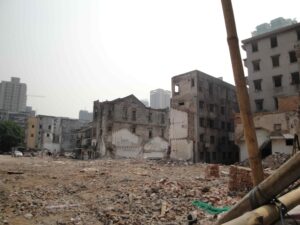
The neighborhood of the Cathedral in 2010, under demolition.
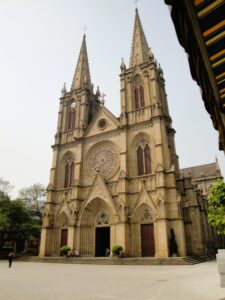
The 1888 Cathedral of the Sacred Heart.
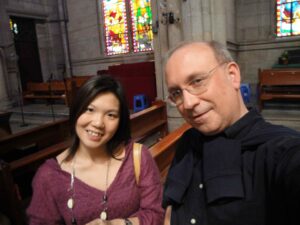
Prof. Urrows with Florence Cheng, Cathedral of the Sacred Heart, 2010.
The Pipe Organ in China Project Website: Updates for July 2023
31 July 2023
There are no updates to the Website or Census for July 2023.
We wish all of our visitors a pleasant summer holiday (if you have one), and remember to stay cool and hydrated wherever you are.
Organs in the Census: 203
Due to a problem with ExactMetrics, we are unable to give the number of hits this month, or the Top 10 Countries. We hope to be able to provide this data next month. Thank you for understanding.
The Pipe Organ in China Project Website: Updates for June 2023
30 June 2023
There are no updates to the Census for June 2023. This month marks the fifth anniversary of the opening of the POCP Website.
However, word has reached the Project about the long-deferred installation of two new pipe organs, both now in train.
First, installation of the new Casavant organ (Op. 3925, IV/43 [54]) at the Cathedral in Macau will finally begin in December this year. This electro-pneumatic action organ was announced for installation in 2018, postponed to 2019. Logistic and structural problems, and then the COVID-19 pandemic and China’s “Zero COVID” policy, were responsible for four further years of delay. It is hoped that the organ will now be ready to be inaugurated in early 2024.
And the new Diego Cera Organ Builders’ III/34 instrument for St. Ignatius’ Cathedral at Zikawei, Shanghai, mentioned in What’s New for 27 February 2021, is now being installed with a projected completion and dedication date sometime in October this year. As the Project learns more about this, we will post further details.
On the performance/education front, French organist Olivier Latry was in Hong Kong in early June to play Saint-Saëns 3 with the Hong Kong Philharmonic (the only organ+orchestra work they know, it seems.) While there, he also held a master class on HKG1989 for four local organists, all of whom chose works by late-Romantic and 20th C. French composers (see program below).
Organs in the Census: 203
(We have temporarily lost our ability to post statistics. Please check back next month.)
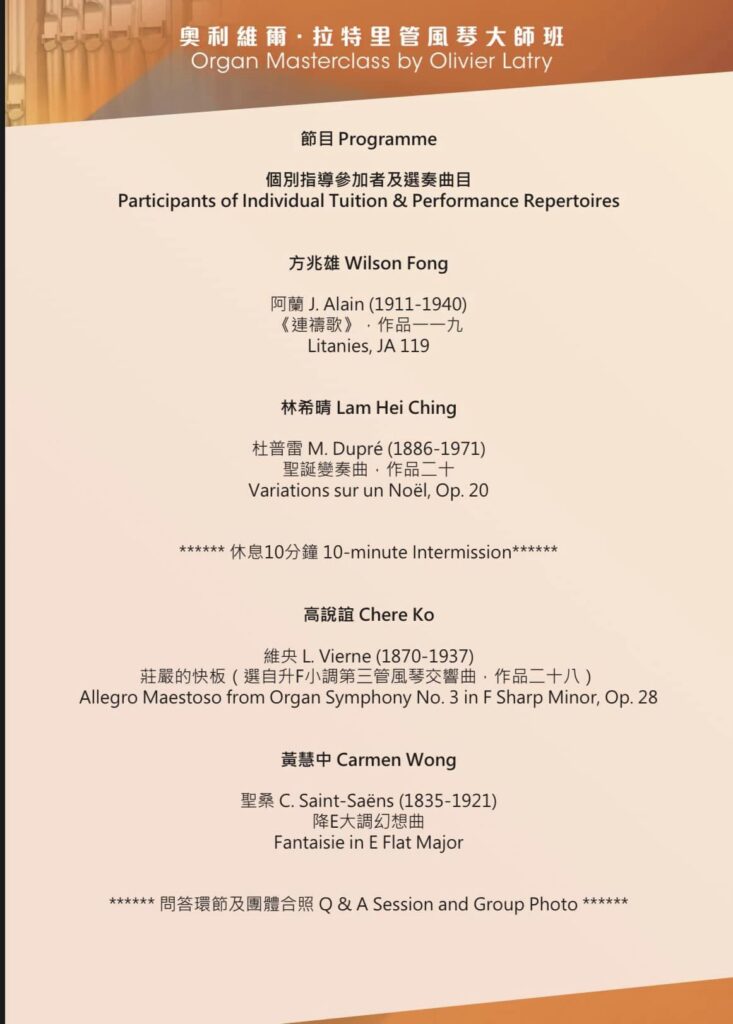
The Pipe Organ in China Project Website: Updates for May 2023
30 May 2023
There are no significant updates to the website for May 2023.
We received a communication from Chung Chi College at the Chinese University of Hong Kong, regarding Peter Cheung Pei-dak. He was a Trustee of the College, and they confirmed his year of birth as 1911. Information about Peter Cheung, his experimental electronic organs, and his possible sighting of one of the bamboo organs of Ravary and Deleuze (FCW1931), was included in two What’s New posts in 2020 (updated) and 2018:
http://organcn.org/blog/further-thoughts-on-fcw1931/
The Project is grateful for this new information.
Organs in the Census: 203
Hits this month: 836
Top 10 Countries, May 2023:
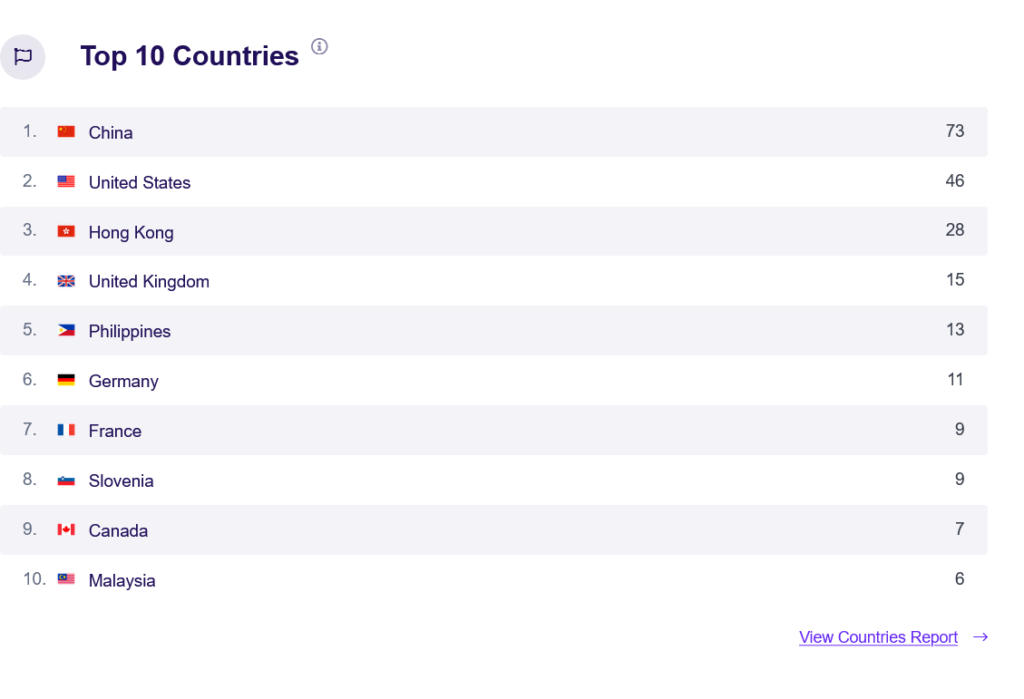
The Pipe Organ in China Project Website: Updates for April 2023.
29 April 2023
There are no significant updates to the POCP Website for April 2023. A new photo has been added to PEK2016a, and the page rearranged.
Vox Antiqua has begun to post some video clips from the Jesuita Cantat: Music from the Shanghai Missions ca. 1860 concert that took place as part of the Hymnos Festival in Hong Kong in November 2022, conducted by Project founder, Prof. David Francis Urrows.
The first of two clips available on their Facebook page is the well-known chant, O Filii et Filliae, sung in Mandarin Chinese in the 1780 translation by Jean-Martin Moyë MEP (1730-93). This was performed in the metrical plainchant version by Louis Lambillotte SJ (1797-1855), which would have been known to the Shanghai Jesuit community of the 1850s and 60s. It was mentioned in the letters of Fr. François Ravary, the mastermind of the ‘Bamboo Organs of Shanghai’, as having been sung in Shanghai under his direction.
The second work is Lambillotte’s own beautiful setting of Panis Angelicus. The links are:
Prof. Urrows’ 2021 book, François Ravary SJ and a Sino-European Musical Culture in Nineteenth-Century Shanghai, on which this concert was based, has now been published in a paperback edition, at half the price of the hardcover book. Please see this link for ordering: https://www.cambridgescholars.com/product/978-1-5275-7461-8
A follow-up concert, Jesuita Cantat 2.0, is planned for this coming November in Hong Kong, featuring more music by Lambillotte, Chinese sacred music from the 19th C., the first Messe royale of Henry du Mont (1610-84) in the reconstructed 1857 Shanghai version, a work by Lambillotte’s student, Jules Dufour d’Astafort, and du Mont’s Cantate Domino. Stay tuned!
Organs in the Census: 203
Hits this month: 1,106
Please see our website visitors’ Top 10 Countries (including “unknown country”…) below.
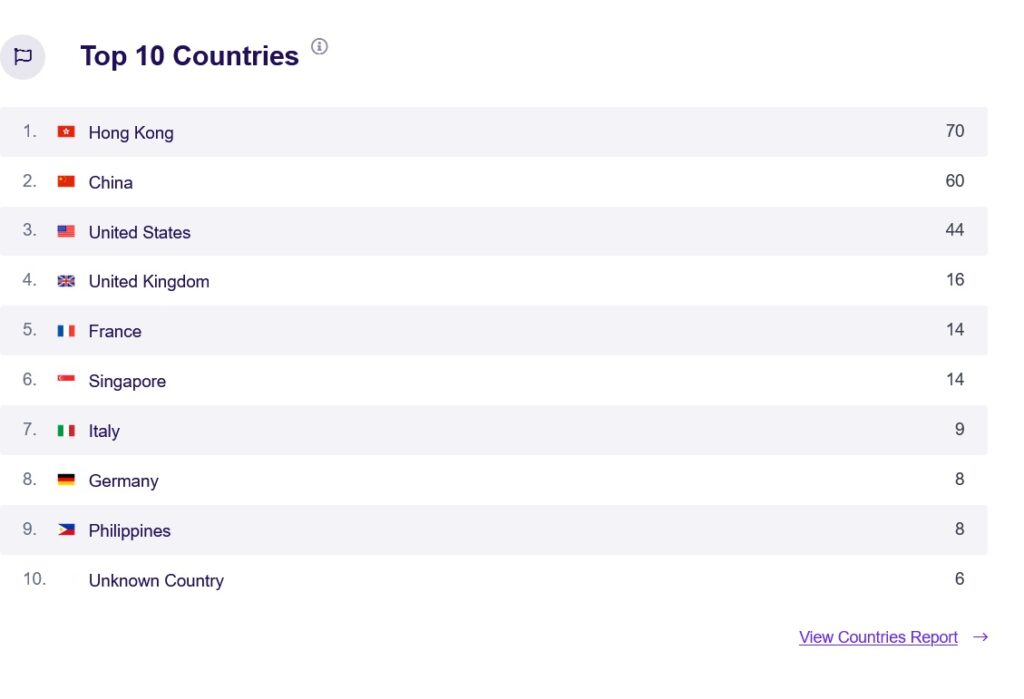
The Pipe Organ in China Project Website: Updates for March 2023
3 April 2023
We have received from our colleagues at Shanghai Pi Organ Industrial another nice photo of TAO1931. This photo, which was supplied by someone at St. Michael’s Cathedral in Qingdao, appears to have been taken in the 1940s, at least before late 1949 (see photo below).
An organ festival was held at the Gulangyu Organ Museum (now apparently the ‘Kulangsu Organ Arts Center’) and Xiamen Music School in Xiamen, Fujian Province. This took place over four days in late March, as part of the larger Kulangsu [Gulangyu] Music Week.
Organized and run by the organ department at Shanghai Conservatory, this featured FCW2017 in four concerts, two masterclasses, and an ‘organ course’. An event like this should be publicized more widely, but was not even known to the organ communities of the Hong Kong or Macau SARs, as far as we can tell.
The major academic event was a book launch for a Chinese translation (in simplified characters) of George Ritchie and George Stauffer’s 1992 Organ Technique: Modern and Early, by Shanghai Conservatory organ teacher Wu Dan (see photo below).
The Project apologizes for the late posting of the March updates, due to Prof. Urrows’ travel schedule.
Organs in the Census: 203
Hits this month: 1,067 (up 31% from last month)
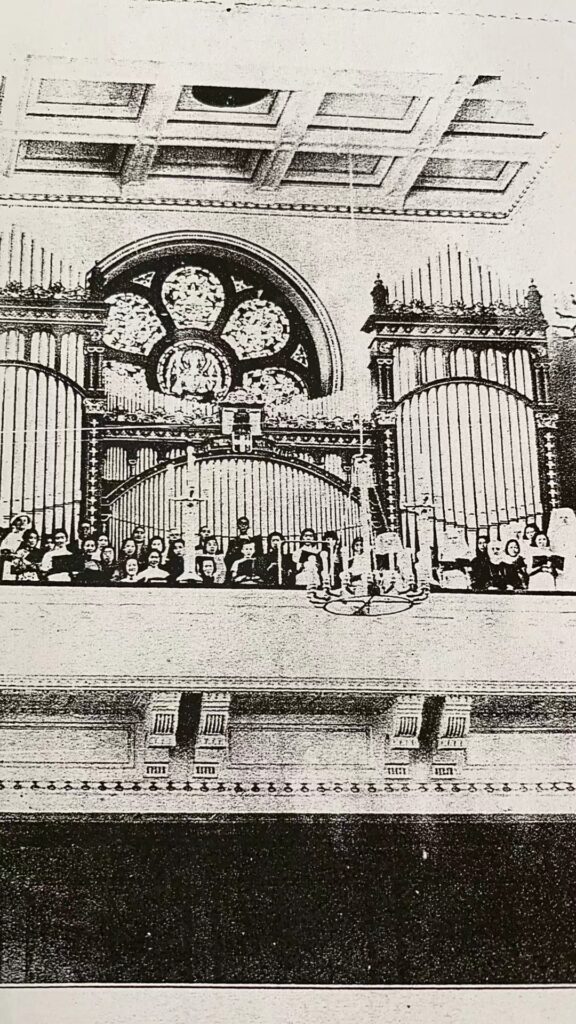
TAO1931, seen from the nave in a photo from the 1940s.
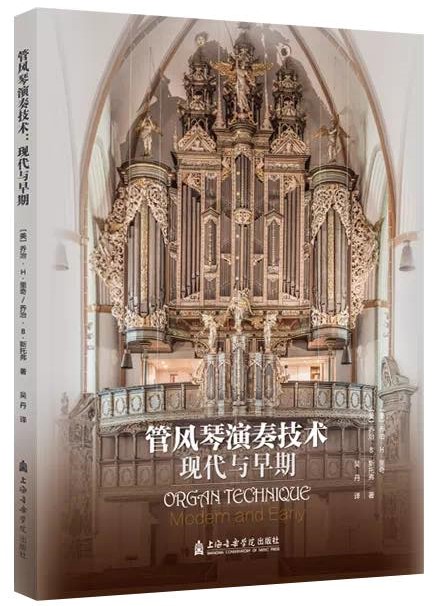
Chinese translation (by Wu Dan) of Ritchie & Stauffer’s Organ Technique: Modern and Early.
The Pipe Organ in China Project Website: Updates for February 2023.
26 February 2023
The Links page has been updated.
Minor updates have been made to HKG1984 and HKG1993. We appreciate the communication we received from our colleague Down Under, Carey Beebe.
Hits this month (899, of which 68% are new visitors)
Organs in the Census: 203
Picture of the Month: A team from Rieger dismantles NBO2018 in 2021. This vintage Hinners organ was damaged in a typhoon in late 2019. It is presently in storage, awaiting funding for its repair and re-installation. (Picture courtesy of Shanghai Pi Organ Industrial).
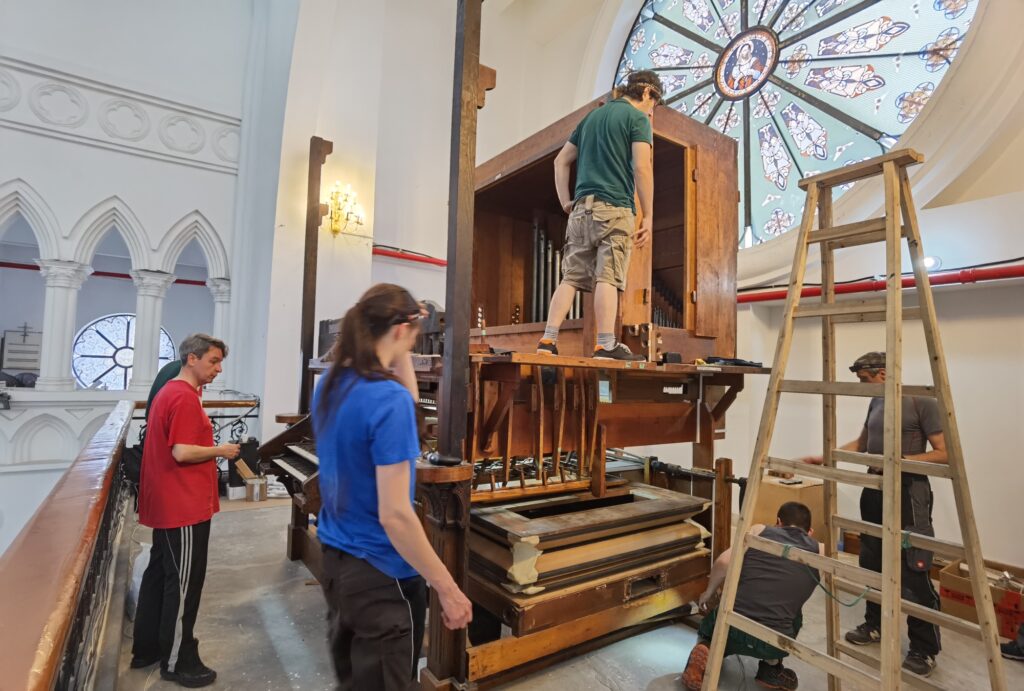
The Pipe Organ in China Project Website: Updates for January 2023.
31 January 2023
The Pipe Organ in China Project wishes all our friends and visitors a Happy Lunar New Year of the Water Rabbit.
gung hei faat choi 恭喜發財/xin nian kuai le 新年快樂 !
The Errata list for Keys to the Kingdom has been updated.
We have received a series of communications from Shanghai Pi Organ Industrial Co., Ltd, the agent for Rieger in Mainland China, and new data from the Rieger firm in Austria with information about several new and old organ projects and installations.
The page for NTN2021 has now been updated, with the stop list. We were also advised of the installation, back in the summer of 2016, of a two-manual practice/teaching instrument at the Shanghai Conservatory, SHA2016. The latter organ is something of an inadvertent milestone, as it is the 200th organ in the POCP Census.
Another four-manual concert organ, Rieger’s second installation in Zhengzhou, has also been added to the Census as well, ZNJ2021.
We were further advised of three new organs under construction for a facility in Beijing (concert organ, practice organ, and positive). When these instruments are up and playing, we will report on them again. Additionally, we now have information and the specs of two Rieger Truhenorgeln (practice/continuo organs) installed in Shanghai and Hangzhou in 2005 and 2006 respectively (SHA2005b, and HCH2006b.)
Particularly exciting among historical organs are a splendid photograph of the façade and console of the organ in St. Michael’s Cathedral in Qingdao (TAO1931), and a blueprint image of the façade of the later Rieger at Ichowfu (Linyi) ICF1936, along with the specs for both instruments.
Finally, we learned that the Wurlitzer theater organ sent many years ago from Australia to Xiamen’s Gulangyu Organ Museum will be renovated by Shanghai Pi Organ Industrial and Ian Wakeley, with a projected completion date in 2024.
And as if this were not enough about Rieger, for those of you with too much time on your hands we also accidentally discovered an online jigsaw puzzle of the console of SHA2005a https://www.jigidi.com/solve/b6s96sqs/rieger-organ-shanghai-china/
Hits this month: 1,109
Organs in the Census: 203
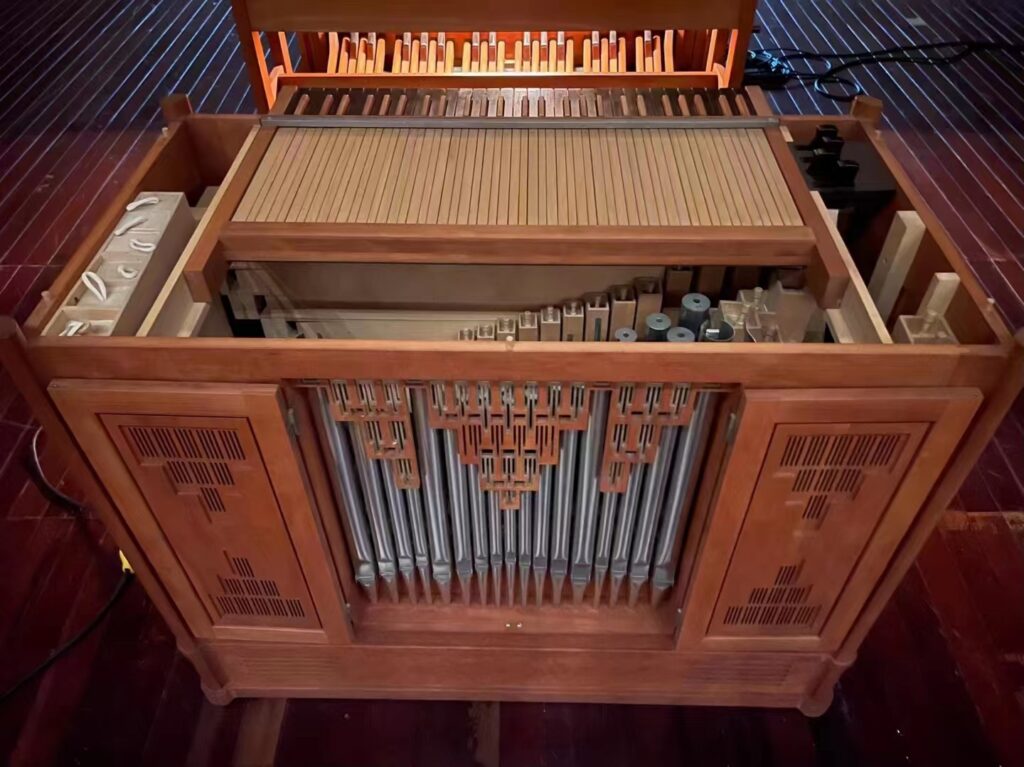
A look inside HCH2006b.
The Pipe Organ in China Project: Updates for December 2022
31 December 2022
There are no updates to The Pipe Organ in China Project Website for December 2022. Please see our top ten countries as of 31 December 2022!
We wish all our visitors and friends a Happy New Year 2023. 新年快乐!
Organs in the Census: 199
Hits this month: 581
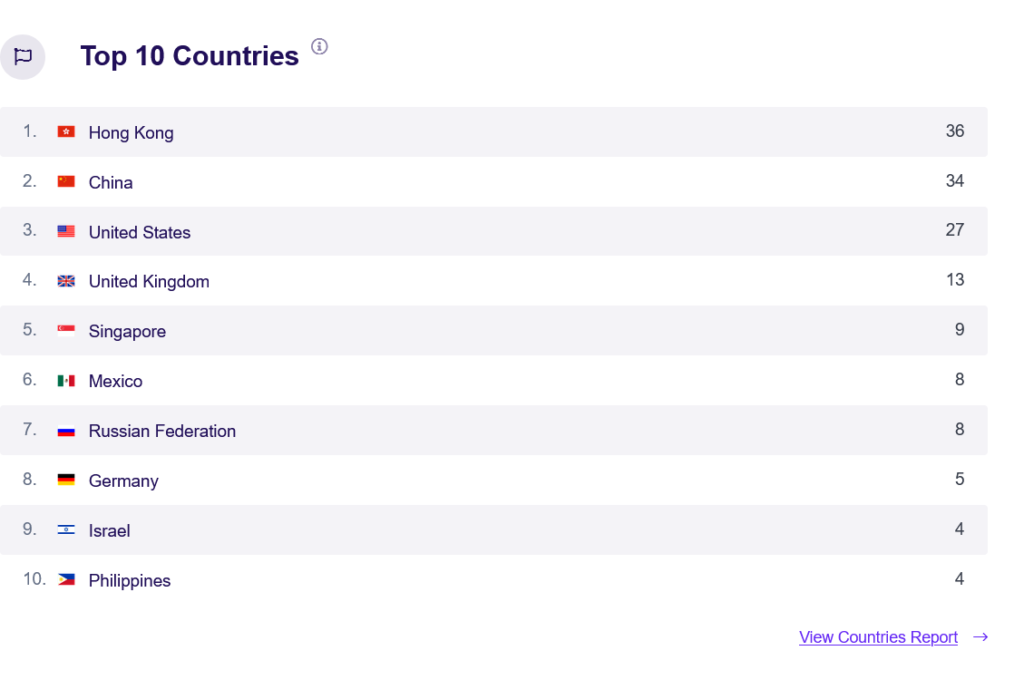
The Pipe Organ in China Project: Updates for November 2022
30 November 2022
There are no updates to organs this month, but two events to report on which involve aspects of the research carried out by the Project.
The Hong Kong Hymnos Festival, founded in 2020, hosted a concert by the choir, Vox Antiqua, on 12 November 2022 at the Chapel of St. Ignatius (seats 550!) at historic Wah Yan College, Kowloon. A program of works based on the information contained in the letters of Father François Ravary, recently edited and published by Prof. Urrows, was performed: Jesuita Cantat: Music from the Jesuit Missions of Shanghai ca. 1860. Music by Ravary’s teacher, Louis Lambillotte SJ (1797-1855), and by his friend Hippolyte Basuiau SJ (1824-86), as well as Alfred Roland, César Franck, and Ernest Gagnon was performed. The main work was the Messe solenelle en style grégorien du Ve mode by Lambillotte (1854), performed for the first time in Prof. Urrows’ reconstructed edition. Three readings were given of excerpts from Fr. Ravary’s letters.
Father Ravary was the ‘mastermind’ behind the bamboo organs of Shanghai, including SHA1857, SHA1858, SHA1859, SHA1861, SHA1862, and SHA1881, which he designed and which were constructed by Brother Léopold Deleuze (1818-65).
As Lambillotte, Franck, and Deleuze were Belgian, the concert was honored by the presence in the audience of the Belgian Consul General in Hong Kong, Mr. David Lomastro, and his wife, as well as Belgian Consul Eva Morre.
On another topic, Prof. Urrows was recently invited to Good Hope School at Choi Hung, Kowloon, Hong Kong. He writes:
“Two of my former students teach at Good Hope School, and among other things they have a strong program in Chinese music and a sheng (笙) ensemble there. Father Ravary loved the sheng, although he couldn’t decide what its relationship to Western instruments of a free-reed type was (the relationship is tenuous and has been greatly exaggerated; and the sheng has no connection at all to the Western pipe organ).
“The small, traditional sheng which Ravary knew is now a kind of folk instrument. Technology has taken over, and following Western models has created an entire family of sheng of different pitch levels (soprano, alto, tenor, bass). The larger ones, in some instances (there is no standardization yet of the design of large sheng) start to take on aspect of a ‘steampunk harmonium’. I enjoyed hearing, among other things, the Hungarian Dance No. 5 by Brahms, arranged for sheng ensemble! Below are a few photos of my visit, with explanatory captions.”
Top 10 countries, November 2022:
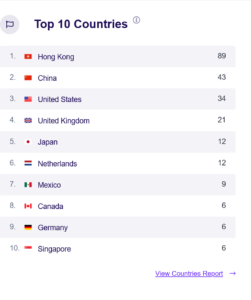
Organs in the Census: 199
Hits this past month: 861
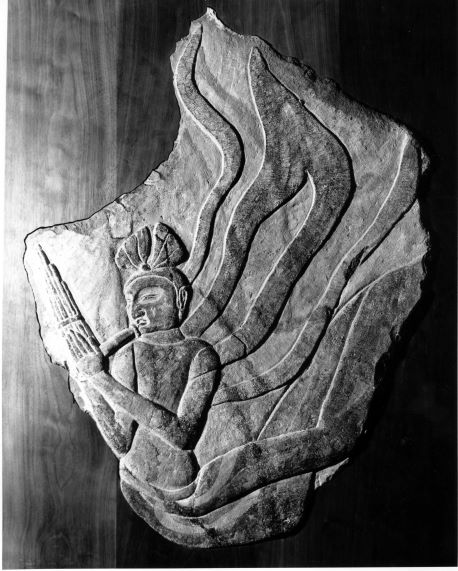
Apsara playing a traditional sheng, 8th C.
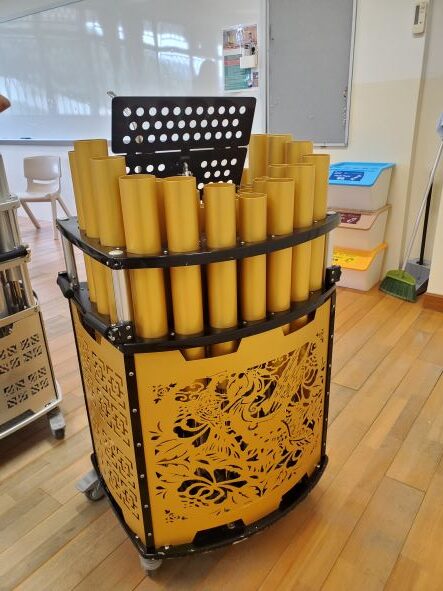
Alto sheng, front view. The upright tubes are resonators, not pipes.
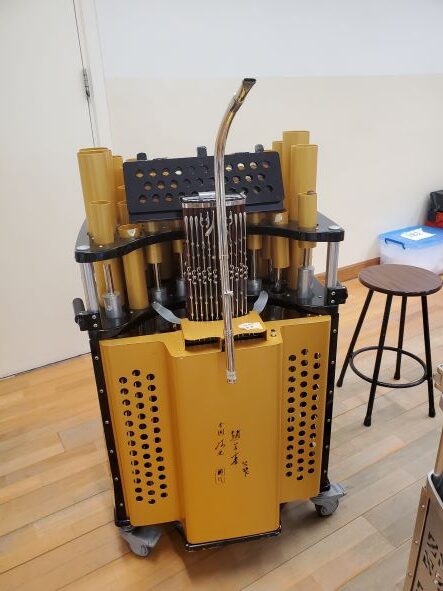
Back view, showing bocal.
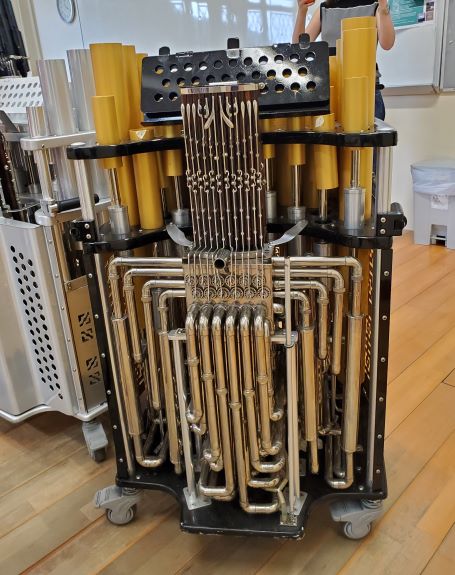
Back view, with panel removed showing elaborate wind tubes
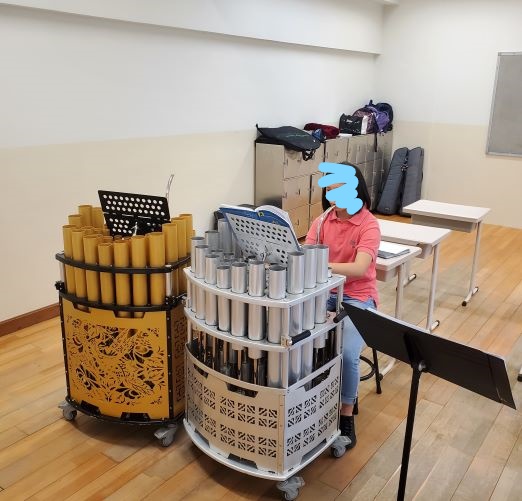
A student playing the alto sheng. The key system is the same as on the hand-held soprano concert sheng.
The Pipe Organ in China Project Website: Updates for October 2022
1 November 2022
The entry for HKG1919 has been revised, with additional information.
Photos of the Month: The Cathedral of the Immaculate Conception, Hong Kong. This is the second building on the original site at Wellington and Pottinger Streets, Central. The first church, built in 1843, burned in 1859 and was replaced by the building seen in this old photo. In turn, a new cathedral (the present building) was built further up the hill on Caine Road between 1883 and 1888.
The old church was pulled down in December 1886, and the site today is occupied by commercial buildings and the Lok Hing Lane Sitting-Our Area. Entrance to the cathedral was by a flight of steps up from Wellington St, approximately on the site today of Welland House (62 Wellington St.) At present, 64-68 Wellington St. (the Yu Wing and Kai Wah buildings) have recently been demolished for new development. As always in Hong Kong, there has been absolutely no attempt made to survey the site archeologically (see second photo), or to make provisions for the discovery of relics and other historical artifacts.
Access to the former Cathedral site (third photo) is now from Pottinger St. via the western end of Lok Hing Lane, or from the Wellington St. (north) entrance of Wo On Lane (fourth photo). The retaining wall along the western side of the passage abutting 60 Wellington St. is possibly of the same date as the second church. Behind this building, at the level of Lok Hing Lane, is a curious, cement-covered fragment of an old brick wall, which may also be a relic of the church (fifth photo).
This was the church of Bishop Giovanni Timoleone Raimondi PIME (1827-94), Vicar Apostolic of Hong Kong, still remembered today by a Hong Kong school named in his honor, and various other Raimondi place names. The church had no organ that is known of, but a harmonium and an organist who, according to the Bishop, “plays only waltzes and polkas, because he says he has no [scores of] sacred music.” In 1878, Bishop Raimondi obtained a subscription to the Cecilianist journal, Musica Sacra, and asked for some appropriate organ music, and also “for some masses by our serious music composers.” Such was musical life on the China Coast in the 1870s.
Recently, there was an interesting post on Facebook by the group, Hong Kong Heritages, about the cathedral.

The second Cathedral of the Immaculate Conception, Wellington St., Hong Kong, 1860s-70s.
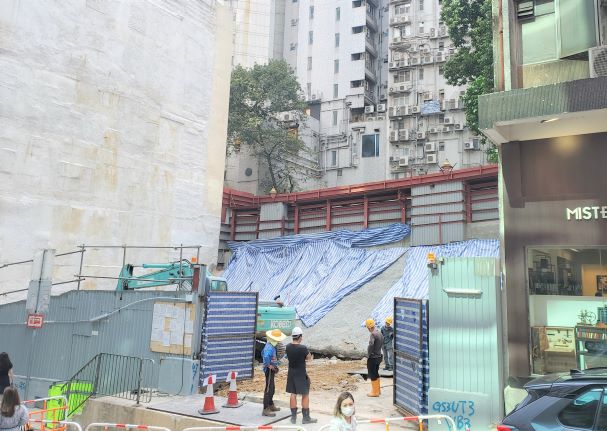
Construction on Wellington St., October 2022, on the site of the former cathedral. Wall of Welland House (62 Wellington St.) on the left.

Wo On Lane (north entrance) and retaining wall, possibly related to the cathedral.
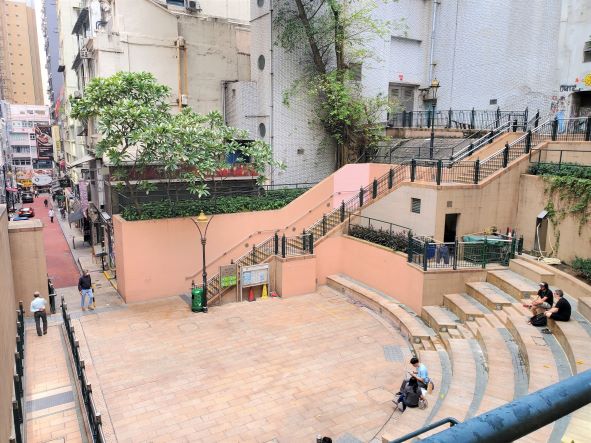
Lok Hing Sitting-Out Area (looking East), on the site of the crossing and altar area of the cathedral.
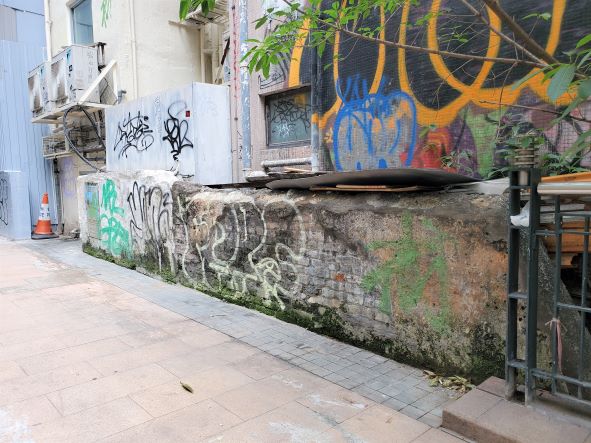
Fragment of a brick wall along Lok Hing Lane, possibly connected to the cathedral.
Organs in the Census: 199
This month’s hits: 1,080
The Pipe Organ in China Project Website: Updates for September 2022.
30 September 2022
Our colleagues at Casavant have informed us of an installation in Beijing, dating back to 2016 when they installed three other organs in the Chinese capital. This two-manual practice organ, now at CCOM, is a relocated organ originally built for McGill University in Montréal in 1962, and has the Census identifier PEK2016d.
HKG1860: “Brigands in the Church”, and the Disorganized Organ.
Prof. Urrows writes:
HKG1860 was the Bryceson and Son organ installed at St. John’s Cathedral, Hong Kong, and removed when the new Walker organ (HKG1887) was installed. After several years of debate over what to do with it, it was sold in 1890 to Union Church, to be reinstalled by Walker in the new church building on Kennedy Road. It served there until 1917 and the subsequent installation of the Blackett and Howden organ (HKG1917) that occasioned William Charlton Blackett’s personal visit to Hong Kong, from which place he never left.
This summer, I came across a fascinating news item in the Hong Kong Telegraph for 12 November 1892, that rewrites, perhaps, a little bit of this story. Apparently, on 11 November there was a robbery at Union Church, and the thieves “got away almost all the brass fittings and sound-tubes of the new organ now being fitted up in the chancel.” It is a little difficult to interpret this, as the organ was not new, and ‘sound-tubes’ could mean pipes, but these would not, of course, be made of brass. Perhaps these were conduits for a possible conversion to pneumatic action.
The news story (see below) goes on to say that “In consequence of this burglary the organ will not be in playable order for many months to come, it being necessary to send to the makers for the brass pipes and tubes that are – goodness knows where.”
Again, it’s not entirely clear just what was taken in the robbery. Does this mean that HKG1860, although sold to the new church in 1890, was not actually erected until the middle of that decade? Was Walker (still) doing the work in late 1892? And what of the report I found this summer, that in the Autumn of 1896, Vittorio Facchetti was invited to work on the Union Church organ at the time he was erecting his enormous masterpiece, HKG1896, over at the nearby Cathedral of the Immaculate Conception? And in what sense does this impact the fact that this organ was again completely rebuilt by the Hong Kong branch of S. Moutrie & Co. in 1907-08?
Finally, the police estimate of the total loss at the church, including the non-organ parts, was “$200”. This refers to the ‘dollar Mex’, which was the accepted currency at this time, and it appears this would have been equivalent to about 35 GBP in 1892. This relatively small sum (in the scheme of the cost of a pipe organ) suggests that not all that much was actually taken, but doesn’t resolve the question, when was HKG1860 finally ready for use at Union Church? Research never ends!
Organs in the Census: 199
Hits this month (September 2022): 701
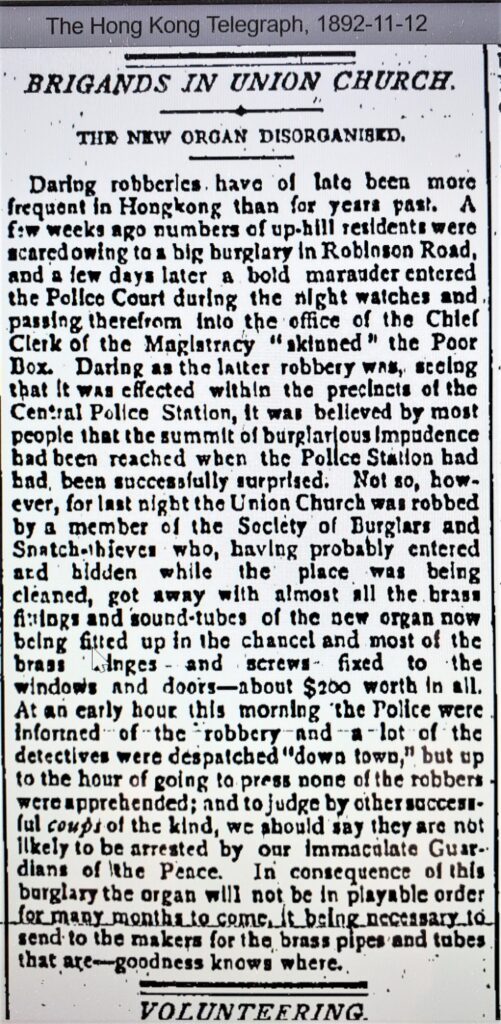
The Pipe Organ In China Project: Updates for August 2022
31 August 2022
Updates have been made to PEK1719, HKG1860, HKG1917, and HKG1919. Several new links have been added to the Links page.
The Hong Kong Chapter of the American Guild of Organists held a Summer Organ Academy for Adults in July and August. The final students’ concert was held on 21 August on HKG1986 at the Academy for Performing Arts, and included works by JS Bach, Boëllmann, Geoffray, Karg-Elert, Mathias, Felix Mendelssohn, Schack, Stanford, Louis Viérne, and René Vierne, played by 10 of the participating students.
After some period of debate, The Project has decided to include the playable pipe organs presently at the Gulangyu Organ Museum in Xiamen, Fujian Province, in the Census (FCW2017 was already added some time ago.) While these organs have nothing historically to do with China (other than that they are found at present in Xiamen), the fact that they are present is enough, we have concluded, to include them in the Census, just as those that no longer exist, or which have left China, are similarly included. As with the relocated organs in Beijing, Tianjin, and Ningbo, these organs will receive a Census date reflecting their installation in China when confirmed, and not that of their original construction. We have added FCW2005 to the Census this month. The other two pipe organs of which we are aware (a Mackenzie, Lee & Kaye, originally built in 1874 and enlarged several times, and a Wurlitzer Model H of 1928, both ex-Australian installations), have not yet been confirmed as actually up and working at the museum.
The discovery of HKG1896 this summer led Prof. Urrows to do a bit of research on Oscar Crispim Baptista (1861-1929), organist at the Roman Catholic Cathedral of the Immaculate Conception from at least 1888 to his death in 1929. He reports as follows:
As far as I can tell, Baptista was born in Macau, which means that he was a Portuguese national. It is of course possible that somewhere in his family there may have been some Japanese or Chinese forebears (the China coast term, ‘Portuguese’, commonly meant in the 19th and early 20th centuries a person of mixed ethnicity). But just how long his family had been settled there is at present unknown. Baptista turns up on the 1895 juror list for Hong Kong, living on Elgin St. in present-day Central, although it is known that once he married, he moved to Hart Avenue in Kowloon. At any rate, he seems to have come to Hong Kong as a relatively young man.
Baptista worked for a brokerage company, Gibb, Livingston & Co., and what musical training he had is unrecorded. Baptista is the “R. Oscar” mentioned by Vittorio Facchetti as one of the ‘collauditori’ (testers) of the completed 1896 organ at the Roman Catholic cathedral. Why Facchetti referred to him in this way is not known, but he may have thought he was a priest (‘R.’).
His brief obituary notice (in the South China Morning Post, 11 October 1929, see below) shows that Baptista died in Macau. But he was in fact buried in Hong Kong. I might add, that I found that I share a birthday with Baptista, 25 October. This is the Feast of St. Crispin (and St. Crispinian), whence Baptista’s interesting middle name, Crispim. I only discovered this by dragging myself in the heat of a Hong Kong summer to St. Michael’s Cemetery in Happy Valley, and locating Baptista’s tomb (and that of his wife, mother-in-law, and only son, see photos below).
Organs in the Census: 198
Hits this month (August 2022): 619
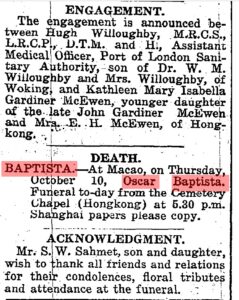
Obit for Oscar Crispim Baptista.
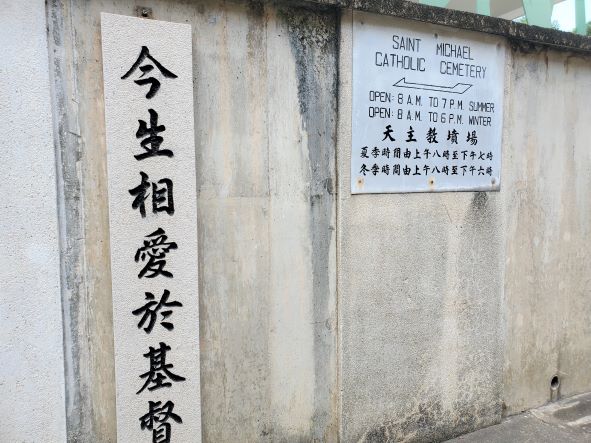
St. Michael’s Cemetery, Happy Valley, Hong Kong
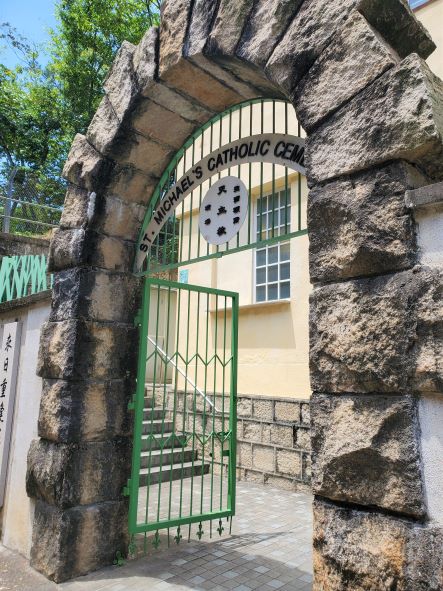
Gate at St. Michael’s Cemetery
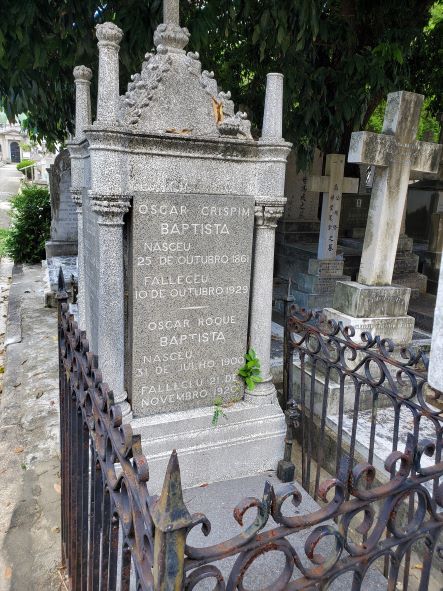
Baptista family tomb, St. Michael’s Cemetery.
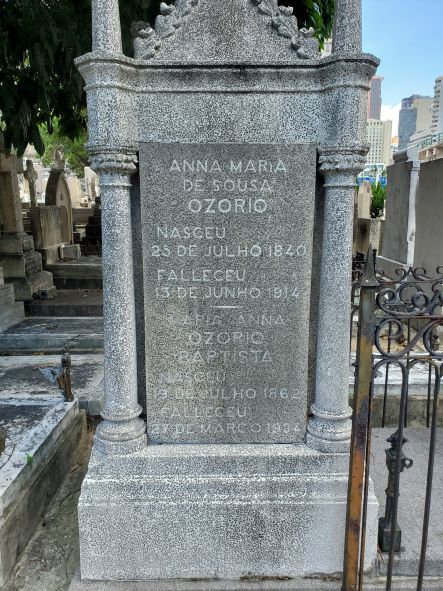
Names of Baptista’s mother-in-law and wife.
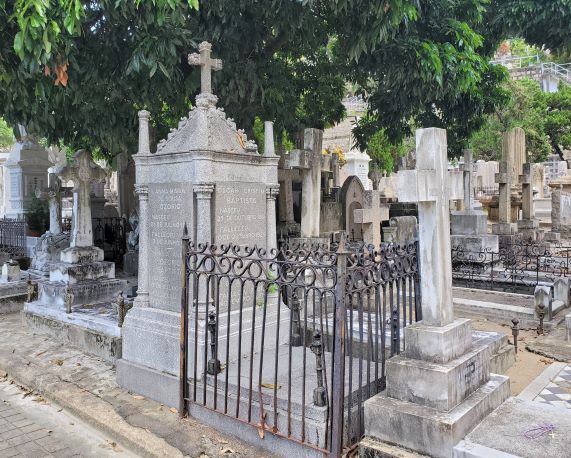
Baptista plot, St. Michael’s Cemetery.
The Pipe Organ in China Project Website: Updates for July 2022.
31 July 2022
HKG1896: with the discovery of this Bianchetti e Facchetti organ in the Roman Catholic Cathedral in Hong Kong, the old page for the spurious HKG1888 has been kept online, but substantially altered; and necessary changes have been made to HKG1921 and a few other posts. Prof. Urrows posted a two-part blog essay, “The Phantom of the Organ Loft”, during July to explain the complex situation with these organs (see What’s New). The Project also appreciates the help of Sig. Massimiliano at organibreschiani.it for help with unraveling this complicated story. https://organibresciani.org/index.php
In yet another exciting development, a previously-unrecorded organ (HKG1872) by William Hill & Son of London has been located, and presumed installed in Hong Kong in 1873 in St. Peter’s Church, West Point. This organ is the second (or third) pipe organ known to have been installed in the British Crown Colony, and fills a gap in the record between the Bryceson (HKG1860) and Walker (HKG1887) organs at St. John’s Cathedral. The project appreciates the help of the British Organ Archive, Hannes Ludwig, and John Richard Maidment, for their help in locating this installation.
Word has also reached The Project about a planned new pipe organ for the Shenzhen Conservatory of Music (est. 2020, and operated by the Chinese University of Hong Kong.) Further details will be posted when we have them.
The China Top 10 Pipe Organ List:
Statistics, statistics, statistics: there are at present 197 organs in the POCP Census, with several pending installation which has been delayed by the COVID epidemic.
This month we looked at the breakdown of organ locations and numbers, and here are the Top Ten locations for all historical and current pipe organs in China, along with the date of the earliest-known installation or construction.
|
Beijing (PEK) |
50 | 1611 |
| Hong Kong (HKG) | 45 | 1847 |
| Shanghai (SHA) | 24 | 1856 |
|
Macau (MAC) |
12 | 1600 |
| Tianjin (TJN) | 9 | 1904 |
|
Fujian/Fuzhou (FCW) Tie with Qingdao (TAO) |
6 |
1631
1909 |
| Guangzhou (CAN) | 5 | 1678 |
| Hangzhou (HCH) | 4 | 1919 |
|
Chengdu (CHD) Tie with Shenyang (MKD) |
3 |
1910
1912 |
The sum of these 11 locations (there are two ties, each counted together as 1.5) equals 167 of the 197 pipe organs in the Census, or 85% of all the pipe organs ever known to have been installed in China. Only four reach double digits. All other places in China with pipe organs have only 1 or 2 reported. The earliest date of first installation in this top ten list in MAC1600, the latest HCH1919.
This list makes no distinction between organs that exist, or those that don’t exist anymore. If the data were sorted into pre- and post-1949 pipe organs, and excluded those that either no longer exist, have left China, or are pending installation, the results would be, and be sorted rather differently.
Photo of the Month: While on the topic of Top Ten statistics, here is an interesting screengrab from 30 July 2022. This shows the top ten locations from which hits on the website come, according to Google’s Exact Metrics (all data on this chart is from Google, not from the POCP.) We were rather surprised to see Indonesia at #3, especially as there isn’t a very strong pipe organ culture there at present. We will be keeping track of these statistics, and post again if any particularly interesting trends become evident.
Organs in the Census: 197
Hits in July 2022: 769 (66% new visitors; 34% returning visitors)
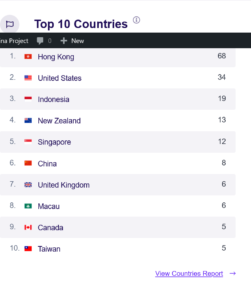
The Phantom of the Organ Loft, Part Two: HKG1896 and its dedicatory recital.
7 July 2022
For Part One of this series, see What’s New for 6 July 2022.
Prof. Urrows writes:
Because in-depth accounts of organ inaugurations in China are fairly uncommon, it’s worth presenting the Hong Kong Daily Press report (29 August 1896) of the first hearing of Bianchetti and Facchetti’s HKG1896 in full. I have worked on identifying the people mentioned here, especially for the benefit of those who do not live in Hong Kong or have any historical knowledge of people and corporations in the former British Crown Colony (1842-1997).
James Orange (1856-1927) was an architect/engineer, and after working for the Hong Kong Brick and Cement Co., he was a partner in the Hong Kong architectural firm Leigh & Orange, founded 1874 and still in business. The firm built many famous buildings and waterworks in Hong Kong.
George Grimble (1867-1933) was born in Hong Kong and worked in what we now call ‘logistics’. Like James Orange, he had a ‘day job’. As reported here, he was a student of organist Frederick (F.A.) Sangster (?-1902), who was the first titular organist of St. John’s (Anglican) Cathedral in Hong Kong. Sangster in turn was a student of Sir Frederick Gore Ouseley (1825-89), who wrote the famous anthem, “From the rising of the sun”, and who had recommended Sangster for the Hong Kong position. Grimble was organist at Union Church, which I think is how Sig. Facchhetti came to be asked to do repair work on the Bryceson organ (HKG1860) in that church. He also is reported playing at St. Peter’s West Point (to be the topic of an upcoming post), and was a Mason as well, and the local lodge’s ‘grand organist’. This raises the interesting question as to whether the Masons in Hong Kong had a pipe organ.
Fr. Angelo Cattaneo (1844-1910) was a PIME missionary who had worked in Mainland China before being called to Hong Kong in the 1880s as procurator of the Diocese. He was later (1905) made a Bishop and Vicar Apostolic of Southern Henan (based in Hankou, part of present-day Wuhan, where the COVID epidemic started!)
‘O. Baptista’ was Oscar Crispim Baptista (1861-1929), a Macanese musician who worked for the trading house of Gibb, Livingston, & Co. He was organist at the Cathedral from its opening in 1888 well into the 20th C. (see pic below). After his death, his talented daughter Aurea took over as cathedral organist.
Lane Crawford Ltd. is a department store in Hong Kong, founded in 1850 and still in business today. G.L. Duncan was an employee in a middle management position in the 1890s. Since Lane Crawford handled furniture sales, he probably had some knowledge of cabinetry and carpentry.
Of the six singers, two were obviously Portuguese: but Carvalho and Graça are very common names, difficult to identify. The Portuguese ‘Club Lusitano’ had held fund-raisers for the organ starting in 1889. The Club is still active in Hong Kong, and The Project plans to ask if they have any records from this period, despite a lot of things such as paper records having been destroyed in 1941-44, during the Japanese Occupation of the colony. Of the two Dutch singers, A.C. Van Nierop worked at some point for the brokerage firm Benjamin, Kelly, and Potts in Shanghai before moving to Hong Kong. Kraal may actually have been born in Macau to Dutch parents, but this is still uncertain (I have unearthed a Lavinia Eulalia Krall, born in Macau 14 March 1853, which is about the right date for a sister of the singer.) I have not uncovered anything about Mr. Sliman who was probably Scottish, though Sliman is derived from a Dutch name. All these people may just have been members of the cathedral’s choir. Mrs. Hagen’s name turns up in numerous concert reviews in Hong Kong newspapers of this time. She was married to an Edward James Hagen, who was a partner in Stolterfoht and Hagen, “agents and commission brokers”. He died shortly after this concert, on 26 February 1897, and is buried in the Colonial Cemetery. His widow continued as a singer in Hong Kong, especially in performances at St. John’s Cathedral.
Finally, the reviewer seems to have got some things wrong. The organ was a two-manual instrument, and his complaints seem to be oblivious to an obvious hypothesis: that only the Great manual of the organ had been installed at this date. The organ, according to research in Italy, was built in 1895, so it could not have arrived in 1894. It probably came in early 1896, and sat unerected while the Lane Crawford crew tried to figure out what to do with it. A sentence in the review was transposed by the typesetter, and I have silently fixed this error here. The reviewer was also unaware of the existence of traditional Portuguese guitar/mandolin ensembles (which he calls here an “orchestra”), and these are still to be found today, even in Macau. The music of James Orange, and Fr. Cattaneo, seems to have disappeared at the present date, but it is surprising to see several recently-composed works on the program as well.
Organ Recital at the Roman Catholic Cathedral – Hong Kong Daily Press, 29 August 1896
On Thursday evening [27 August 1896] an organ recital was given at the Roman Catholic Cathedral to celebrate the opening of the new organ. The cathedral was crowded and the general opinion was that the recital was a great success. The organ is a low-priced single manual and it was made in Italy. It has, considering the comparatively small sum of money spent upon it, and exceedingly good tone, and a bargain was certainly struck when the purchase was made. The instrument was sent to the colony over two years ago and with it came complete plans of each stage of organ building, which were sent to Messrs. Lane, Crawford & Co. Mr. [G.L.] Duncan was deputed to erect the organ, but unfortunately, he was unable to finish the work because many of the pipes were broken and twisted in transport. It was therefore decided to send to Italy for a special man, and Mr. Vittorio Facchetti, of Brescia, came here to complete the erection of the instrument. He had many difficulties to overcome in the work, and it says much for his ability that the organ now possesses such a good tone; in fact, his work has been so much admired that he was appointed to repair the organ at the Union Church [HKG1860].
The recital opened with a Grand March Offertoire in F which, was composed by Mr. [James] Orange and arranged for the organ by Mr. [F.A.] Sangster, the late organist at St. John’s Cathedral. The piece was played by Mr. G[eorge] Grimble, who is to be congratulated upon his excellent performance, more especially as the music was arranged for an organ with two manuals. The remark concerning Mr. Grimble’s difficulty in playing on a single manual applies of course to Mr. Cattaneo [PIME] as well. Every one praised Mr. [Angelo] Cattaneo’s playing; indeed, he really astonished most of his friends, who were not aware that he was such an accomplished organist. It was indeed a first-class performance that Mr. Cattaneo gave, particularly in the Monastic Coro, in which the flute stop was splendid. Mr. O. Baptista, the organist at the cathedral, also presided at the instrument and gave satisfaction.
The vocal selections were, for the most part, well rendered. Miss Carvalho sang exquisitely, and Mr. C.H. Graça was also in good voice, but the accompaniment was too soft. Mr. Sliman was evidently suffering from a cold and should not have sung. Mrs. Hagen gave Mascagni’s Ave Maria in excellent style, and the duet singing of Messrs. Van Nierop and Kraal was much enjoyed. A number of amateurs gave two selections on mandolins and guitars. They played well, but it would have been better if chorus singing had been substituted. It should be added that the cathedral possesses exceptionally good acoustic properties, perhaps the best in the colony; and the organ well-filled the building, while the vocalists could be heard very distinctly. We must congratulate our Roman Catholic friends on the possession of such a beautifully-toned instrument. We can only say one thing against it, and that is, it is a pity it does not possess fewer stops and a double [second] manual. The following was the programme:
Grand March Offertoire in F (composed for the occasion), by Mr. J[ames] Orange: Mr. G. Grimble
“Inflammatus” – for soprano, from Rossini’s Stabat Mater: Miss Carvalho
Barcarolle – for orchestra of mandolins and guitars: Lady and Gentlemen Amateurs
Monastic Coro, in distance; and Duet for Flute and Clarionet, [arr.?] for organ, by Maestro A. Cattaeno
Salve Maria – for Baritone, by [Saverio] Mercadante: Mr. C.H. Graça
Pastorale – J.S. Bach: Mr. O. Baptista
[The] Nun’s Prayer – [Charles] Oberthür [op. 54]; Mr. O. Baptista
Offertoire from the Messe de Mariage – Théodore Dubois: Mr. G. Grimble
“Cujus animam” from Rossini’s Stabat Mater: Mr. D.K. Sliman
Serenade – for orchestra of mandolins and guitars, by [Charles] Acton: Lady and Gentlemen Amateurs
Ave Maria – for soprano by [Pietro] Mascagni: Mrs. Hagen
Qui tollis, and Qui Sedet, for Bass [solo]; Laudamus te for Tenor [solo]; Christe [eleison], duet for Tenor and Bass, from Mass No. 8 by A. Cattaneo: Messrs. Van Nierop and Kraal, accompanist Maestro A. Cattaeno
Solo for Tromba [and organ?], and Marcia Finale, for organ, by Maestro A. Cattaneo
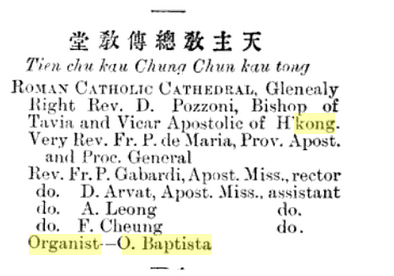
1908 entry for the Cathedral of the Immaculate Conception, Hong Kong, in the “Directory & Chronicle for China &c.”
The Phantom of the Organ Loft, Part One: HKG1888 and HKG1896
6 July 2022
‘Questions about the sources of our knowledge [have] always been asked in the spirit of: ‘What are the best sources of our knowledge—the most reliable ones, those which will not lead us into error, and those to which we can and must turn, in case of doubt, as the last court of appeal?’ I propose to assume, instead, that no such ideal sources exist—no more than ideal rulers—and that all ‘sources’ are liable to lead us into error at times. And I propose to replace, therefore, the question of the sources of our knowledge by the entirely different question: ‘How can we hope to detect and eliminate error?’”
Karl Popper, ‘Conjectures and Refutations’.
Prof. Urrows writes:
All sources are liable to lead us into error at times. People who know me, know what a profound influence the ideas and writings of the 20th C. Anglo-Austrian philosopher, Karl Popper (1902-94) have been in my life. Here, The Project has to turn to Popper to explain the removal of one organ from the Census (although it will continue to have a ‘phantom’ presence, because it is described at length in Keys to the Kingdom), and the addition of a newly-documented instrument that effectively and physically takes its place.
The error involves HKG1888, the G.W. Trice organ which we have placed for 30 years at the Cathedral of the Immaculate Conception in Hong Kong. The source which led us into this error, is a history of the Trice organ company of Genoa, La Fabbrica d’Organi di William George Trice, 1881-1897, by Maurizio Tarrini (Savona: Editrice Liguria, 1993). From this book, comes the information that Trice (1848-1920) prepared, and then revised a proposal for an organ for the new Roman Catholic Cathedral in Hong Kong in 1882 (although the Cathedral was not opened for another six years), at a cost of 22,000 francs. In the end, it now appears to have proven to be too much money for the Apostolic Prefecture of Hong Kong to raise (Hong Kong did not become a diocese until 1946). In any event, the procurement of the organ was from the start a competitive tender exercise, under the direction of Fr. Bernardo Viganò (1837-1901). Trice’s progetto, then, was only one of the bids received; and even after the Cathedral was opened, on 8 December 1888, there was to be no organ (except, perhaps, for a harmonium) for another eight years.
Late last month, in going through the Hong Kong newspaper, Hong Kong Daily Press, for 29 August 1896, I came across an account of the dedication of the organ that was finally—only in 1896—installed in the Cathedral. I will give an annotated version of this news article in Part Two. On looking into this further, I found that almost contemporaneous with my own inquiries at the Diocesan Archives in Hong Kong about six years ago, a group of several organ historians in Brescia, Italy, had also made inquiries and had come up with data which for some reason I never saw. This is what actually happened:
The organ for the Roman Catholic Cathedral in Hong Kong, then, was in fact built by the firm of Bianchetti e Facchetti, of Brescia. It was a two-manual and pedal instrument with 55 stops, and thus the largest organ installed anywhere in China until HKG1989, nearly a century later, and the largest instrument Bianchetti e Facchetti ever built. It was later rebuilt by Blackett and Howden about 1921, when and additional manual and five stops were added, bringing the total to 60/III. The organ, according to the 1896 news report, was shipped to Hong Kong in 1894 (this may be a mistake; it appears they began building it in 1895, and in fact it arrived sometime in early 1896). On opening the packing cases, it was found that most of the pipes and the rest of the organ had been damaged in transit. Local attempts to erect the organ failed as a result, and Vittorio Facchetti (1859-1931) himself had to come to Hong Kong in mid-1896 to repair the damage and finally erect the organ. It was tested and approved by George Grimble (1867-1933, organist at the interdenominational Union Church on Kennedy Road), Fr. Angelo Cattaneo (1844-1910, procurator of the Prefecture, and an experienced organist and composer), and Oscar Baptista (1861-1929), a Macanese who worked for Gibb, Livingston, & Co., and who had been organist at the cathedral since its opening in 1888. In a 1908 Elenco of his recent installations (see below), Facchetti proudly mentioned that HKG1896 had been “eseguito da me in persona sul luogo” – ‘installed by me personally on the spot.’ Facchetti and Grimble seem to have got on well, and Facchetti was then asked and made some repairs to the organ at Union Church (HKG1860) at this time.
For the dedicatory concert on 27 August 1896 (see Part Two), it appears that about half the mechanical action organ was ready, with the Grand’ Organo (Great) and Pedal divisions in place, and the Organo espressivo (Swell) installed at a later time, probably by early 1897. We may hypothesize that Facchetti had to send back to Italy for additional parts and pipes, all of which greatly delayed the work. The full specs are now available at HKG1896 (a date I have chosen for ‘first report’, and certainly this was the date of the dedication of the instrument, no matter that it may not have been fully erected at this point.)
The discovery of this instrument means that certain assumptions about the succeeding instrument by Blackett and Howden (HKG1921) have to be reconsidered; and that the organ case now standing in the Cathedral is unlikely to be the original Bianchetti e Facchetti case. It has ducts for pneumatic tubes, and doesn’t look anything like the surviving organs from the Italian builders. It was probably built by Blackett and Howden, perhaps even in Hong Kong from locally-sourced woods. This is a new point of inquiry for The Project.
In Part Two, I will present the 1896 review of the dedicatory concert with annotations (the journalist doesn’t seem to have got all his facts right.)
The Project is most grateful to Sig. Massimiliano of Organibresciani.it for his help with documenting this research and this organ, and whom we thank for the images below.
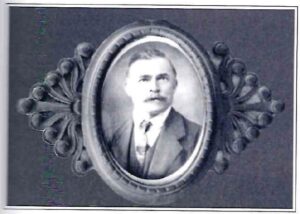
VIttorio Facchetti (1859-1931). Photo courtesy of organibreschiani.it.
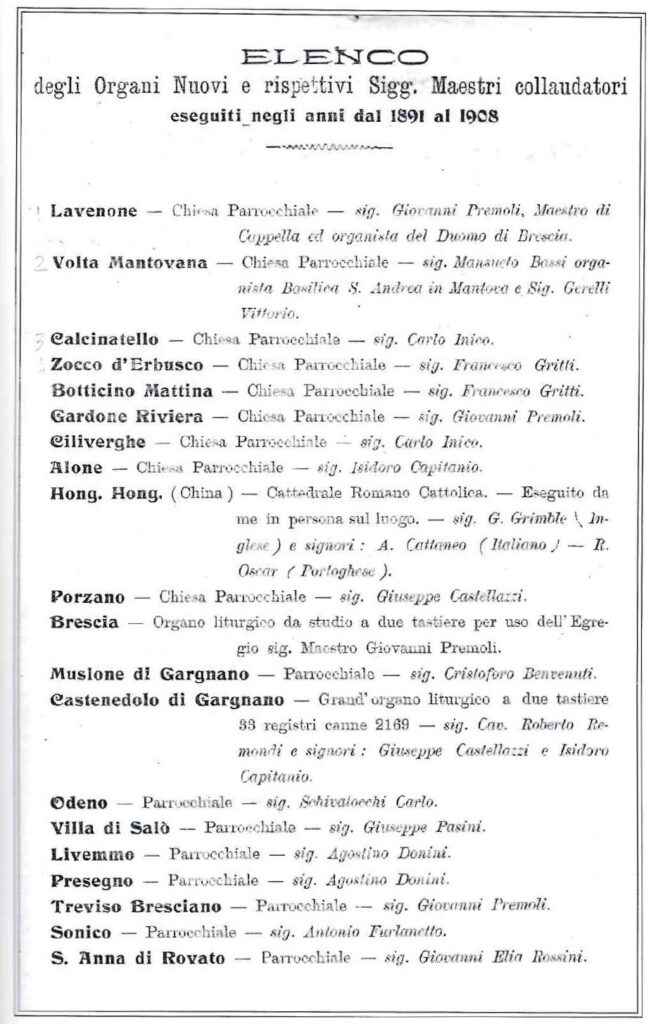
Facchetti’s 1908 “Elenco”, with the erroneous “Hong.Hong.” location of HKG1896.
The Pipe Organ in China Project Website: Updates for June 2022.
30 June 2022
June 2022 marks the fourth anniversary of the opening of The Pipe Organ in China Project Website, and for once it has been a busy month at The Project.
The page for HKG1860 has been updated, with new information and an interesting news clipping from 1867.
A major discovery this month involves the installation previously numbered as SHA1883b. It turns out that this organ was installed much earlier than 1883, and we have located a report of the instrument dated 1865, which means that it was probably built by Henry W. Knauff, Sr. (and not by his son, Henry Jr.). Even this date is really too late: we know from the same report that it was installed somewhat earlier than this, and was only moved in 1865 from the organ gallery of the Church of Our Savior, Hongkou, Shanghai, to a place on the left side of the chancel during a renovation of the building after the Taiping Rebellion (1850-64). A much-later photo of the organ in this location has also surfaced, one that shows that it was a two-manual instrument with about 12 stops. In consequence, it has been renumbered SHA1865 in the Census (date of first report).
The Project is also working on confirming the installation of two hitherto unknown pipe organs in Hong Kong, one by William Hill & Son, of London, apparently ordered and sent to Hong Kong in 1872, and the other by the Italian firm of Bianchetti & Facchetti of Brescia in 1896. Further details will be forthcoming.
The page for HKG1980 has been updated, after an inspection of the dismantled organ by Prof. Urrows earlier this month in a warehouse facility in Kowloon, Hong Kong. The specs are finally known and reported, including the fact that it is (only) a one-manual instrument.
Pages for HKG1917, as well as HKG1979 and its successor, HKG2012, have also been updated, based on new information.
A blog post by Prof. Urrows was posted on 10 June, concerning an early report in English of SHA1857, written by the American Episcopal missionary, Edward W. Syle.
JL Weiler Inc. the Chicago-based firm specializing in organ rebuilding and restoration, has reported that their work on the rehab of PEK1920 has been completed, and now everything is being sent to Casavant for further work and re-erection. Visitors to this website may recall the announcement of the rebuilding of the 1920 Kimball organ at PUMC from the December 2021 Updates. Photos of the newly-provided console (the original one was destroyed, along with the reproducer, by 1966 at the latest) can be seen on Weiler’s Facebook page: https://www.facebook.com/jlweilerinc/posts/3292526844310325
Photo of the Month: Aristide Cavaillé-Coll writes to Msgr. Alphonse Favier CM, Grand Vicar of Beijing, in February 1889, about an orgue du chœur for the Beitang (North Church):
“Paris, 22 February 1889.
P.S. to the letter of 19th February:
I’ve taken advantage of a few days left to us before the departure of the mails, to design a small organ for which I attach here the plan along with the specifications.
On one side [of the plan] we have shown half of a swell box, while on the other side the [alternative] decoration of the façade with the pipes. One can thus make a case with pipes decorating the front, or more simply enclose it all in a swell box. [To save money, Favier may have told Cavaillé-Coll that he planned to make the case in Beijing, as had been done with PEK1888].
At all events, it would be best [for you] to wait for the arrival of the organ before building the case.
The total cost of making this organ with a case would be 5,000 francs; without a case, 4,000.
A[ristide]. Cavaillé-Coll.”
In the end, Bishop Favier argued the price of PEK1890 down to 3,000 francs, but it is not known if the case (without the expression box) was made in Paris, or in Beijing. The latter seems more likely, given the bargain price.
The original letter, along with the plan, is at the Archives Lazaristes (Archives of the Congregation of the Mission) in Paris.
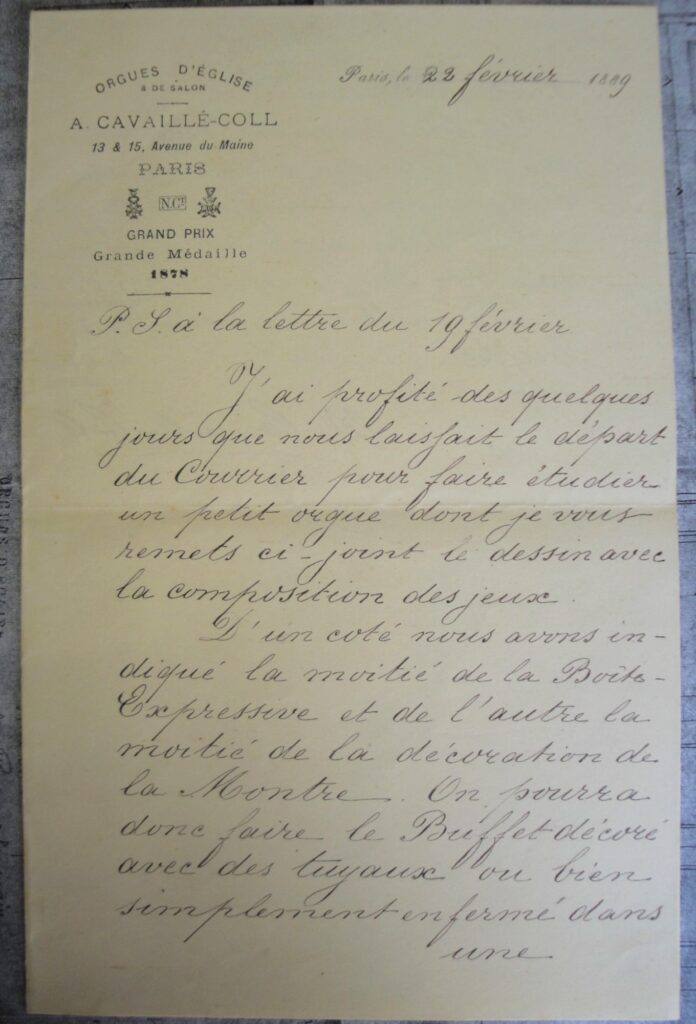
Organs in the Census: 195
Because of changes with WordPress and our domain host, we cannot get statistics for hits beyond the past 30 days any more. For the record, there were 824 hits in June. However, some other interesting data seems to be available now, and we will begin to present this in July updates. Thanks to all our visitors for understanding.
An early English-language account of SHA1857: Edward W. Syle and ‘The Bamboo Organ of Tungkadoo’
10 June 2022
Prof. Urrows writes:
Readers of Keys to the Kingdom, and some visitors to this website will understand how important an installation SHA1857 has been to The Pipe Organ in China Project. A casual inquiry about this instrument led to the creation of The Project in 1989, and it continues to be our mascot, our totem, our starting point and origin.
Recently, while looking for something else, I came across a news clipping that appears to contain one of the earliest English-language mentions of SHA1857. This appeared in an issue of the newspaper, The London and China Telegraph, which was published in London and ran from 1859 to 1921. The paragraph in question (quoted from an earlier issue of the Boston Evening Post) appeared in the issue for 28 July 1867 (it was a weekly paper), and so ten years after the construction of SHA1857. Here it is:
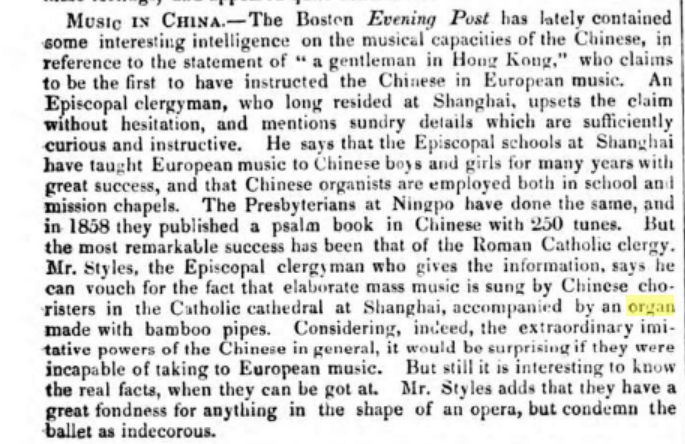
The first thing I noticed was the name of “Mr. Styles, the Episcopal clergyman.” Just as some of my Roman Catholic readers have been shocked to discover that Fr. Ravary and Br. Deleuze made many visits to Holy Trinity (Anglican) Church to inspect and study the two-manual and pedal Gray and Davison organ (SHA1856) while planning SHA1857, in like manner it seems that the reverend gentleman of the American Episcopal Church mentioned in the newspaper was familiar with the musical activities of the Jesuits in Shanghai, which is of course the subject of my recent book, François Ravary SJ and a Sino-European Musical Culture in Nineteenth-Century Shanghai (CSP, 2021).
Investigating further, I found out that “Mr. Styles” was actually the Rev. Edward W. Syle (1817-90), born in England, but moved to the United States where he pursued his university education (Kenyon College, 1840-43) and attended theology school (Virginia Theological Seminary, 1844). Syle and his wife went out on the China mission in November 1845. Syle had the honor of laying the cornerstone of Holy Trinity Church in 1848. He was certainly on good terms with the Roman Catholic clergy in Shanghai, and mentions in his journal a visit to the newly-completed ‘Tungkadoo’ (dongjiadu, the Cathedral Church of St. Francis Xavier) in June 1856, and a long conversation he had with Mathurin Lemaître SJ (1816-63), “a Frenchman whom I had met here ten years since”. Syle does not, however, seem to have attended the inauguration of SHA1857 on 15 August 1857, a great pity for The Project!
Eventually, Syle grew disenchanted with what he saw as a disorganized and visionless mission endeavor, and returned to the US briefly on furlough in the mid-1850s, and then again in 1862, where he involved himself with improving the notoriously bad working and living conditions of Chinese immigrants. He returned to Shanghai in 1868, and then in 1874 was appointed US Consular Chaplain at Yokohama, as well as Professor of Ethics and History at the Imperial University in Tokyo. He ultimately returned to England in 1885, his first and final home, where he was affiliated with the ECMS until his death. It also turns out that Syle was the person responsible for the purchase of SHA1865 (ex-SHA1883b), the Knauff organ at the Church of Our Savior in Hongkou, Shanghai, and no doubt the Philadelphia builder was chosen because of Syle’s American connections.
Syle was very musical, and confronted the problems missionaries invariably had in deciding on the best approach to inculturating Western religious music in a non-Western context. The is not space here to describe this in detail, so I will let him do it himself (Eurocentric values typical of the nineteenth century and all) in a letter written at exactly the same time that Ravary and Deleuze were building SHA1857. It is not too much of a leap of imagination to think that Syle was one of the many visitors to Zikawei in 1856/57, who went out from Shanghai just to see the bamboo organ destined for Dongjiadu under construction.
“Shanghai, 26 September 1856
“The Bishop has devolved on me temporarily the office of organist [at the Church of Our Savior, Hongkou] on Sunday mornings, and, as a consequence, instructing the scholars and our poor communicants to chant the few canticles which have been prepared for our chapel service has occupied me a good deal of late. They take to it with tolerable readiness, but are prone to imitate the drawling manner [sliding between tones] of cantillation that prevails among the Buddhists.
“This whole subject of music as connected with Chinese hymnology is one that has begun to exercise the minds of several among the missionaries both here and at the other posts; and by the same token it may be known, that there are a few renewed souls at every station who are asking to be taught some suitable manner in which to sing the praises of the God whom they have learned to know and love. Of course, there are three methods of meeting this want: (1st) to write hymns adapted to Chinese tunes, or (2d) to teach our own tunes, or (3d) to find out some musical tertium quid — a modification of either, or a combination of both methods.
“As far as my own attempts have gone in pursuing the first method, I have not succeeded in finding any Chinese music which, either in itself or its associations, could be profitably used in the worship. I have found one or two strains, in Chinese war songs and Buddhist hymns, which would furnish the groundwork. It chants somewhat in the Gregorian manner, and I have adopted a very peculiar air to words conveying moral instruction, such as school children might learn with interest (as indeed they do); but I have not met, nor do I expect to meet, with anything that will come up to the requirement of Christian psalmody. The whole style, conception, and manner of the Chinese music is artificial, strained, and ineffective; the notation imperfect, and the whole subject of harmony ignored.
“The second method, that of teaching and using our tunes, has been tried in many places, and with most success. As to notation, some have attempted, by reversing the order – that is, reading from right to left –to make the use of our staff and our musical notes easier of acquisition, while others have taught our music just as it stands; for which method there are so many good reasons, that I have settled down upon it myself, after having made trial of every other reasonable plan I could hear of or could invent. I have taught with the five-line staff, and with a three-line staff, and with no staff at all, but using equal squares for the beats of a measure, and numbers, to indicate the intervals [pitches?] of the scale.[1] This lost plan is not without its advantages, but the drawbacks are the same as those connected with the employment of a new alphabet, which, though it may be more perfect and more philosophical than the one discarded, cuts off the learner from every access to all that the wisdom of past ages has lodged in that older form.
“My conclusion is, therefore, that to teach our music just as we have it is the best thing for us to do; leaving it for the future Christian poets and musicians of China to work out, if desirable, that tertium quid before referred to. At present we are cultivating chanting almost exclusively; the Venite, Gloria Patri, and Gloria in Excelsis may be heard at our chapel service in a manner which would remind a stranger of the Christendom from which he is so far distant…”
For much more on Syle, the impressive work of Australian scholar Ian Welch should be consulted: https://openresearch-repository.anu.edu.au/handle/1885/11074?mode=full
[1] i.e., somewhat similar to present-day jianpu notation. This numerical system had, however, just been invented in Paris about 1844 (based on earlier numerical systems, including one by J.J. Rousseau) by Émile-Joseph-Maurice Chevé (1804 –1864). It is possible that Syle learned of the Chevé system from the French Jesuits in Shanghai.
The Pipe Organ in China Project Website: Updates for May 2022
31 May 2022
The webmaster for The Project has begun upgrading various aspects of The Pipe Organ in China Project website. Visitors and users will find it much faster to use, now that the WordPress software has been upgraded to a newer version than that used in the original set-up four years ago. There are still some things in progress, and further improvements will be introduced this summer.
The page for HKG1980 has been provisionally updated, with (part of) the strange story of its unlucky journey into a dismantled state, obscurity, and desuetude. The Project is presently considering how to assist in putting this instrument back together, and back into use. It is one of only five practice pipe organs in Hong Kong known to us. We hope to be able to finally give the specs and further details in next month’s update.
Photo of the Month: a September 1918 clipping from the British journal, Musical Opinion, relating to the first rebuilding of HKG1887 by William Charlton Blackett (of Blackett & Howden) in 1917-18. (For Blackett’s later complete overhaul, expansion, and electrification of this organ, see HKG1927a).
The works chosen for Denman Fuller’s late-evening dedicatory recital are quite intriguing. While the Choral Song and Fugue by Samuel Sebastian Wesley (1810-76) is a well-known piece, and British organist Henry Smart (1813-79) is still remembered for his numerous hymn tunes, especially Regent Square, two of the other composers and their works are very obscure today. Edward Horsman (Jr., 1873-1918) was an American organist from New York, and the son of the inventor of the famous ‘Horsman’s ‘Eclipse’ Camera’. He was the composer of the once-popular art song, “The Bird of the Wilderness”, written in 1914, to words by Rabindranath Tagore, and dedicated to the opera singer, Alma Gluck (it can still be heard on YouTube.) Arthur Barclay (-Jones, 1869-1943), was a London-based composer and conductor. Perhaps the Elgar piece (‘Military March’) was a transcription of the first of the five Pomp and Circumstance marches.
William Gould Bennett Denman Fuller (1880-1925) was Cathedral organist at St. John’s, Hong Kong during the years 1905-1923. He also composed the official anthem of Hong Kong University, for the opening of the University’s main building in 1912. But his Out of the Past seems to have disappeared…into the past.
Interesting as well from today’s tragic standpoint, is the announcement below the Hong Kong notice of a recital at St. Mary Redcliffe, Bristol, by John Pullein FRCO (1878-1948), a noted British organist and the eldest for four brothers, the other three of whom were also organists. The “Kieff Processional” was probably an organ transcription of “The Gate of Heroes at Kiev” (often mistranslated as ‘The Great Gate of Kiev’) from Pictures at an Exhibition by Mussorgsky.
Organs in the Census: 195
Year-to-date Hits: 11,915
Three-year Hits: 33,263
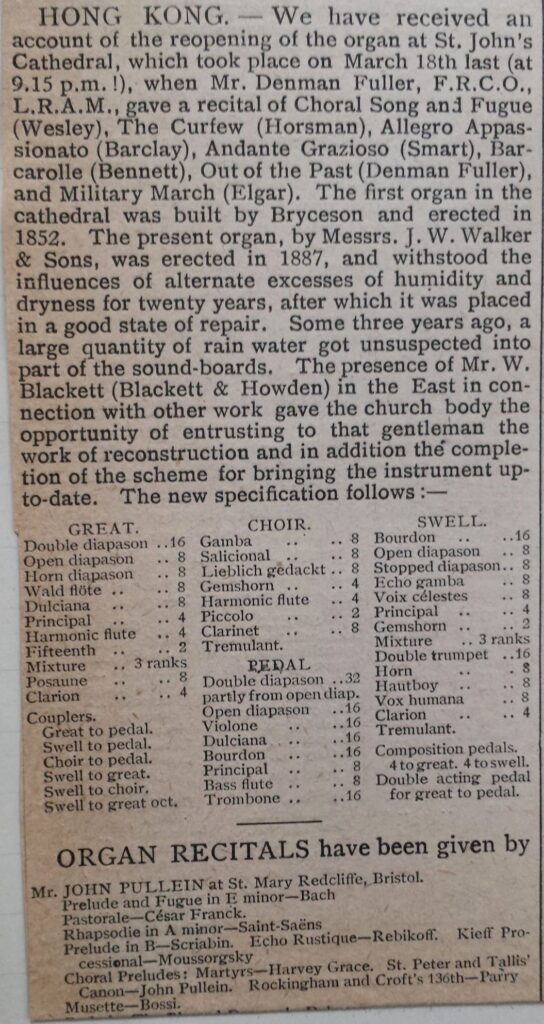
The Pipe Organ in China Project Website: Updates for April 2022.
30 April 2022
The entry for HKG1984 has been updated, with the specs and other information following an inspection of the organ this past month.
An interview with Prof. Urrows on the publication of his new book, François Ravary SJ and a Sino-European Musical Culture in Mid-Nineteenth Century Shanghai, was published in mid-April in the online magazine, Interlude HK. It can be accessed here:
Photo of the Month: Leçon de solfège, Seng-mou-yue.
This photo, taken around 1900 or earlier, shows a singing class at the ‘seng mou yeu(n)’ (sheng mu yuan 圣母院, known in English as Holy Mother’s Garden). This was an orphanage and school (est. 1867) at Zikawei (Xujiahui), Shanghai, run jointly by the Daughters of Charity and the Auxiliaries of Purgatory, along with the Presentadines, an indigenous religious order of Chinese laywomen established in 1843, who are still operating today with a mother house in the scenic riverine Shanghai suburb of Qibao.
The singing “lesson” has been moved out of doors for the photograph, for the simple reason that there was no way at the time to provide adequate lighting indoors for pictures like this. More should not be read into outdoor photographs at this date, which are necessarily so ‘staged’ for practical reasons. Eleven girls, one wearing a medallion around her neck, are joined by someone playing the harmonium, with another woman to her right who may have been a surveillant (disciplinary staff), and an older member of the Daughters or Auxiliaries, who must have been the teacher. They are reading from a few oblong music books, and a double-sided music rack has been placed centrally to complete the picture.
This photograph is particularly valuable, because it is one of the very few to show music activities in the China missions involving girls and young women at this time. It appeared in: Relations de Chine: Kiang-Nan: bulletin tremestriel (Paris: Compagnie de Jésus, 1913-17), p. 385.
Organs in the Census: 195
Year-to-date Hits: 11,311
Three-year Hits: 33,127
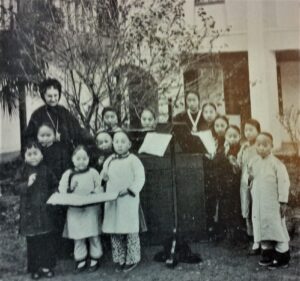
Singing lesson at the seng mou yuen, Shanghai, ca. 1900
The Pipe Organ in China Project Website: Updates for March 2022.
30 March 2022
A newly-authenticated installation, PEK2003, has been added to the Census. Actually, we have known about this little positive organ for some years, but it has only been possible to include it now.
The entry for PEK2004b has been completely rewritten, as The Project has managed to confirm that this Oberlinger organ is installed the Qinghe Church of the Yanjing Theological Seminary at Haidan in Beijing, and not in a non-existent ‘Nestorian Church’. We are still trying to find the specs. As to how this mistaken location came to be reported elsewhere, we now believe that the church’s name, qing he (清河), meaning Qing River, and which describes the site of the seminary church on the north bank of a canal dug in the 18th Century during the Qing dynasty to link the Old Summer Palace with the ‘Forbidden City’, was somehow mixed up with the Chinese term for the Nestorian faith, the jingjiao (景教, resplendent teaching). This may explain the origins of the confusion.
The entry for PEK2013 has also been updated, based on new data. The specs for MDJ2015 have finally been located and added to the page, and the organ turns out to be significantly smaller than we were led to believe. Minor fixes have also been made to CAN1995a, CAN1995b, SHA2005, PEK2016c, and HKG2016.
We have added a link on the main page (About the Project) to the English-Chinese Glossary of Pipe Organ Terminology. The process of enlarging the secondary photos is also now essentially complete.
Prof. Urrows writes from Hong Kong about the Photos of the Month:
What we have here is the cover, and the first page of a remarkable publication of the French Jesuit mission in Shanghai at the end of the 19th Century. This is the 1892 edition of Chants sacrés, with organ accompaniments and fingerings by Charles de Bussy SJ (1823-1902). This volume was itself an update of an earlier hymnal, Chants sacrés à l’usage des missions, published by the Jesuit mission at Zikawei outside of Shanghai in 1877, and compiled by the musician-missionary, Hippolyte Basuiau SJ (1824-86). Presumably this first edition was intended for singing unaccompanied, or to an improvised accompaniment. After the 1892 edition, it went through two more editions, in 1927, and then in 1934. These later editions included romanizations of the Chinese texts for these chants, songs, and liturgical pieces, reflecting the increasing indigenization of the Roman Catholic church in China outlined in the 1919 apostolic letter, Maximum illud, of Benedict XV.
In addition to chants, such as the two different versions of O salutaris hostia seen at the start (note the 3-voice and 4-voice settings of the first tune), it also includes the first of the Messes royales of the Franco-Flemish composer Henry du Mont (1610-84), the preferred setting of the Ordinary in French Roman Catholic churches well into the first two decades of the 20th Century.
The Project has always focused on instruments, and the people who built them, and has avoided the whole question of repertory as far as possible. But this is a question I am always asked: what did they play on all these organs and harmoniums? Here we have a partial answer. They sang, and the organist accompanied, a particular 19th Century style of chant, known as plain-chant mesuré. This ‘metrical plainchant’ was in part the creation of a notable Jesuit composer and proto-musicologist, Louis Lambillotte (1797-1855, his year of birth is often given incorrectly as 1796, even on Wikipedia). Lambillotte, who had been one of Basuiau’s teachers in Belgium, made an intensive study of neumatic notation in the 1840s, and came to the incorrect—but in the 19th Century understandable—conclusion that the rhythm of plainchant before the 12th Century had been based on regular, duple divisions of a semi-breve. Consequently, all of his numerous publications of the 1850s presented plainchant in duple meter for the most part, accompanied by three-part organ settings, most of which were written by a young César Franck. Although swept away by the Cecilian movement and the publication of the Liber usualis in 1896, plain-chant mesuré was a popular approach to singing chant in the second half the 19th Century and perhaps even later. Its main virtue was that it allowed, at least in theory, the congregation to participate.
I write about this at greater length in my recent book, François Ravary SJ and a Sino-European Musical Culture in Nineteenth-Century Shanghai (CSP, 2021). A book review, written by Alexander Meszler of Syracuse University, has appeared in the April 2022 issue of The American Organist.
https://www.cambridgescholars.com/product/978-1-5275-7461-8
What my book doesn’t say, is that the background image on the cover is the first page of the 1892 Chants sacrés.
Organs in the Census: 195
Year-to-date Hits: 11,539
Three-year Hits: 33,195
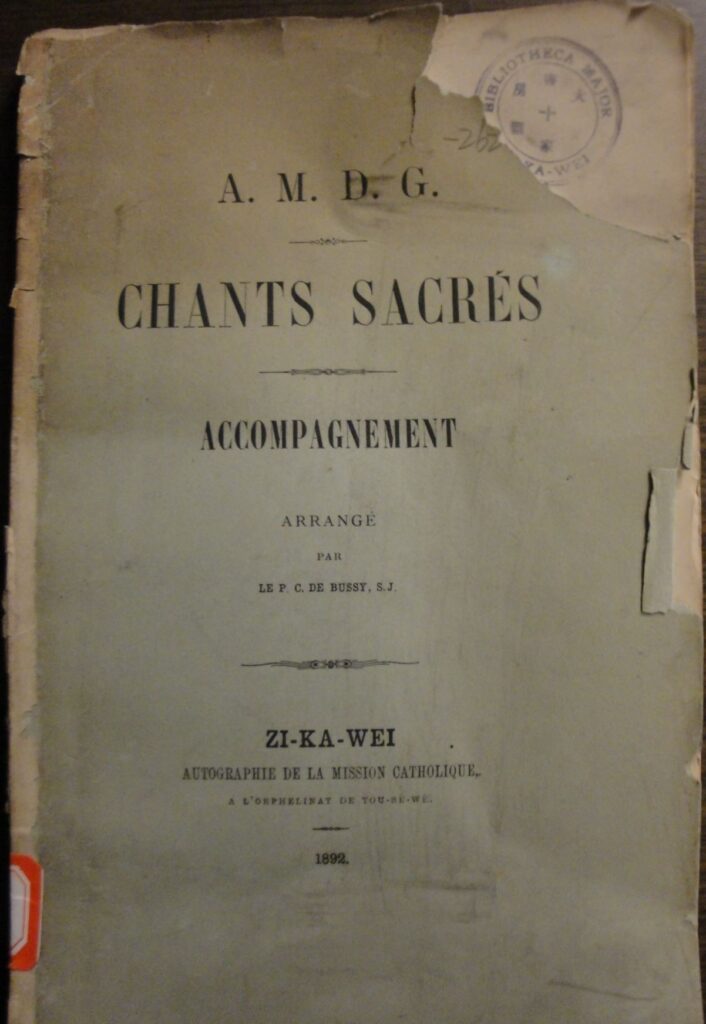
Chants sacrés, 1892.
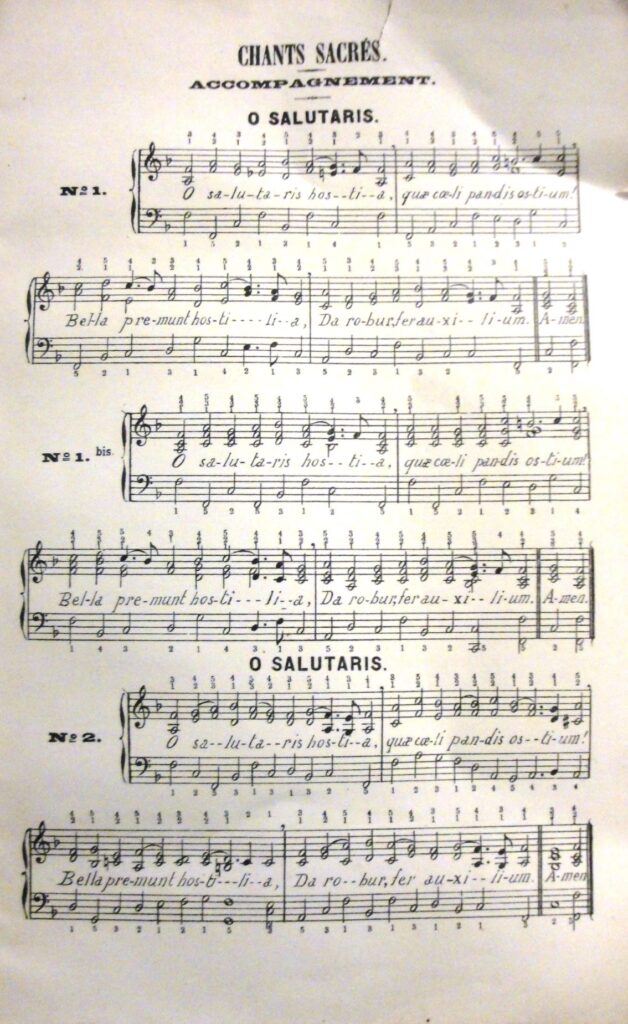
The Pipe Organ in China Project Website: Updates for February 2022.
27 February 2022
New photos have been added to YCF1937, and TAO2012a.
Minor fixes/additions have been made to HKG1921, PEK2006, TAO2008, TJN2011, and TJN2015a.
Picture of the Month: The ruins of the Nantang (南堂, South Church), Beijing, about 1901.
A remarkable photograph of the destruction visited on the 1776 Nantang (the old Cathedral of the Immaculate Conception) on the night of 14/15 June 1900 by the Boxers (compare with the late-nineteenth century photo, taken from the western side of the building.) Since the Résidence (the long, single-story whitewashed building) has been rebuilt (restaurée), this photo is probably from the spring of 1901, before the ruins of the old Cathedral were leveled and building work started on the new church.
The camera’s view is from a point on the city walls (torn down in the 1950s) at the intersection of today’s Xuanwumen Dongdajie, running diagonally along the left side of the photo in front of the cathedral compound, and Weiying Hutong (see the map: the camera’s location is shown by the red diamond, looking approximately WNW.)
The site of the 1904 reconstructed church is approximately the same as the ruins of the anc[ienne] Cathédrale, though some researchers think it is slightly to the south of the original site. The site of the Collège is now occupied by the Beijing Waishi School. The wall in front of the ruins of the church is whitewashed, as must have been erected during the reconstruction of the Résidence to keep people out. The only parts still standing from this image are a small portion the temple-like structure along Xuanwumen at the western end of the property, and the low building to the right of it (see photo from the 1880s).
The Project understands that the Nantang (home to PEK2015a) was closed for “renovations” in December 2018, and it is uncertain when it will reopen.
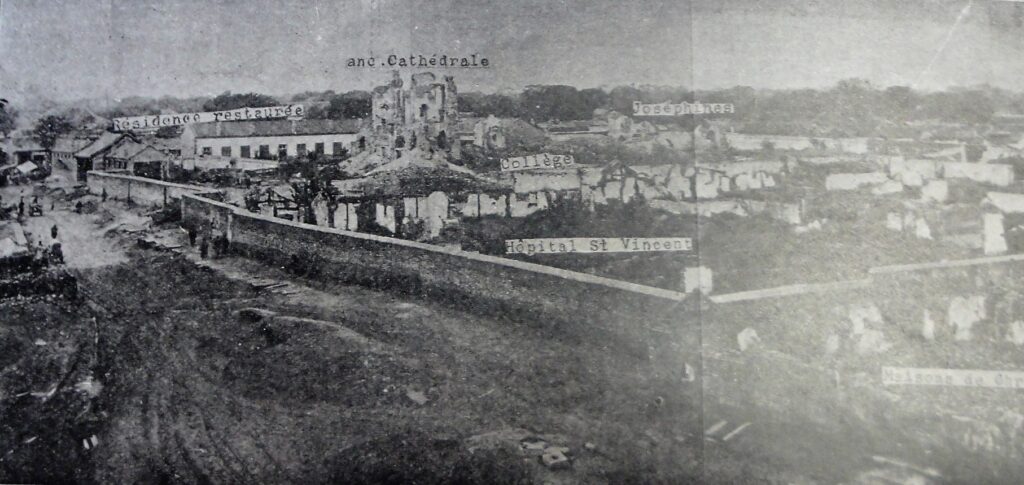
Nantang, ca. 1901, after destruction by the Boxers, June 1900.
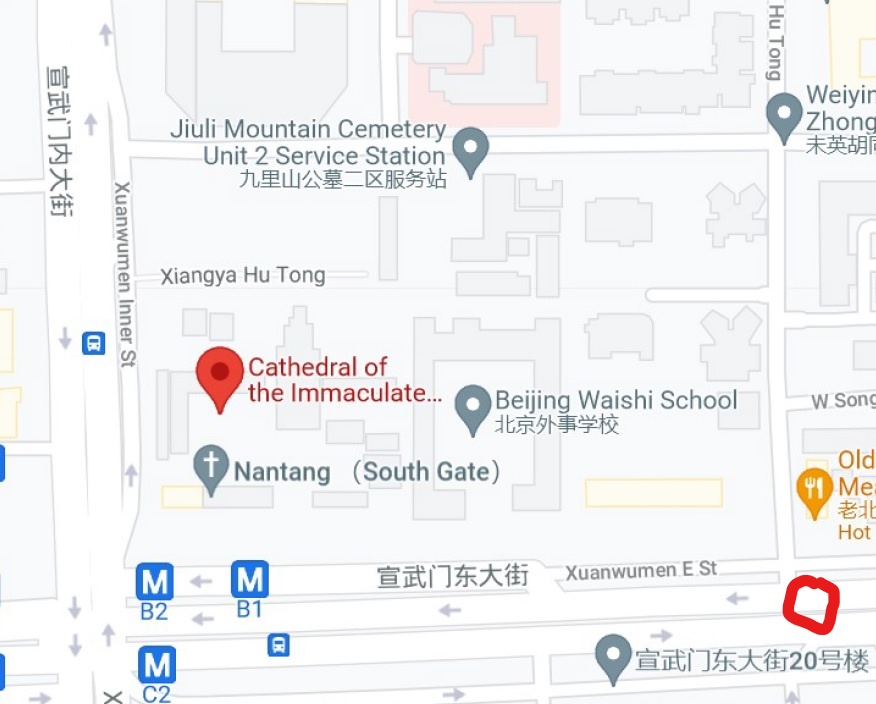
Nantang site, 2022.
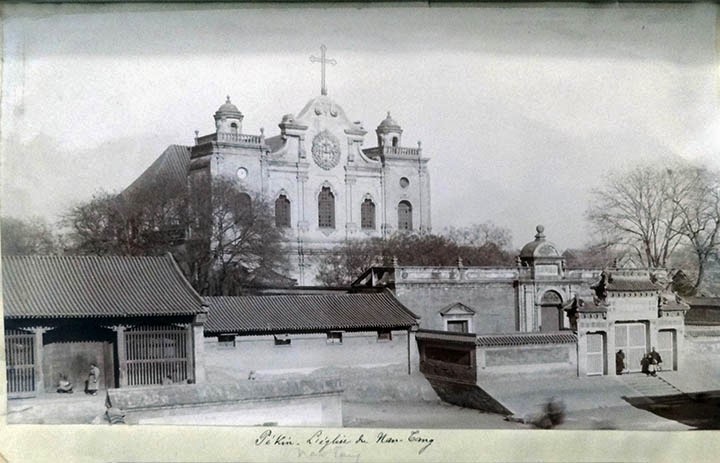
Nantang, from the southwest, late 19th C.
Organs in the Census: 194
Year-to-date Hits: 11,833
Three-year Hits: 33, 939
The Pipe Organ in China Project Website: Updates for January 2022.
30 January 2022
During maintenance of the website this month, we discovered once again that a number of secondary pictures (the ones below the description/specs of the instruments) had been ‘tipped’ 90 degrees out of line. We still do not know why this is happening, and have gone through the entire Census of 194 organs to fix them. All these problems occurred in the First/Second Half of the 20th Century, and 2000— tabs, but strangely not among the earlier instruments. All photos are now placed in their correct orientation. We are also beginning to enlarge most of the secondary pictures in order to show more detail.
The page for HKG1935 has been updated, including the original specs for this W.C. Blackett installation, now rebuilt in a different hybrid form, and serving a church in Manila since 1959.
New photos have been added to SHA1858, HKG1973, and HKG2014.
A new blog post by Prof. Urrows, on the 18th Century Vincentian lay brother and organ builder Charles Joseph Paris, was posted to What’s New on 20 January.
Photo of the Month: The memorial stone in the Xitang (西堂, West Church) in Beijing. The Latin text reads, in English translation, as follows (with thanks for Fr. Cyril for his helpful suggestions):
“To God, most good, most great: Teodorico Pedrini, priest of the Congregation of the Mission [CM, Vincentian, Lazarist], teacher of the children of the Kangxi emperor, out of his own funds erected this church in AD 1723, dedicated to God under the patronage of Our Lady of Seven Sorrows; and which, during the time of the persecutions of the Jiaqing emperor, was completely destroyed in 1811.
After this, in AD 1867 the Most Reverend [Joseph Martial] Mouly CM built a new church in this place, which was burned to the ground by the Boxers on 15 June 1900, with Father Maurice Doré CM, parish priest of this church, cruelly murdered.
Then, in AD 1912, through the beneficent gift of Rosalie Branssier of the Daughters of Charity, this third church, under the title of Our Lady of Mount Carmel, was built.
To whose memory, the Most Reverend [Stanislaus] Jarlin CM, Vicar Apostolic of Beijing, has erected this stone.”
The Xitang church will celebrate its tricentennial next year (2023). For organs and musicians in this church, see: PEK1872, PEK2016a, and What’s New for 13 January 2020.
A Happy New Lunar Year of the Tiger (which begins on Feb. 1) to all our friends and visitors!
新年進步! 恭喜發財!
Organs in the Census: 194
Year-to-date Hits: 12,081
Three-year Hits: 34,081
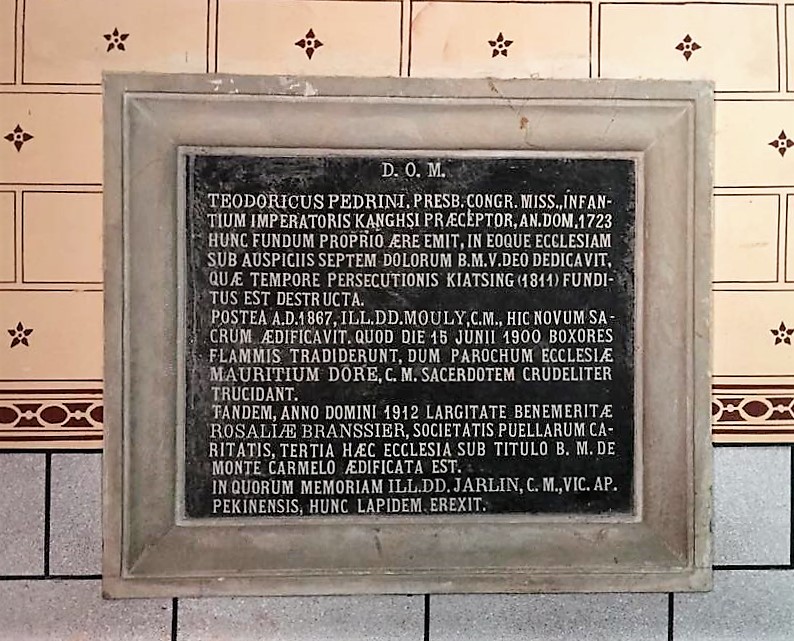
The memorial stone of Bishop Stanislaus Jarlin in the Xitang.
Further notes on Charles Joseph Paris CM (1738-1804), horologist, engineer, and organ builder(?)
20 January 2022
Prof. Urrows writes:
One of the more enigmatic figures in the history of the pipe organ in China is the Vincentian lay brother, Charles Paris. When I wrote Keys to the Kingdom, the furthest back I could trace any account of Brother Paris as an organ builder was an article published in 1963 by Vincentian historian Octave Ferreux: “Histoire de la Congrégation de la Mission en Chine”, published in Annales de la Congrégation de la Mission, Vol. 127, in that same year.
Recently, while searching for something else (as it always happens), I finally found the source of Ferreux’s information. This source is itself only a secondary source, and much of it was taken from the second volume of Mémoires de la Congrégation de la Mission en Chine (Paris, 1911-12). But it offers somewhat more detail about Paris’ life and his involvement with PEK1787a and PEK1787b than I had access to previously. This is a monograph by the Vincentian (Lazarist) China missionary, Alphonse Hubrecht (1902-49), originally published in Beijing in 1939 as La mission de Pékin et les Lazaristes. Hubrecht’s study was translated into English by Henk Hippolyte de Cuijper CM in 2013; and subsequently edited for publication by John E. Rybolt CM in 2021. (This English version is: “The Mission of Peking and the Vincentians”, and while not as accurate a translation as one could hope for, can be downloaded for free here: https://works.bepress.com/john_rybolt/133/download/).
* * * * *
Charles Paris was born at Verderonne, Picardie, in the diocese of Beauvais, in 1738. As a young man he “had worked under the best watchmakers of the capital [Paris]”, and was “also a mechanic [engineer] and a carpenter.” Readers of Keys to the Kingdom will know just how closely watch and clock making on the one hand, and organ building on the other were linked in the seventeenth and eighteenth centuries, and how many missionaries combined these professions. Hubrecht goes on to say that for some years Paris “was a ‘hermit’ at St. Cyr, where Mr. [Joseph] Ghislain [CM, 1751-1813], who himself was living in the former boarding school of Madame de Maintenon, surely [must have] met him, directed him, and attracted him [to the Vincentians].” Thus, Paris was already 45 years old when he finally joined the Congregation of the Mission as a lay brother on 2 June 1783, taking the name of Joseph (St. Joseph is the patron saint of China, as well as that of carpenters.)
The Vincentians had been appointed to take over the work and properties of the China Jesuits, whose order had been suppressed in 1773 by the papal brief, Dominus ac Redemptor, of Clement XIV. So Paris departed for China, along with Ghislain, and the future superior of the French mission in China, Nicolas Joseph Raux CM (1753-1801), from Brest in March 1784:
Brother Joseph Paris, who is to accompany these two priests… has been destined to go to Beijing as an artist, [and] he has ‘followed the team of the peal of bells’ [i.e., studied music]. He has taken harpsichord lessons…
This suggests that Paris had, perhaps, minimal training as a musician before joining the Vincentians. The three arrived in Macau on 23 August, after a remarkably fast passage. From there they were summoned to Canton (Guangzhou), which they left for Beijing on 7 February 1785, and where they arrived on 29 April. Raux wrote to his family, that
We traveled about 600 leagues [he means something like the lieue de Paris of about 3900 meters], partly by river, partly by land. Mr. Ghislain and I have been all the time in excellent health; we did not experience any need during the trip. On our arrival we found a beautifully, completely equipped house, [and] a very nice church, built in the enclosure of the greatest and most powerful emperor in the world: they are the house and church of the French former Jesuits.”
Raux is describing here the first Beitang (North Church), built within the precincts of the imperial city in 1703 for the French Jesuits; and his account also suggests that Paris did not enjoy such good health on the trip, probably due to his age. Paris made his vows in Beijing on 14 June 1785, but little is heard of him until 1788, when Raux reported in his annual letter that
Brother Joseph Paris succeeded the late Father [Jean-Matthieu Tournu] de Ventavon [SJ] (on 27 November 1787) in the position of watchmaker and engineer at the [imperial] palace. This brother, who is talented, has just produced a clock which can run for three months without the need of winding up the weights again. We hope the [Qianlong] emperor will be pleased with it.
Finally we hear of the two organs, but only in a posthumous appreciation written by Ghislain in a letter dated “Beijing, 20 October 1804”:
He was never found idle, but working and praying all the time. He combined very exemplary piety and regularity with an almost universal talent: he made several big clocks, two big chiming clocks [carillons], a small and a large pipe organ; moreover, he made for the palace an automaton four or five feet high, which could write the praises of the emperor in four different languages, that is, in Chinese, Tartar, Mongol, and Tibetan. He printed for us here not only several useful things, but he himself made many fonts that he needed, just as beautiful as [those that] could have been made in Europe.
Since this is the only account of the two organs, it is impossible to put a precise date on them at present; but I have always assumed that they must have made early on in his Beijing years along with the clocks, as the comments on his health and its decline grow more frequent in the 1790s. And it is most unlikely (as Ferreux suggested in 1963) that they would have been made after the abdication of Qianlong in 1796 in favor of his son, the Jiaqing emperor, who was immediately a persecutor of the missionaries and Christianity in general. Despite this, Paris was raised to the sixth grade of the mandarinate (probably Grade 6B, also given to Buddhist and Taoist priests) in 1793 by Qianlong. Perhaps someday more accurate dates for his two organs will be possible; but I use Raux’s 1788 letter that describes some of the clocks as a baseline for this.
Interestingly, Hubrecht raised the point that the two organs might not in fact have been made by Paris at all. Somewhat playing devil’s advocate, he pointed out that
these small miracles…could well have been articles imported by way of Macau. Who knows? In that case the brother would have had only the minimal merit of skillful repairing, or of happy adaptation. But why cast doubt over Mr. Ghislain’s testimony [in the 1804 letter], where we can feel his care to be truthful, and not desirous of vainglory?
Paris died in Beijing on 6 September 1804, and was buried in the French cemetery at Zhengfusi (no longer extant.) His organs, his clocks, and his grave have all disappeared; but he himself is not forgotten.
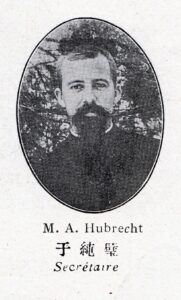
Alphonse Hubrecht CM
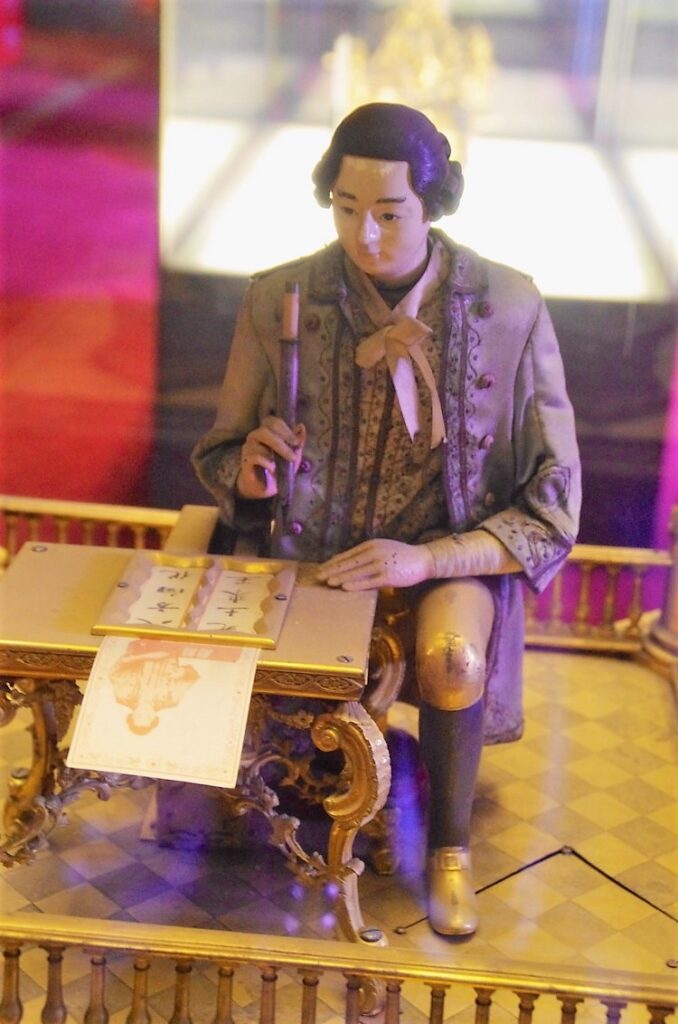
An automaton made by Williamson of London in the late 18th C., now at the National Palace Museum, Beijing (i.e., the ‘Forbidden City’). Unlike Paris’ automaton, this one can only write in Chinese.
The Pipe Organ in China Project Website: Updates for December 2021.
30 December 2021
The page for HKG1931 has been updated with some new anecdotal information about this W.C. Blackett installation.
Casavant has announced that a contract has been let for an “historic restoration” of the two-manual Kimball theater organ in the Auditorium of Peking Union Medical College (PEK1920).
PEK1920 was one of the few theater organs installed in China in the first quarter of the 20th Century (the others documented in the Census were in Shanghai, Hong Kong, and Tianjin.) The Project surveyed what survives of this organ in 2009 and 2010 (see photo below), and has long advocated some sort of re-utilization of the surviving pipework of this instrument in this important building. We were approached by PUMC in the Spring of this year (2021), but heard nothing after the first inquiry, probably because an ‘archeological’ restoration seems pointless to us in the context of 21st Century China. While no details about the rebuilding have been released, it will necessarily involve an entirely new console, blower, generator, and perhaps some sort of digital device to replace the lost roll-playing reproducer. Casavant will work with theater organ specialists J.L. Weiler, Inc., of Chicago (which is where the organ was originally built by Kimball.) They state that there will be 23 stops, utilizing extensions and unitizing of the 10 original ranks (assuming that all are salvageable.)
Casavant has also announced further details of the organ planned for the under-construction concert hall of the China Philharmonic Orchestra in Beijing, first reported by The Project back in April 2019. It is now described as a IV/61 rank organ, with 79 stops and “dual mechanical and electric actions”, designed in “French style” for the futurist-looking hall (see image below, from the builder’s year-end literature.)
Photo of the Month: one of Prof. Urrows’ former students sent us a nice picture of the concert hall of the Beijing Central Conservatory of Music. It was taken this Fall during an erhu doctoral recital, performed here on erhu and yangqin. It also shows, quite unintentionally, the Rodgers Infinity Series 484 hybrid organ installed in the hall. Hybrid instruments like this are not surveyed by The Project (see FAQs), but we are posting it anyway as an example of different aspects of organ culture in Mainland China at the present day. (Our thanks to YM for the photo.)
The Pipe Organ in China Project wishes all our visitors and friends a Merry Christmastide and a Happy (Happier!) New Year. 新年進步!
Organs in the Census: 194
Year-to-date Hits: 11,646
Three-year Hits: 33,855
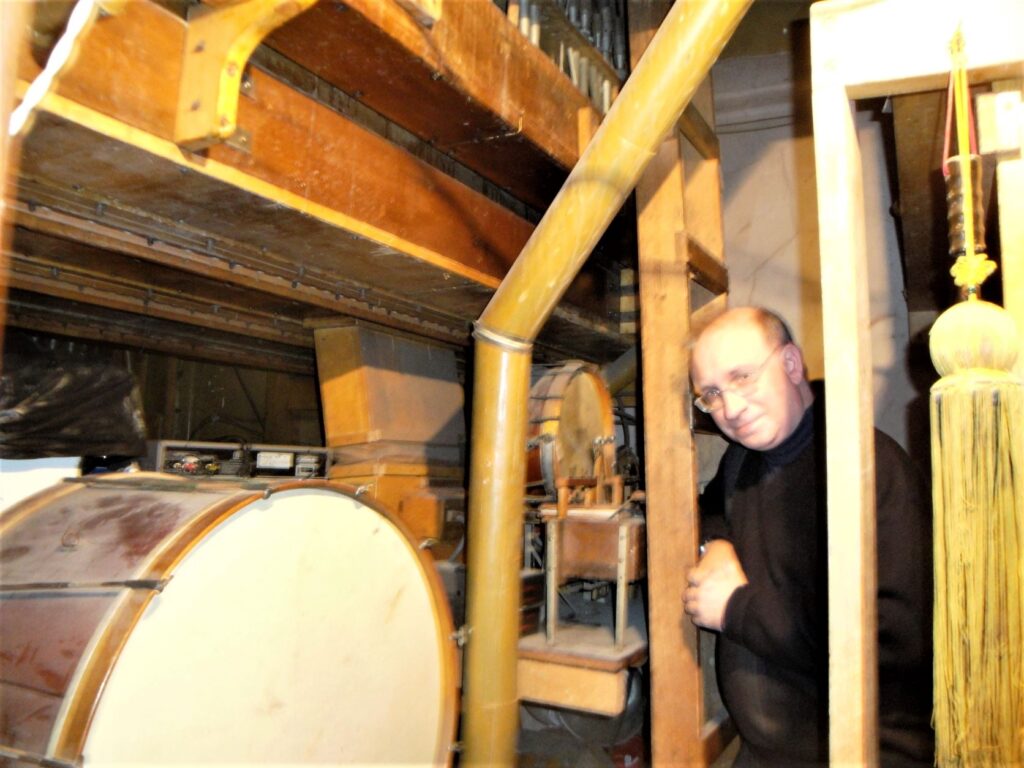
Prof. Urrows amid the traps of PEK1920 at PUMC, 2009.
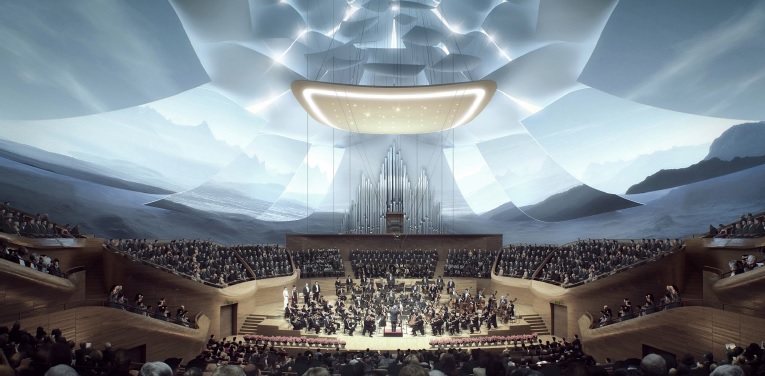
CAD image of the proposed Casavant organ for the new concert hall of the China Philharmonic.
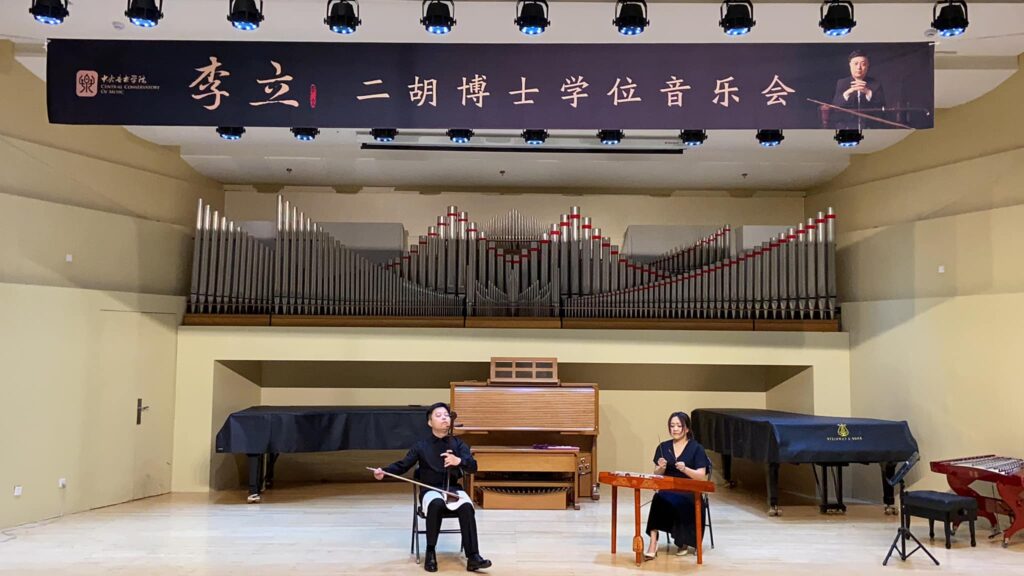
The Rodgers hybrid organ at CCOM, Beijing.
Christmas in Shanghai, 1932
24 December 2021
Prof. Urrows writes from Guam on Christmas Eve:
This account of Christmas Eve and Christmas morning masses at Dongjiadu (the Church of St. Francis Xavier, site of the famous bamboo organ [SHA1857]), appeared in the journal The Far East in March 1933. It was written by Roger Doherty, SSC (?-1980), a Columban (Maynooth) missionary who at that time was living in Shanghai and studying Chinese.
This article not only mentions the organ, but in its description also reflects the changes in liturgical practice brought about after the First World War by the increasing indigenization of the Roman Catholic church in China during the Republican period. All in all, it is an interesting historical record, set almost 90 years ago in a Shanghai still tense from the ‘January 28 Incident’ (which actually occurred between January and May of 1932). This was the first major conflict between Chinese and Japanese troops and civilians within the city limits of Shanghai prior to the Second World War, and Doherty alludes to it with his quotation from the Gospel according to St. Matthew. A truce was eventually reached, along with the withdrawal of Japanese troops from the International Settlement; but this only lasted until 1937, the outbreak of the Sino-Japanese War, and the Battle of Shanghai, which the Japanese decisively won.
The Far East, founded in 1918, is still published today and is now called Columban Mission. Further information can be found here: https://columban.org/magazine
* * * *
“…Father Collins and I go off to assist at the Cathedral [sic.] of St. Francis Xavier [dongjiadu, Tungkadoo.] The priests have been busy hearing confessions all day and are still busy when the congregation begins to arrive for Midnight Mass. What a sight to see them coming! Old and young, rich and poor hurry in, carrying their umbrellas, in the pelting rain. Some arrive in rickshaws, a few in autos, but most of them on foot.
The church is packed to overflowing. It is brilliantly lighted with electric light. All the pillars are draped with great red hangings, inscribed in large Chinese lettering in gold braid. The altar and sanctuary are one forest of green leaves and red flowers—for red is the royal color in China. On the epistle side of the church, just outside the sanctuary is a beautiful crib [nativity scene].
The Chinese love all our ceremonial, but that of Christmas seems to have claimed a special place in their hearts. The priests will have to labor all night to satisfy their needs. Father Collins will celebrate Midnight Mass, during which I am to distribute Holy Communion with the assistance of Father Tsang, if he can leave his confessional. I will say my three Masses at five o’clock, and Masses will go on all morning until High Mass at eight. Each Mass will have its big congregation.
A joyous peal of bells announces that it is midnight, and we form a procession in the sacristy. A little army of acolytes is ready. They are a gorgeous array in long red cassocks, lace surplices, and blue sashes with gold braid. They carry torch-lanterns, some red and some blue, with gold crowns. In the midst, in a cloud of incense from glowing censers, a red-gold throne is carried shoulder-high and on it the image of the Babe of Bethlehem.
The procession marches out through the sanctuary and down the church. At the door a fusillade of firecrackers salutes the Christ Child. Through the church, the people chant their prayers aloud in their characteristic fashion, so impressive to the foreigner. “The Kingdom of Heaven suffereth violence and the violent bear it away” [Matthew 11:12]. The Chinese must surely carry it by storm.
The procession returns to the sanctuary and Mass begins. The organ thunders forth the Adeste [fidelis], the same that makes the Christian heart beat faster the world over. It is taken up by a well-trained choir and their Latin words are clear and distinct. Then follows the scarcely less-impressive Angels we have heard on high, sung in Chinese up to the joyous refrain, Gloria in excelsis Deo. These are the hymns we have heard at home on every Christmas night since childhood, and hearing them tonight sets us thinking. Time and distance vanish. These hymns seem to typify in a beautiful way the unity of the Church.
The bell announces that the Communion time has come. The congregation presses forward to the altar rails. Two priests distribute Communion up to the end of the Mass, all through the second—and still the crowds come—until nearly the end of the third Mass. It is truly edifying and awe-inspiring. Each of us must have administered Communion to about a thousand persons.
After the Mass, we retire to snatch, if we can, a few hasty hours of sleep. Masses will begin again at four-thirty, and will continue all morning until the High Mass. The scenes of midnight will be repeated, and hundreds more will receive their Eucharistic King.
At eight o’clock we are in readiness for High Mass. The big organ [SHA1857, in its 1925 renovation] peals forth the music of the Mass. (By the way, this organ is unique. It is said to be the only one in the world that has its reeds [sic., pipes] made of bamboo.) A sermon is preached in Chinese. All listen with rapt attention to the wondrous story, ever old but ever new, of the Babe of Bethlehem. The Puer natus est nobis is sung afterwards. The Church is filled with the truly Christmas atmosphere. Old and young seem imbued with it. Even the babies are held aloft by their mothers to gaze with wondering eyes at the lights and flowers around the altar and crib.
When Mass is over, the congregation is in no hurry to go. Many remain on their seats, chanting their prayers together aloud. The space before the crib is full.
We return to the Church, now half-empty. Most of the lights are out, but there is still an odor of incense and flowers in the place. We go up the dimly lighted aisle and pray with those at the crib. It is a beautiful one. The cave is in a wall of very real-looking rock, twenty or thirty feet high. All the way up there are twinkling lights in the clefts of the rocks, and over all the Star of Bethlehem shines.
Soon all are gone except for one little group before the crib. It is a family group, the older ones marshaling the younger and all reciting prayers aloud together. Surely Jesus and Mary and Joseph are looking down on them from Heaven. What a shower of graces must descend on them, and on the land of China, this glorious Christmas of nineteen hundred and thirty-two!
After leaving our sacred vestments in the sacristy, we go around to the main door to see the people coming out. A Chinese crowd is no new sight to us, but we feel wonderfully drawn to Chinese Christians who are united to us in the Faith, and especially to these whose fervor had so much impressed us. What a pity we do not yet know enough of their language to mingle among them and talk to them!
Some of the little boys approach us with a friendly smile, and form a little group around us. Each as he comes before us, places his heels together and makes a most graceful bow. The smile says plainly, “Fathers, you are welcome to our church. We wish you a happy Christmas.”
We say in our best Chinese, “Excellent little boys, God bless you. We wish you a happy Christmas.”
And they understand and smile more brightly than ever.”
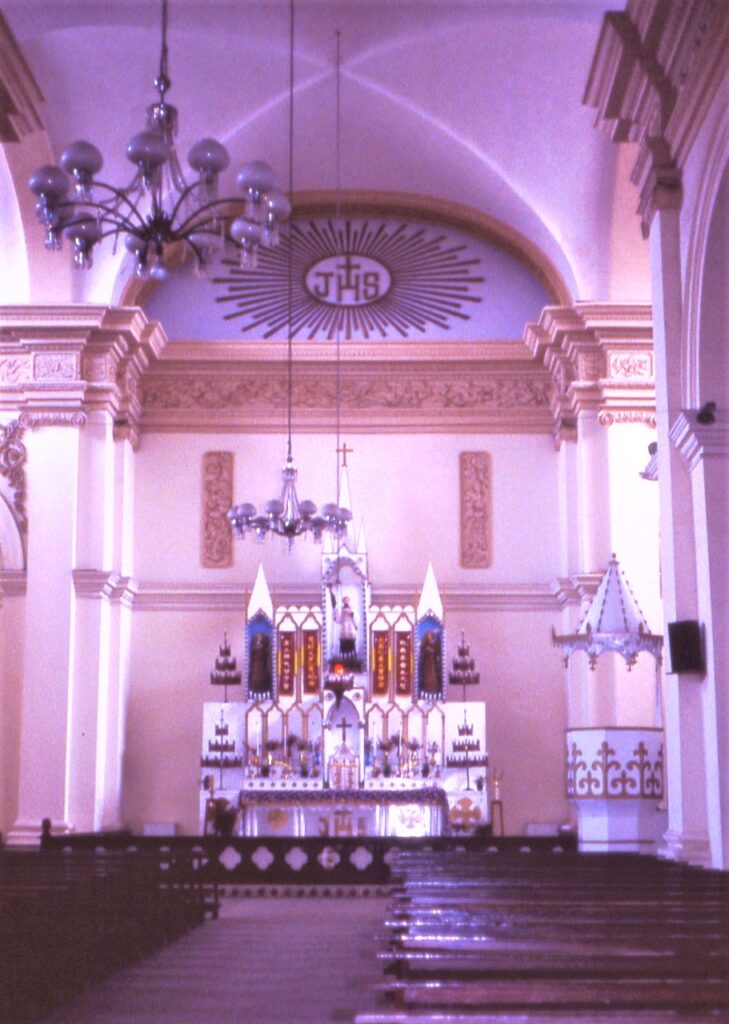
Dongjiadu (Church of St. Francis Xavier), Shanghai, April 1990.
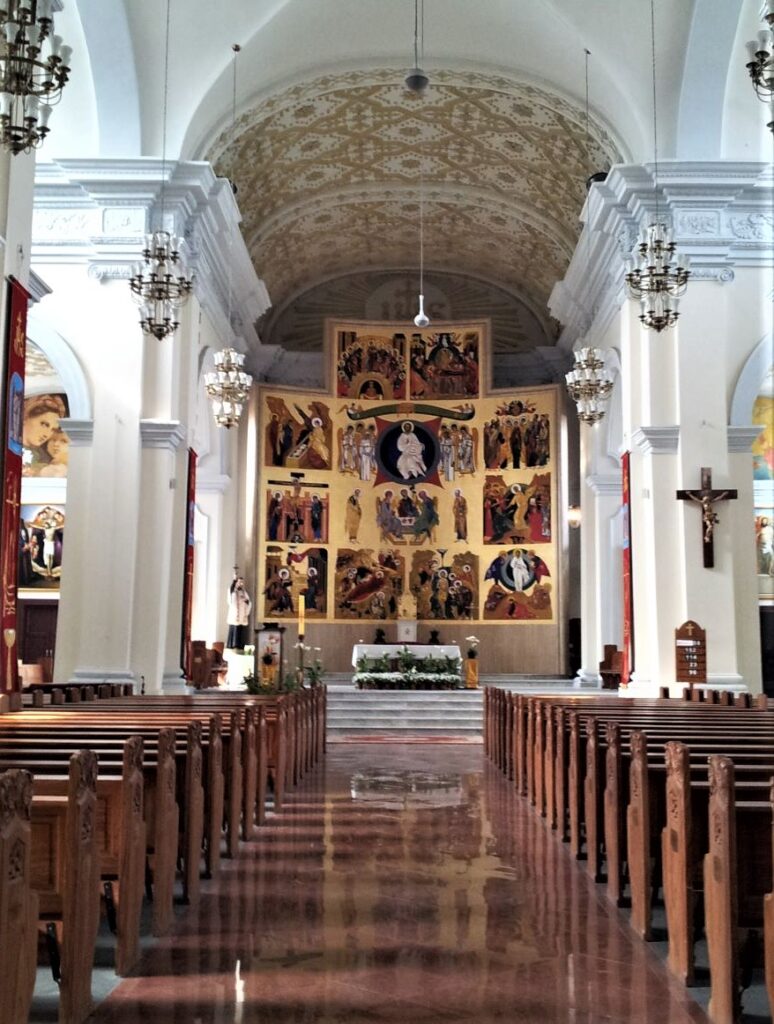
Dongjiadu in April 2013. Note the complete change of interior decoration. The pseudo-Orthodox emulative style has recently become very popular in Mainland China.
Updates for November 2021
30 November 2021
There are no updates for the month of November 2021.
The publication of Prof. Urrows’ new book on Father François Ravary –the mastermind behind the bamboo organs of 19th C. Shanghai– was noted in a post early this month. It is available on Amazon, and also directly from the publisher, Cambridge Scholars: https://www.cambridgescholars.com/product/978-1-5275-7461-8
We hope to resume updates after the Chinese New Year, and ask our friends to bear with us.
Organs in the Census: 194
Year-to-date Hits: 12,368
Three-year Hits: 33,882
Publication of François Ravary SJ, and a Sino-European Musical Culture in Nineteenth-Century Shanghai
2 November 2021
The Project is pleased to announce the publication, on 26 October, of Prof. Urrows’ new book, François Ravary SJ, and a Sino-European Musical Culture in Nineteenth-Century Shanghai (Cambridge Scholars Publishing):
https://www.cambridgescholars.com/product/978-1-5275-7461-8
More information will be forthcoming at a later date.
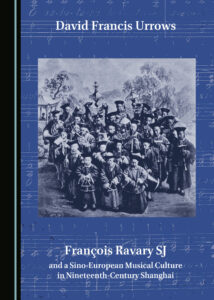
Updates for October 2021
31 October 2021
There are no updates for October 2021.
Organs in the Census: 194
Year-to-date hits: 13, 817
3-Year hits: 34, 002
Happy Hallowe’en from The Pipe Organ in China Project.
Updates for September 2021
11 October 2021
There are no updates for the month of September to The Pipe Organ in China Project Website.
Organs in the Census: 194
Year to date hits: 13,748
Three-year hits: 33,884
Is There a Blessing for a Pipe Organ?
14 September 2021
Prof. Urrows writes from Guam:
In the 1964 musical, Fiddler on the Roof, there is a very funny moment where a young yeshiva student asks the wise Rabbi of Anatevka, “Rabbi, is there a proper blessing for the Tsar?” The Rabbi is taken aback, but after thinking about it for a moment, replies: “Yes. May God bless and keep the Tsar…far away from us!”
Some people may have wondered if there is a proper blessing for a pipe organ. There is (or was), and it was promulgated in 1872 after the First Vatican Council of 1870, the Benedictio Instrumentorum Organi in Eccelsia. Below is an English translation I have made (admittedly a bit modernized) of the original Latin, printed in Ratisbon in 1873, and I thank my colleague Father Cyril Law for his advice on the translation of the Collect. The source is a French manual of organ and service playing, a book I found in the Bibliotheca Zikawei section of the Shanghai Library many years ago. The author added at the end of this, “After the Benediction, it would be appropriate if everyone would gather around the organ, and sing the Magnificat, or Psalm 116 (117).”
Is it time to revive this lovely ceremony, whether you are a Roman Catholic, or not?
Rite for the Blessing of a Church Organ
(approved by the Sacred Congregation of Rites, 31 May 1872)
The priest shall put on the surplice, and the stole appropriate for the season,
and being thus vested shall stand uncovered and say:
P. Our help is in the name of the Lord
R. Who hath made heaven and earth.
P. Psalm 150: O praise God in his holiness; praise him in the firmament of his power.
R. Praise him for his mighty acts; praise him according to his excellent greatness.
P. Praise him with the blast of the trumpet; praise him upon the harp and lyre.
R. Praise him with timbrel and dances; praise him upon the strings and pipe.
P. Praise him with the well-tuned cymbals; praise him upon the clashing cymbals.
R. Let everything that hath breath praise the Lord.
Glory be to the Father, and to the Son, and to the Holy Ghost.
As it was in the beginning, is now, and ever shall be, world without end. Amen.
P. Praise God with the timbrel and dances.
R. Praise him upon the strings and pipe.
P. The Lord be with you.
R. And with thy spirit.
P. Let us pray.
Collect: O God, through Moses thy servant thou hast instructed the sounding of trumpets over sacrifices offered to thy name, and wilt that the praise of thy name be sung by the children of Israel with trumpets and cymbals; ble†ss, we beseech thee, this instrument of the organ dedicated to thy worship; and grant that thy faithful people who rejoice [now] on earth with spiritual songs, may be made worthy to attain joys everlasting in heaven. Though our Lord Jesus Christ, who liveth and reigneth with thee, world without end. Amen.
Finally, the priest shall asperge the organ with holy water.
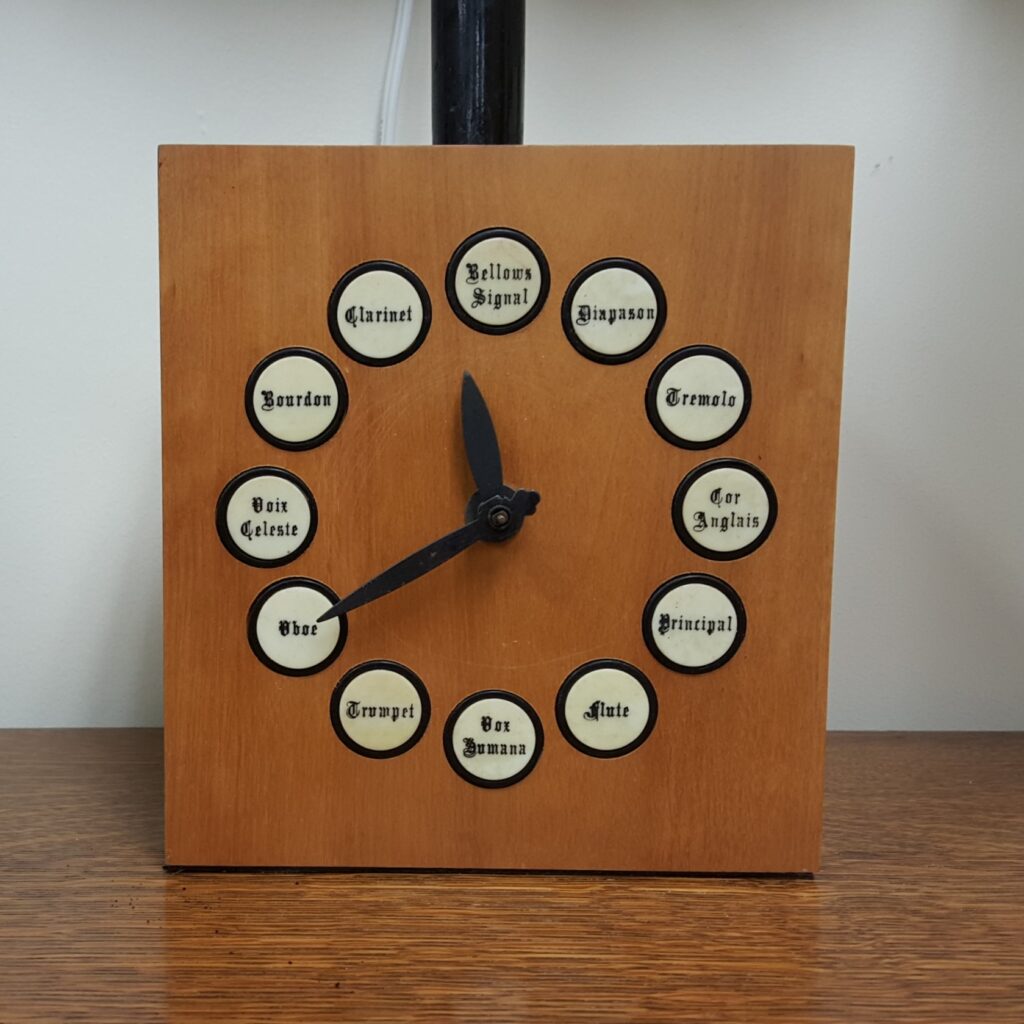
Clock at the Organ Historical Society Library, Princeton, NJ, 2013.
The Pipe Organ in China Project Website: Updates for August 2021
30 August 2021
Prof. Urrows uploaded a blog post earlier this month, marking the 164th anniversary of the dedication of the historic “Bamboo Organ of Tungkadoo” (SHA1857).
Thanks to a correspondent, The Project has learned of a new installation in the port city of Nantong, northeast of Shanghai. This instrument (NTN2021) is a IV/66 organ by Rieger. The specs have not yet been posted by the builder. Rieger is installing another concert hall organ in the city of Zhengzhou, but work was interrupted by the outbreak of the COVID-19 epidemic last year, and has not yet been restarted.
Photo of the Month:
While on the topic of bamboo organs this month, here is a rare photograph of the 1966 Yamaha Bamboo Organ in the Sony Building, Ginza, Tokyo. Little is known about this organ, utilizing bamboo for 497 of its 981 pipes. It was constructed by Yamaha for the Sony Corporation in the early 1960s at a cost of 40 million yen. We would be interested to know if it still exists, and if it is playable. The photo comes from Peter Cheung’s Pipe Organs, Electronic Organs, and Church Organists (Hong Kong: E.C.F. Sheng Tao Press, 1975). Cheung gave the specs as:
Great (61 notes):
Prinzipal 8′ (bamboo/metal)
Flute 4′ (wood)
Piccolo 2′ (bamboo)
Mixture III-IV (metal)
Swell:
Salicional 8′ (bamboo)
Gedackt 8′ (bamboo)
Oktave 4′ (metal)
Schwiegel 2′ (bamboo)
Quint 1⅓′ (bamboo)
Pedal (32 notes):
Bourdon 16′ (wood)
Prinzipal Bass 8′ (bamboo)
Couplers: Suboctave, Superoctave I, Superoctave II, GT/P, SW/P, SW/GT
Swell pedal, Crescendo pedal, Tutti
“Electromotive action”
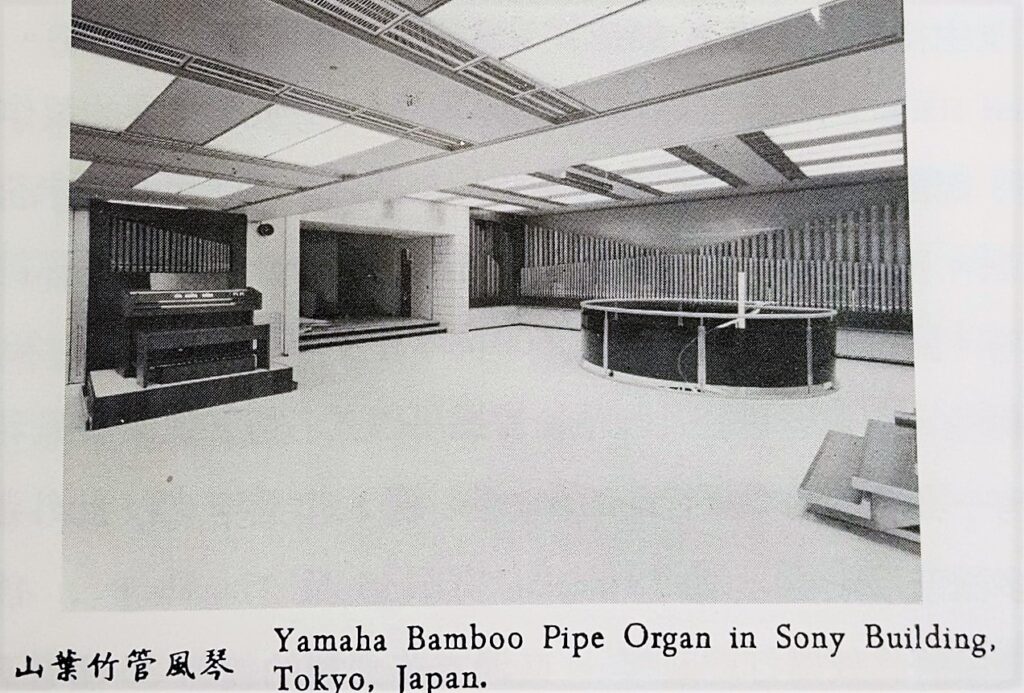
The 1966 Yamaha Bamboo Organ in the Sony Building, Ginza, Tokyo.
Organs in the Census: 194
One Year hits: 13,320
Three Year hits: 32,998
(we can no longer access how many cumulative hits we have had since Launch, June 2018)
164th Anniversary of the Dedication of the ‘Bamboo Organ of Tungkadoo’.
15 August 2021
The 15th of August is the Feast of the Assumption in the calendar of the Roman Catholic church, and the national holiday during the First and Second Empires in France, as it is also the birthday of Napoleon Bonaparte (Bastille Day was ‘relegated’, as they say in sports.)
The organ, constructed by the Jesuits in Shanghai in 1856-57, stood for 109 years in the Church of St. Francis Xavier at Dongjiadu, until it was destroyed in August 1966 by Red Guards during the Cultural Revolution (1966-1976). The loft, which had been built for the organ in the first half of 1857, is still there, but the organ is now a very vague and distant memory. We remember today especially François Ravary SJ (1823-91) who was the mastermind behind the instrument.
It has been a source on endless frustration that no image of this, the first of the bamboo organs built in Shanghai, has ever been located. However, the book which Father Ravary and his colleagues used in the building of the organ still survives in the Bibliotheca Zikawei. This is the actual copy used by Ravary. In one of his letters, he describes the organ as having a “Gothic” case, and for lack of anything else, here is a Gothic case from the Manuels-Roret which was used for the project: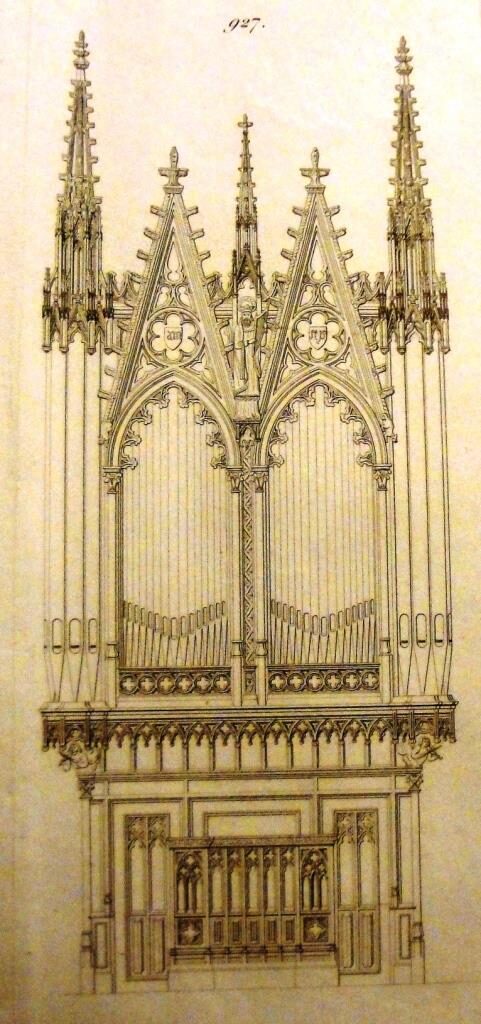
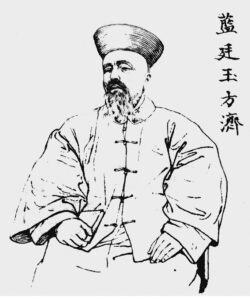
François Ravary SJ
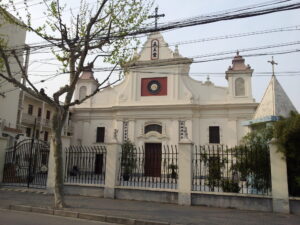
Dongjiadu, Shanghai, Church of St. Francis Xavier (1853), photographed in 2013.
The whole story of Ravary and his colleagues and students will be told in Prof. Urrows’ forthcoming book, François Ravary SJ, and a Sino-European Musical Culture in Mid-Nineteenth Century Shanghai, to be published later this year by CSP.
The Pipe Organ in China Project Website: Updates for July 2021
29 July 2021
Updates for July 2021:
Dates for Wang Linheng (王臨亨) have been corrected in the Errata list and MAC1601 to 1557-1603.
Concerto da Camera has released the second and third videos featuring the Blackett organ (HKG1936) in St. Paul’s Chapel, Hong Kong, one with a short segment by Prof. Urrows. They can be seen here:
https://www.youtube.com/watch?v=x-8DscqL7J0
https://www.youtube.com/watch?v=NYNlZaCVkT8
Photo of the Month: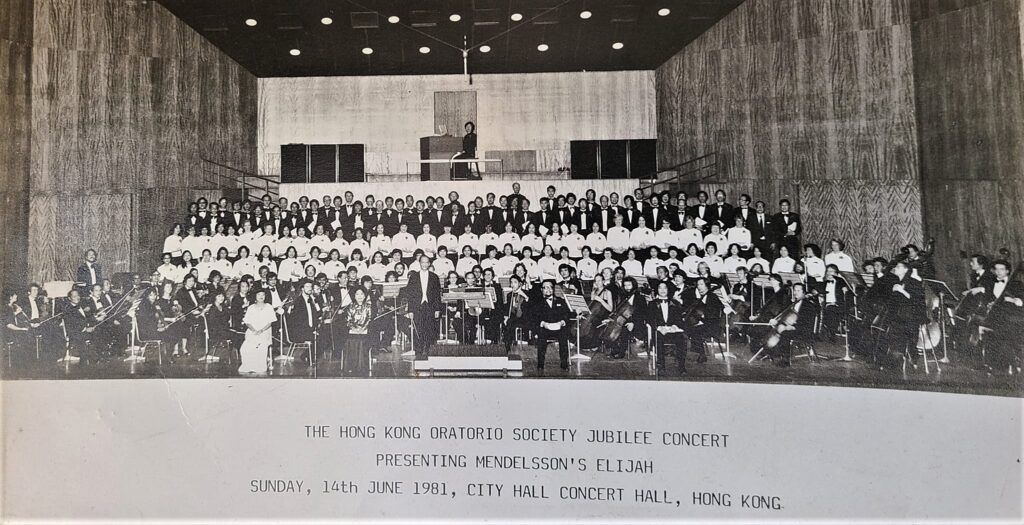
The Hong Kong Oratorio Society, 14 June 1981, performing Mendelssohn’s Elijah at the City Hall Concert Hall, Hong Kong. We are grateful to our colleague, Cynthia Luff (soloist in white sitting on the left), for providing this photo. The conductor is Wong Wing-hee.
Prof. Urrows writes about this image:
This photo is in an interesting historic document and at the same time raises a lot of questions about the position of the organ in Hong Kong forty years ago and also today.
The City Hall Concert Hall still doesn’t have a pipe organ, even a positive organ for continuo. In this image we see how difficult it was prior to the completion of the Concert Hall at the Hong Kong Cultural Centre in Kowloon in 1989 to mount performances like this. The choir galley (which seats only 60) could not accommodate the 100+ members of the Oratorio Society, and so they had to be placed on risers, presumably standing through the entire lengthy work. The choir seats in turn were covered with a precarious-looking plywood platform, and an electronic organ and six immense speakers were hoisted up on top of it (a huge logistic challenge from the stage level.) I am personally quite glad that I was not the organist for this event, and I admire my colleague, Wong Kin-yu, seen calmly sitting on top of this crazy contraption, ready to play. Everything is backwards from what it should be.
While the 1989 Cultural Centre Concert Hall solved some of these problems, such as seating for large choirs and the installation of a four-manual pipe organ by Rieger (HKG1989), the lack of an on-stage electric action console for this instrument means that the organist can only play from the massively heavy tracker console up in the ‘crows nest’ above the choir seats. So, not all of the problems faced in 1981 were solved by the new venue after all and continue to create difficulties for conductors and singers in Hong Kong to this day.
Organs in the Census: 193
Year-to-date hits: 12, 785
Hits since launch (June 2018): 31, 478
The Pipe Organ in China Project Website: Updates for June 2021
30 June 2021
First of all, this month marks the ***THIRD ANNIVERSARY*** of the launch of The Pipe Organ in China Project Website. This month we reached our goal of 30,000+ hits!
A new main photo has been added to HKG1911, seen after the rebuilding in 1931–32 by W.C. Blackett. .
Minor additions have been made to the Errata list for Keys to the Kingdom.
A colleague has drawn our attention to a new book on organs in South Korea: Oh Minjin, Cho Hyunjung, Kim Hyerim, Shin Kiru, and Je Yeheun. Pipe Organs in S. Korea. (Seoul: n.p., 2020), ISBN 9791197282201. Anyone interested in this book (in Korean) should consult the following link: https://www.aladin.co.kr/shop/wproduct.aspx?ItemId=260123323
Concerto da Camera in Hong Kong has continued to release its videos on organs and local church history. Prof. Urrows appears in some of the forthcoming segments: https://www.youtube.com/watch?v=9RCprAX8pcc The Concerto da Camera Facebook page also has links to their video: https://www.facebook.com/100063882754170/photos
Organs in the Census: 193
Year-to-date hits: 13, 195
Hits since launch (June 2018): 30, 410
Photo of the Month:
A youth choir from Macau performs earlier this spring in Chengdu, Sichuan province, with CHD2019 in the background.
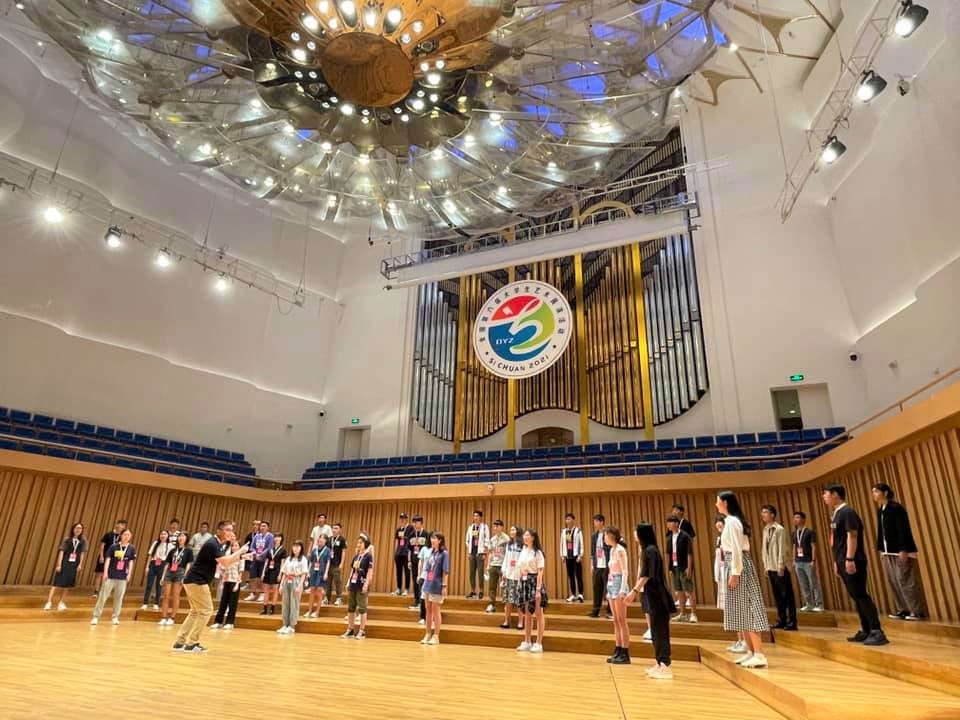
The Pipe Organ in China Project Website: Updates for May 2021
23 May 2021
New photos have been added to HKG1935, and CHD2019
One of our colleagues happened to stop by the Chapel of Christ the King in Causeway Bay, Hong Kong, and sent us a couple of photographs of HKG1930, now under renovation. It is heartening that at least one of William Charlton Blackett’s locally-built instruments is being restored in this way. There are several more candidates that should also be considered for this as part of Hong Kong’s organ heritage.
Prof. Urrows reports that he participated and gave a paper on François Ravary and the Jesuit Musical Multi-Culture of Mid-nineteenth Century Shanghai at the international symposium, Missionary Activities and East-Asian Collections, sponsored by the Science and Research Center Koper, Slovenia. This was of course held virtually, via Zoom. It was recorded and when the link for the video is available it will be posted here.
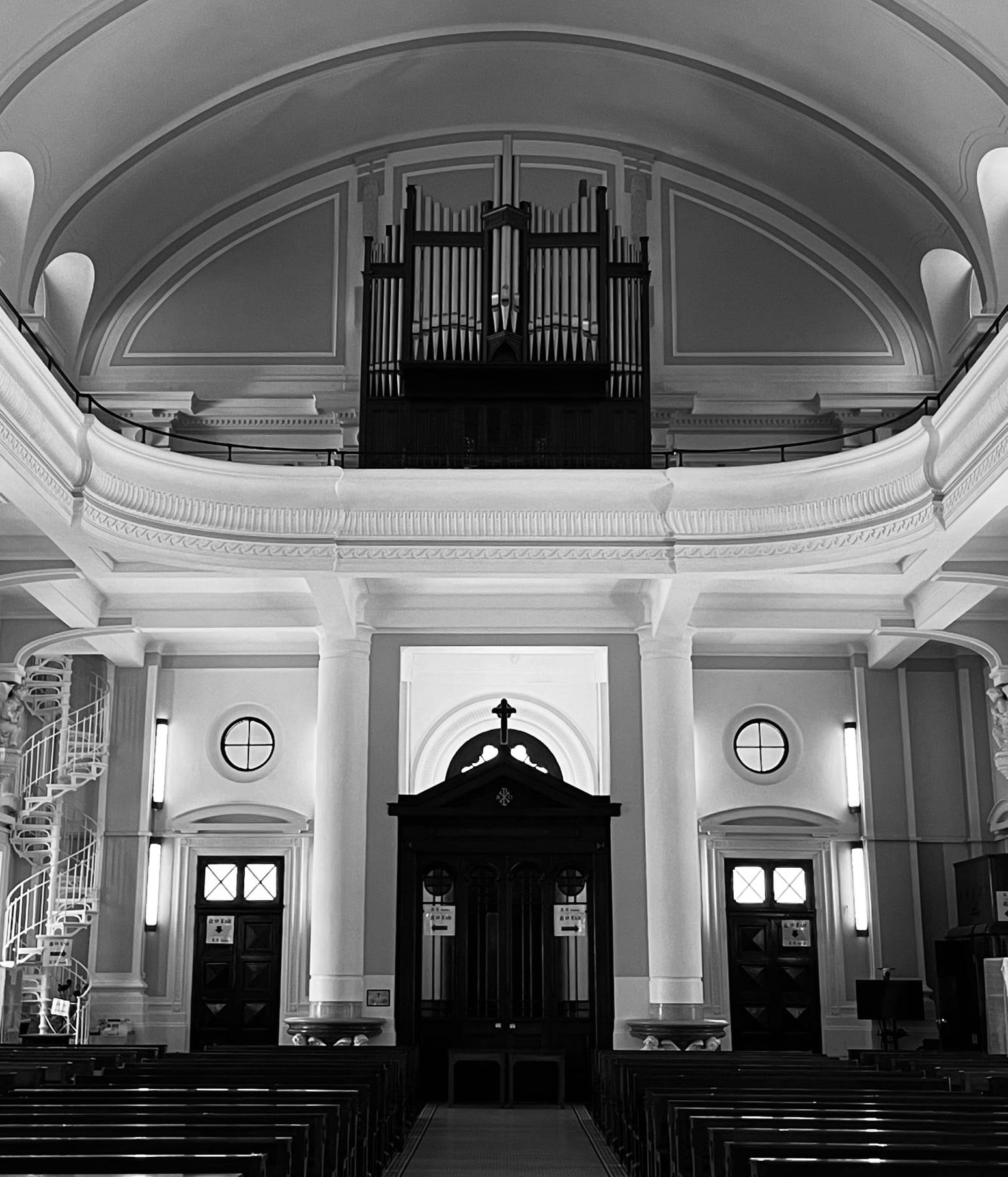
HKG1930, May 2021 (photo by Karen Yeung.)
Organs in the Census: 193
Year-to-date hits: 13,812
Hits since launch (June 2018): 29,396
The Pipe Organ in China Project Website: Updates for April 2021
30 April 2021
One of only two updates this month concerns HKG1927b, the two-manual organ by William Charlton Blackett installed in St. Margaret Mary Church in Happy Valley, Hong Kong. Our colleague Lee Ping Yin, who has been investigating the current state of the organ, reports a number of interesting facts about this installation. The page on the website has been updated, although many questions about this organ and its history remain to be answered.
We have also heard that a new organ in being planned for Chongqing, in Sichuan Province. As we learn further details about this organ we will post them here. If and when this new instrument is installed, it will be only the second recorded organ in Chongqing (Chungking), and the first installation in almost a century.
Stay safe and wear your mask!
Organs in the Census: 193
One-year to date hits: 13, 755
Total hits since Launch (June 2018): 28, 755
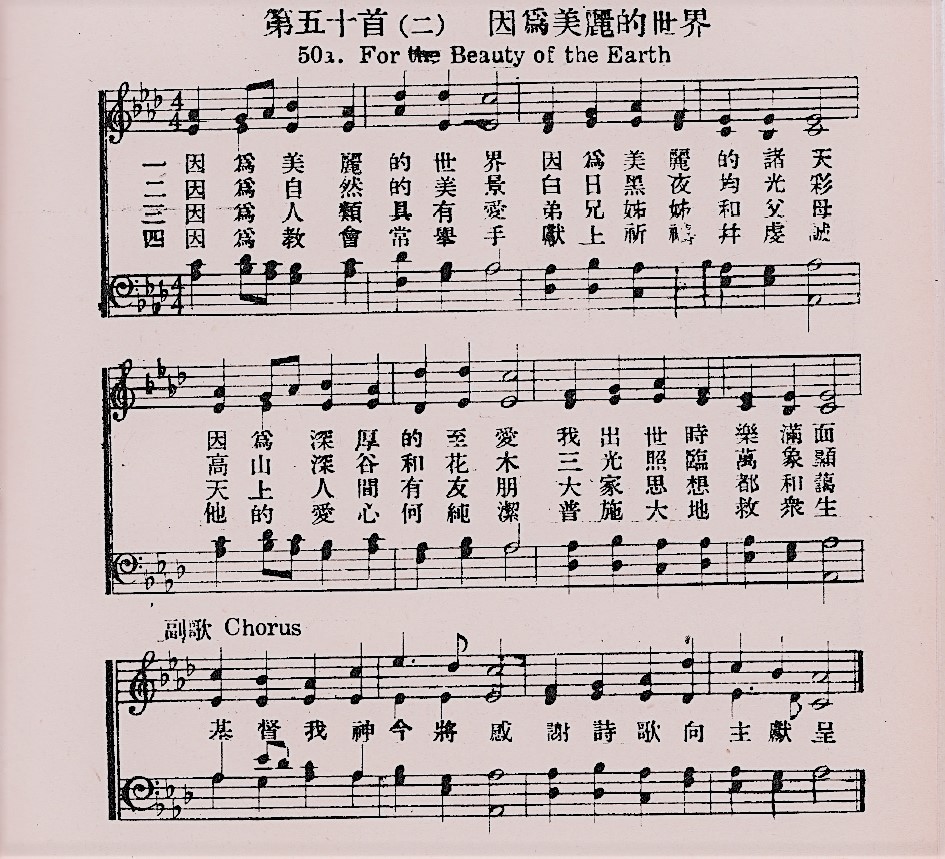
From “New Hymns of Praise” (Shanghai, 1941)
The Pipe Organ in China Project Website: Updates for March 2021
31 March 2021
Minor updates have been made to pages for PEK1920, SHA1933, and HKG 1973.
An interesting project has begun in Hong Kong to document organs in the territory. The chamber ensemble, Concerto da Camera, has begun to release short videos (in Cantonese, with English subtitles) on their YouTube page, with discussions of some of the organs in a series called In Search of Hong Kong’s Pipe Organs and their Communities. One of these videos, featuring HKG1990, can be found here: https://www.youtube.com/watch?v=wmMX8YeD9Dc
Further videos of organs in Hong Kong are planned and are also posted to their Facebook page. Their YouTube main page can be found at: https://www.youtube.com/channel/UCnSk7RYYBEFZXNO_B8sB6pw
The Project wishes all our friends and visitors a joyous Eastertide. 復活節快樂!
Organs in the Census: 193
One Year-to-date hits: 13,278
Hits since launch (June 2018): 27,355
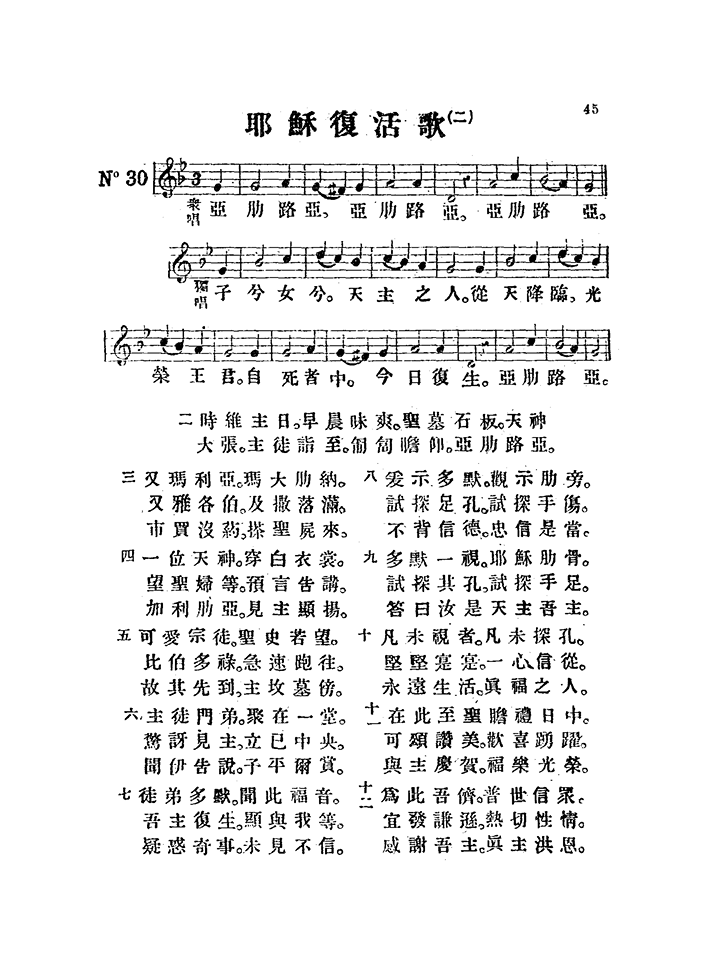
The Pipe Organ in China Project Website: Updates for February 2021
27 February 2021
Minor updates have been made to the Errata list for Keys to the Kingdom.
As mentioned briefly in the December updates, The Project can now confirm that the new organ for the Cathedral of St. Ignatius Loyola at Zikawei (Xujiahui), Shanghai, is tentatively scheduled for installation later this year, pending travel restrictions and other unknown quantities due to the ongoing COVID-19 epidemic. This instrument will be a successor to the Walker organ (SHA1883a) originally installed in Holy Trinity Cathedral, renovated and moved in 1925 by Harrison and Harrison to the Zikawei church.
The new III/34 organ will be built by Diego Cera Organ Builders, Las Piñas, Philippines. The organ, spread over three side of the gallery, will have solid state electric action, and slider windchests with electric pulldowns. Below is a photograph, taken by Prof. Urrows in April 1990, of the organ gallery following the reopening of the cathedral after the Cultural Revolution. The two CAD images show the design for the new organ, and are presented here by permission of Diego Cera Organ Builders.
In other news, C.B. Fisk has announced contracts for two pipe organs to be built in a new building of Hong Kong Baptist University (where The Project was founded in 1989). The larger recital instrument will be a III/33 organ, and the practice organ will be III/7. Completion is presently scheduled for 2024. Further details are available here:
http://cbfisk.com/opus/opus-158/
http://cbfisk.com/opus/opus-159/
Organs in the Census: 193
One year-to-date hits: 13,113
Hits since launch (June 2108): 26,350
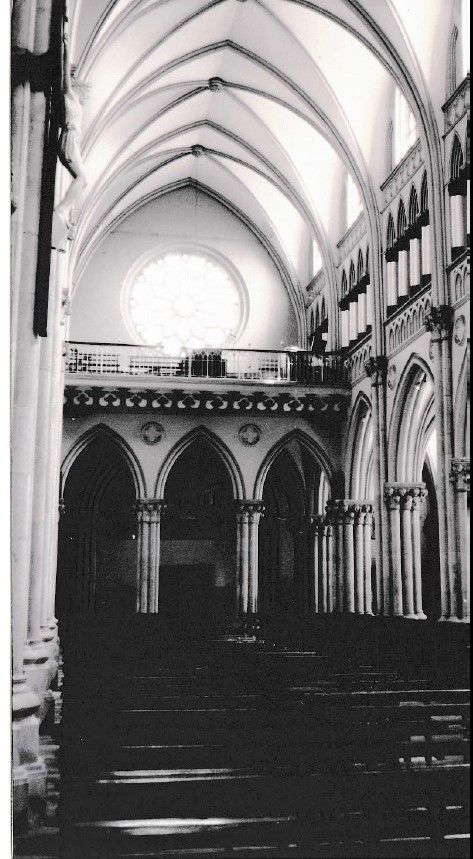
Zikawei, Cathedral of St. Ignatius, Easter Sunday, 1990. Looking eastwards towards the organ gallery.
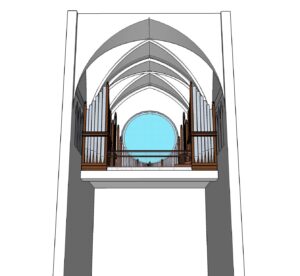
CAD design by Diego Cera Organ Builders for the III/34 organ in St. Ignatius, Zikawei. Used by permission.
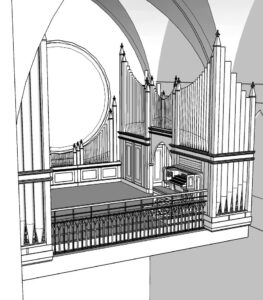
Isometric view of the planned new organ, Zikawei. Used by permission.
New Data on HKG1921, and Herbert Westerby, F.R.C.O.
4 February 2021
Prof. Urrows writes (post revised 7 July 2022):
Some of the best discoveries are made when you are looking for something else. This happened to me at the end of January. I was looking for the publication date of Herbert Westerby’s massive The Complete Organ Recitalist (London: Musical Opinion, 1927, as it happens).
On page 321, in the section “Noted Organs in Other Colonies”, I was struck to see China with three listings: the Harrison and Harrison organ in the “Shanghai Cathedral” (SHA1925); followed by an organ in Hong Kong, identified as located in the “Hong Kong Cathedral”; and then a third organ, the Walker in “Hong Kong, St. John’s Cathedral”. This last is HKG1887, rebuilt by William Charlton Blackett in 1927, a fact which Westerby probably did not know at the time. (see pic below)
What then was the “Hong Kong Cathedral”? This can only be, by default, the Roman Catholic Cathedral of the Immaculate Conception, with its Bianchetti e Fachetti (HKG1896) organ, rebuilt by Blackett in 1917-1921 (HKG1921), while he was still a partner in organbuilding firm Blackett & Howden (as noted by Westerby.)
However, looking at the entry there is an anomaly. The Shanghai Harrison is given the date of 1921, which is clearly wrong (it should be 1925). The Blackett and Howden rebuild of the Facchetti organ is given no date (and should be 1921); and the old Walker in St. John’s is given correctly (1887). I suspect that the 1921 date is supposed to go with the second organ in the list, the Blackett and Howden rebuild, and that the long-delayed 1925 installation of the Harrison in Shanghai, as well as the rebuilding of the old Walker in Hong Kong, were both facts unknown to Westerby when he finalized his book, probably sometime in late 1926.
Now comes the really interesting part: Westerby gives the specs of the Blackett and Howden HKG1921 as 3 manuals and 60 stops! This means that Blackett added an additional manual, five new stops, and redistributed them all over three manuals, in addition to making the organ a pneumatic action instrument and building a new case, soundboards, and really only reusing the 1896 pipe work. It also means that HKG1921 was by number of stops, if not of pipes, the largest pipe organ to be installed in China until the IV/93 Rieger (HKG1989) in the Concert Hall of the Hong Kong Cultural Centre in 1989.
This also means that the entry in the 1921 Dictionary of Organs and Organists, for the “Roman Catholic Cathedral, built by Blackett and Howden. 2 Manuals”, acknowledges the rebuilding, but gives the old original specs for the Bianchetti e Facchetti organ. The database entry for HKG1921 has now been updated to reflect this new data. Blackett went back to work on the instrument in 1937-38, but this appears to have been just a major maintenance overhaul, partly due to insect damage and the consequent rebuilding of the organ loft.
Finally, who was Herbert Westerby? He was born in Huddersfield ca. 1865 (some sources give 1861), and was a distinguished British organist, pianist, and conductor. He studied with E.H. Turpin, Henry Parratt, and James Higgs, and held a Mus. Bac. from the University of London. He was an F.R.C.O., and a Licentiate (L.Mus.) of Trinity College of Music, London (a much more prestigious diploma then than it is today) and a BBC recital organist He composed a few works, including a Te Deum for five voices, and an anthem, God be in my head. He was organist of various English churches, spent some years in South Africa (at Grahamstown (now Makhanda) and Kimberley), and then returned to the UK, where he was organist at churches in Elgin, Linthorpe, and Kirkcaldy in Scotland, and later in the London area at Erith, at finally at Christ Church, Ealing, from 1921 onward. Westerby was also Secretary of the Hymn Tune Association. In addition to The Complete Organ Recitalist, he wrote a number of articles and other books, among them a follow-up volume:
The Complete Organ Recitalist: International Repertoire Guide (1931)
and
How to Study the Pianoforte Works of the Great Composers (1913)
Introduction to Russian Piano Music (1924)
The History of Pianoforte Music (1927)
Beethoven and his Piano Works (1931)[1]
Liszt, Composer, and His Piano Works (1936)
Westerby died in Bath in 1949.
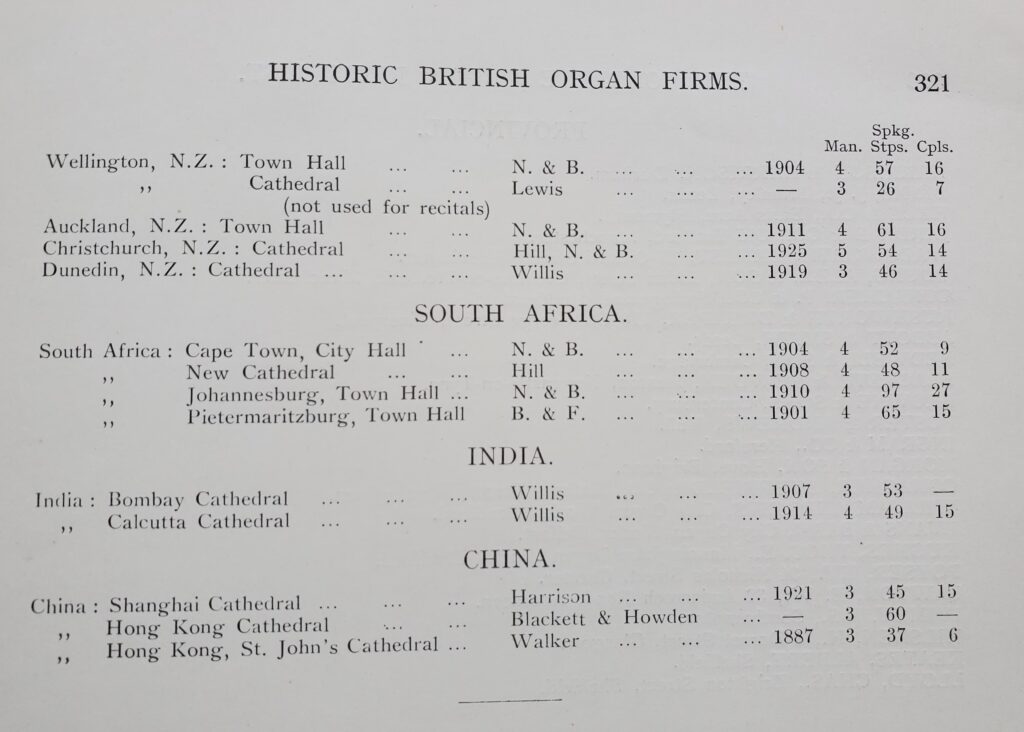
Entry from Herbert Westerby, The Complete Organ Recitalist (1927)

Westerby (aged 79) advert in The Musical Times, August, 1944.
[1] Westerby has not been entirely forgotten as a musicologist. See: William Meredith. “The Westerby-Meredith Hypothesis: The History of the Eroica Variations and Daniel Steibelt’s Fortepiano Quintet, Op. 28, no. 2” The Beethoven Journal, 27/1 (Summer 2012). 26-44.
The Pipe Organ in China Project Website: Updates for January 2021
30 January 2021
Several updates relating to organs installed in Beijing by the German firm, Oberlinger, have been made this month:
The first is, that we are finally able to post the specs of PEK2005a. The Project believes that these specs are substantially the same as those of the other, and slightly smaller organ built by the same firm in 2005 (PEK2005b) for another newly-built TSPM church in Beijing, although we would like some day to eventually confirm this with a site visit.
The second Oberlinger we have to report on, is a II/11 practice instrument, installed at CCOM (Central Conservatory of Music) in Beijing back in 2013. Reports of this organ had come to us, but it was only this month that we actually saw some photographs of it, and were able to confirm its existence (it is apparently located on the 14th floor of one the Conservatory’s newer buildings.) This instrument has been given the Census identifier PEK2013. The Project would like to thank Prof. Shen Fanxiu for her assistance.
We have also learned of a 3½ stop stock model positive by Oberlinger, installed around 2003 in a private location in Beijing, of which we had not heard earlier. Research into this organ is ongoing.
A link has been added to Links for the new website of the Taiwan AGO Chapter.
Minor fixes have been made to the pages for PEK1989 and PEK2014.
A number of main photos of organs were again been found to be mysterious tipped 90o out of line. Some of the Hong Kong installations were affected, and these have now been fixed. We still do not know why this is happening from time to time.
English-Chinese Glossary of Organ Terms: this long-awaited development undertaken by the Project was posted in an initial form earlier this month. This is based on a list prepared by organ enthusiast Peter Cheung Pei-tak (張彼得) for his 1975 book, Pipe Organs, Electronic Organs, and Church Organists (Hong Kong: E.C.F. Sheng Tao Press, 1975). This slim book also includes Cheung’s account of seeing an organ with bamboo pipes in Fuzhou in 1931 (FCW1931), possibly one of the small bamboo organs built in Shanghai by François Ravary and Léopold Deleuze in the 1850s and 1860s. (see Keys to the Kingdom, p. 272, and What’s New for 11 September 2018.)
Lunar New Year begins on 12 February this year, which will be the Year of the Ox. We wish all of our visitors
gung hei faat choi! gong xi fa cai! 恭禧發財!
Organs in the Census: 193
One year-to-date hits: 12,699
Hits since launch (June 2108): 25,418
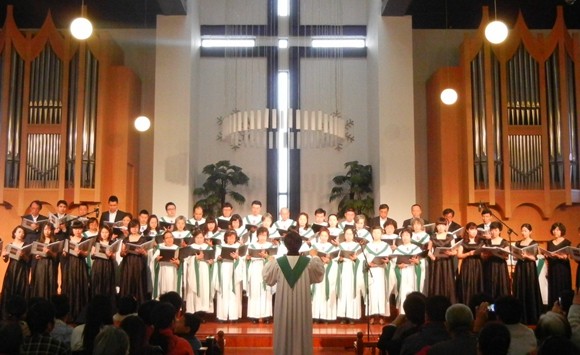
PEK2005a during a choral concert, 2019.
A Glossary of Pipe Organ Terminology in Chinese
19 January 2021
One of the long-term goals of The Project has been to create more resources for intercultural discussions about the pipe organ. Although this is not a bilingual site, for reasons given in the FAQs, we have now put together the first stage of a glossary of terms relating to pipe organs (and a few other organ-like instruments). This is a difficult thing to do. Even in Western languages, organ terms and terminology in, say, English and French are not the same, and not directly translatable. In English for example, we use coupler (n.)/to couple (v.) for all form of coupling organ divisions. In French, the verbs accoupler and tirer are used for manuals and pedals respectively. There are historical reasons for these distinctions which are no longer relevant to organ building practice today, and yet the traditional terms persist.
In China (and Asia generally) the pipe organ is a relatively new object in cultures which date back many millennia. There are only spotty traditions of local building in the work of some missionaries and converts prior to the 20th Century, and a growing record of importation of instruments built in Europe and North America from the mid-19th Century onward . With the first pipe organ in China documented as late as 1600 (MAC1600), terms for the parts of an organ, and of organists and organ culture, have been created haphazardly, and without too much standardization. Nevertheless, a glossary, even an imperfect one, will be a starting point for systematizing this.
At present we have completed a first stage of Chinese terms in traditional characters. Eventually we plan to add the terms in simplified Chinese characters, but this is not as easy as it might appear at first. The terms that are being used, or invented, in Mainland China, are not always the same as those used outside the PRC. This means we cannot just rewrite the traditional characters in simplified characters to arrive at the correct term in current usage. In this connection we would certainly be interested in suggestions and contributions from out readership, for which please use the Contact Us page.
This list is based on an initial list prepared by organ enthusiast Peter Cheung Pei-tak (張彼得) for his 1975 book, Pipe Organs, Electronic Organs, and Church Organists (Hong Kong: E.C.F. Sheng Tao Press, 1975). The Project would like to thank our friends, Erma Sandy Lee, Jessie Lau, CC See, Chan Yik Wai, and Lee Ping Yin, for their considerable contributions to this Glossary.
A Glossary of Pipe Organ Terminology in Chinese
(Version 2021.1.0)
|
English |
Chinese (traditional) |
Chinese (simplified) |
|
action |
作用 / 機械聯動裝置 |
作用 / 机械 |
|
air waves |
空氣浪 / 氣流 |
|
|
bellows |
調節風箱 |
|
|
blower (electric motor) |
風泵 / 電動鼓風機 |
风机 |
|
calcant (manual organ blower) |
手 / 腳鼓動風箱者 |
|
|
cancel (button) |
取消 / 重設 / 重置 |
复位 |
|
celeste (rank/stop) |
天上之聲(音管排 / 音栓名稱) |
|
|
Choir (organ division/manual) |
詩班風琴 / 鍵盤 (風琴其中一排鍵盤的名稱) |
|
|
console |
鍵盤臺 |
|
|
coupler |
聯軸栓 |
|
|
crescendo pedal |
漸強踏板 / 增音踏板 |
|
|
Diapason (Principal, Montre) |
開口基本音管 |
|
|
direct electric action |
直接電力機械 / 聯動裝置 |
|
|
electro-magnetic action |
電磁控制 / 電動磁力機械聯動裝置 |
磁电控制 |
|
(to) draw stops |
拉動音栓 |
|
|
electro-pneumatic action |
氣電聯動 / 電動空氣壓縮式管風琴 |
气电联动 |
|
electronic organ |
電風琴 / 電子管風琴 |
电风琴 |
|
ensemble |
音色組合 |
|
|
flue (pipe/stop) |
笛管 |
|
|
fundamental tone |
基礎音 |
|
|
Great (organ division/manual) |
主風琴 (風琴其中一排鍵盤的名稱) |
大风琴 |
|
Great to Pedal (coupler) |
主風琴與腳部風琴聯軸栓 |
|
|
harmonics/overtones |
泛音或附音 |
|
|
harmonium |
風琴 / 小風琴 |
|
|
hertz (Hz.) |
每秒鐘震盪次數 / 赫茲 [phonetic] |
|
|
improvisation |
即興演奏 |
即兴演奏 |
|
interval |
音程 |
|
|
key (of a keyboard) |
琴鍵 |
琴键 |
|
manual (keyboard) |
鍵盤 |
|
|
Middle C |
中音C |
中音C |
|
mixture (rank/stop) |
混合音栓 |
|
|
modulation |
轉調 |
移调 |
|
mutation (rank/stop) |
多音 / 泛音(音管排 / 音栓名稱) |
|
|
octave (interval) |
八度(音程) |
|
|
octave coupler |
八度音程聯軸栓 |
|
|
Offertory (musical work) |
奉獻禮 / 奉獻頌 |
奉献礼 |
|
overtone/harmonic |
附音或泛音或泛音列 |
|
|
pallet |
風塞 |
|
|
pedal board |
腳部鍵盤 |
|
|
Pedal (organ division) |
腳部風琴 |
|
|
pipe organ |
管風琴 |
管风琴 |
|
pitch |
音高 |
|
|
pneumatic action |
氣動模式 / 空氣壓縮式管風琴 |
气动模式 |
|
postlude (outgoing voluntary) |
殿樂 |
|
|
prelude (incoming voluntary) |
序樂 |
|
|
Prelude (musical genre) |
前奏曲 |
|
|
rank (of pipes) |
一套管 |
|
|
reed (pipe/stop) |
簧管 |
|
|
reservoir (wind) |
儲風箱 |
|
|
scale |
音階 |
|
|
slider |
滑板 |
|
|
Solo (organ division/manual) |
獨奏風琴(風琴其中一排鍵盤的名稱) |
|
|
soundboard |
聲板 |
|
|
sound wave |
聲波 |
声波 |
|
stop |
音栓 |
|
|
string (pipe/stop) |
弦音管 |
|
|
Swell (organ division/manual) |
漸增減風琴 (風琴其中一排鍵盤的名稱) |
|
|
Swell box |
音量調節箱 |
|
|
Swell pedal |
音量腳踏板 |
|
|
Swell to Great (coupler) |
漸增減風琴與主風琴聯軸栓 |
|
|
Swell to Pedal (coupler) |
漸增減風琴與腳部風琴聯軸栓 |
|
|
thumb piston |
拇指按鈕 |
|
|
toe piston |
腳趾按鈕 |
|
|
timbre/tone color |
音色 |
|
|
tracker action |
拉牽機械 / 聯動裝置 |
|
|
transpose, transposition |
移調 |
|
|
tuning |
調音 |
|
|
tuning fork |
音叉 |
|
|
twelfth (interval) |
十二度音程 |
|
|
unison |
齊奏 / 純一度音程 |
|
|
vibrato |
震動音色 |
|
|
volume |
音量 |
|
|
voluntary (U.K. term for work usually played before or after a service) |
(英國)在崇拜開始或結束時所彈奏的短曲 (cf. prelude, postlude, improvisation) |
|
|
windchest |
風箱 |
|
|
wind gauge |
風錶 |
|
|
wind pressure |
風壓 / 風壓 |
风压 |
The Pipe Organ in China Project Website: Updates for December 2020.
31 December 2020
The Project has received news that a contract has been let for a new pipe organ for the Cathedral of St. Ignatius Loyola at Zikawei (Xujiahui) in Shanghai. This three-manual organ will be the first instrument specifically built for the 110-year-old cathedral church, which was completed in 1910. In 1925, a second-hand Walker (SHA1883a), originally built for Holy Trinity (Anglican) Cathedral, was renovated by Harrison and Harrison and reinstalled at St. Ignatius. The fate of this organ is not known, but it was presumably destroyed in August 1966 at the start of the Cultural Revolution, if not earlier. The new pipe organ will be the first major installation in a Shanghai church since before 1949. Further details will be forthcoming.
Prof. Urrows contributed a post to What’s New on Hong Kong organ enthusiast Peter Cheung Pei-tak (張彼得). Cheung was the author of a 1975 book, Pipe Organs, Electronic Organs, and Church Organists (管風琴, 電子風琴, 與 教堂琴師, Hong Kong: E.C.F. Sheng Tao Press, 1975). This slim book also includes Cheung’s account of seeing an organ with bamboo pipes in Fuzhou in 1931, possibly one of the small bamboo organs built in Shanghai by François Ravary and Léopold Deleuze in the 1850s and 1860s. (see Keys to the Kingdom, p. 272, and What’s New for 11 September 2018.
A new photo has been added to CAN1995b, contributed by one of Prof. Urrows’ erstwhile students, and for which we are grateful.
Our attention was drawn to the organization of a new group dedicated to the history and organ culture of Indonesia, Organis Indonesia. They have a Facebook page and an Instagram account (both with text only in bahasa indonesia), but no website of their own. The link to the Facebook page has been added to the Links. The main organ of interest seems to be a ca. 1841-43 Bätz organ, originally built for the Willemskerk in Batavia, as Jakarta was then known. Jonathan Bätz (1787-1849) was a Dutch organbuilder based in Utrecht. Another surviving organ from his workshop was sent to the Dutch possession of Surinam in South America in 1835.
Photo of the Month (below): Bliss Wiant (1895-1975) and the choir of Yenching University, photographed at the Grand Hotel de Pékin in December 1936 after a performance of Messiah. Note the harmonium and piano (or is it another harmonium?) used to accompany the choir, and only three soloists (this was presumably a performance with cuts).
A Merry Christmas to all our friends (as merry as you can…) and we all look forward with expectation to a better 2021.
新年進步!
Organs in the Census: 192
One year-to-date hits: 12,163
Hits since launch (June 2108): 24, 355

Merry Christmas from The POCP
26 December 2020
The Pipe Organ in China Project wishes all of our friends a very Merry Christmas and a Happy (and Happier) New Year. 聖誕快樂,新年進步!
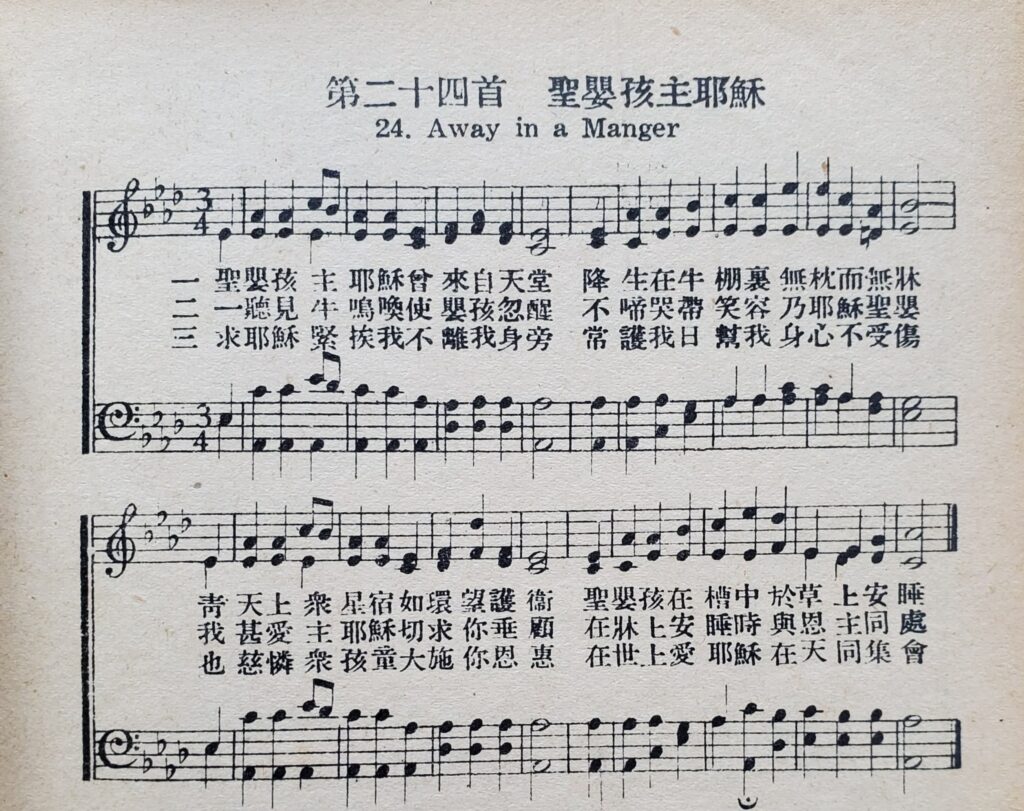
from: New Hymns of Praise (Shanghai, 1941)
Peter Cheung Pei-dak (張彼得), and Hong Kong Organ Culture in the mid-20th Century.
5 December 2020
Peter Cheung Pei-dak (1911-84) was one of three sons of businessman Cheung Kat-shing (張吉盛, 1880-1963), an entrepreneur from Kaiping who founded the once-popular ice cream and confectionary company, On Lok Yuen (安樂園).[1] A distinguished Hongkonger, Cheung was a Trustee of Chung Chi College, founded in 1951 and later (1963) a part of the original amalgamation of the Chinese University of Hong Kong. He was involved in property development (Mann Yip Development, later known as Hong Kong Estates Ltd.), which built among others the old Shatin Heights Hotel (1959; demolished 1979). He was a J.P. (justice of the peace), and the recipient of many awards, including an MBE in the New Year’s Honours List of 1959. But his hobby was the organ, and Cheung was the inventor of some interesting electronic organ devices, which are detailed in his little book, Pipe Organs, Electronic Organs, and Church Organists (Hong Kong: E.C.F. Sheng Tao Press, 1975).
This slim book includes Cheung’s account of seeing a small organ with bamboo pipes in Fuzhou in 1931, possibly one of the small bamboo organs built in Shanghai by François Ravary and Léopold Deleuze in the 1850s and 1860s. (see Keys to the Kingdom, p. 272, and What’s New for 11 September 2018.) Cheung was also an inventor, and he spent years working on an inexpensive “free phase [oscillator] system” analog electronic organ. He was a friend of British organist Lindsay Lafford (1912-2014), who was organist at St. John’s Cathedral in Hong Kong from 1935 to 1939. They maintained contact even after Lafford left Hong Kong at the start of the Second World War.
Forgotten for these pioneering activities today, Peter Cheung was just someone ahead of his time. His efforts to produce, locally in Hong Kong, a superior electronic organ at low cost for Asian churches (at a time when Hong Kong was, ironically, a center for cheap electronics manufacturing) never got off the ground; and his attempts to develop an interest in and appreciation of organ history in Hong Kong and China found no audience at the time. After On Lok Yuen was wound up in 1974 he migrated with his family to Australia. There, Cheung was a member of the Society of Organists (Victoria), Australia, ran an amateur radio station, and he died in Melbourne in 1984.
The Project would be interested in hearing from anyone with recollections and/or more information about Peter Cheung.
[1] An online history of the company can be found here: https://industrialhistoryhk.org/a-slice-of-heaven-the-story-of-on-lok-yuen-%E5%AE%89%E6%A8%82%E5%9C%92-pioneering-ice-cream-biscuit-and-confectionary-manufacturer-and-restaurant-chain/
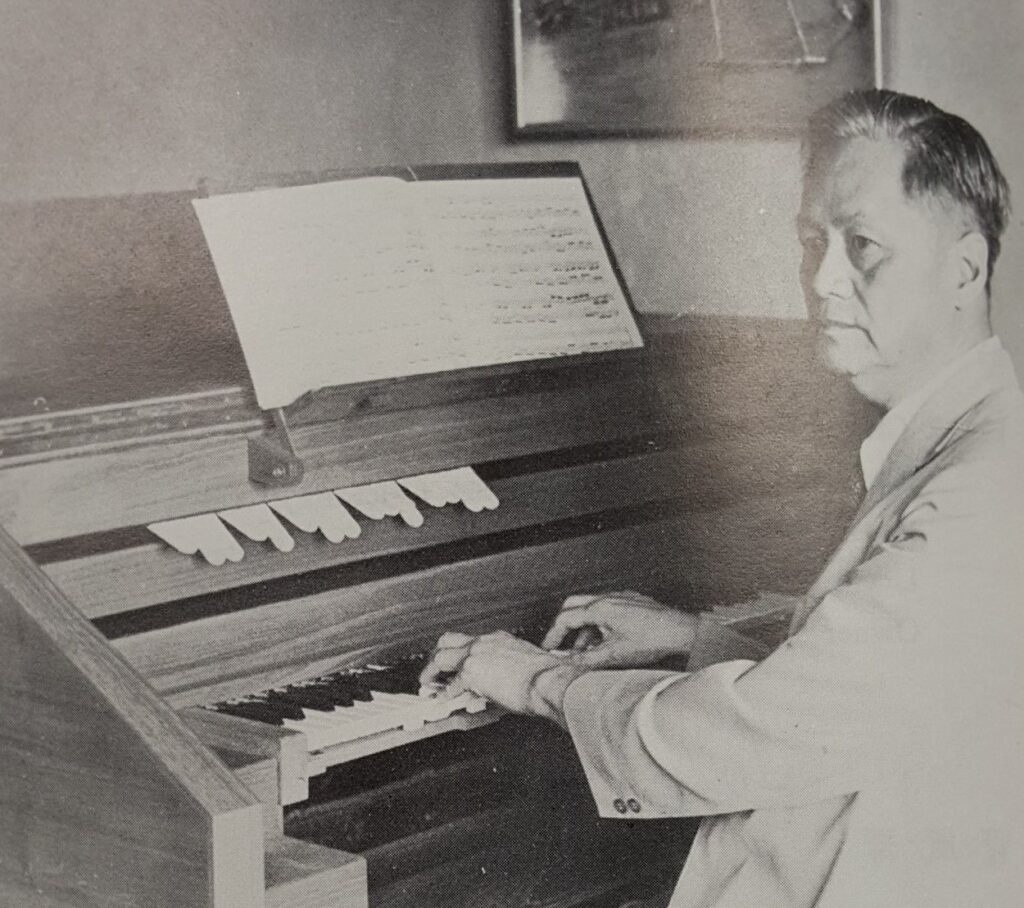
Peter Cheung, 1975, at the console of an unfinished one-manual free phase oscillator electronic organ.
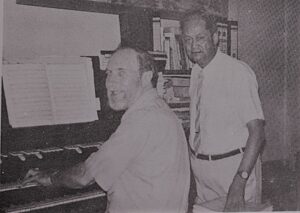
Lindsay Lafford and Cheung at one of Cheung’s electronic organs, 1974.

The London Gazette, 30 December 1958. As a J.P., Cheung is styled ‘Esq.’
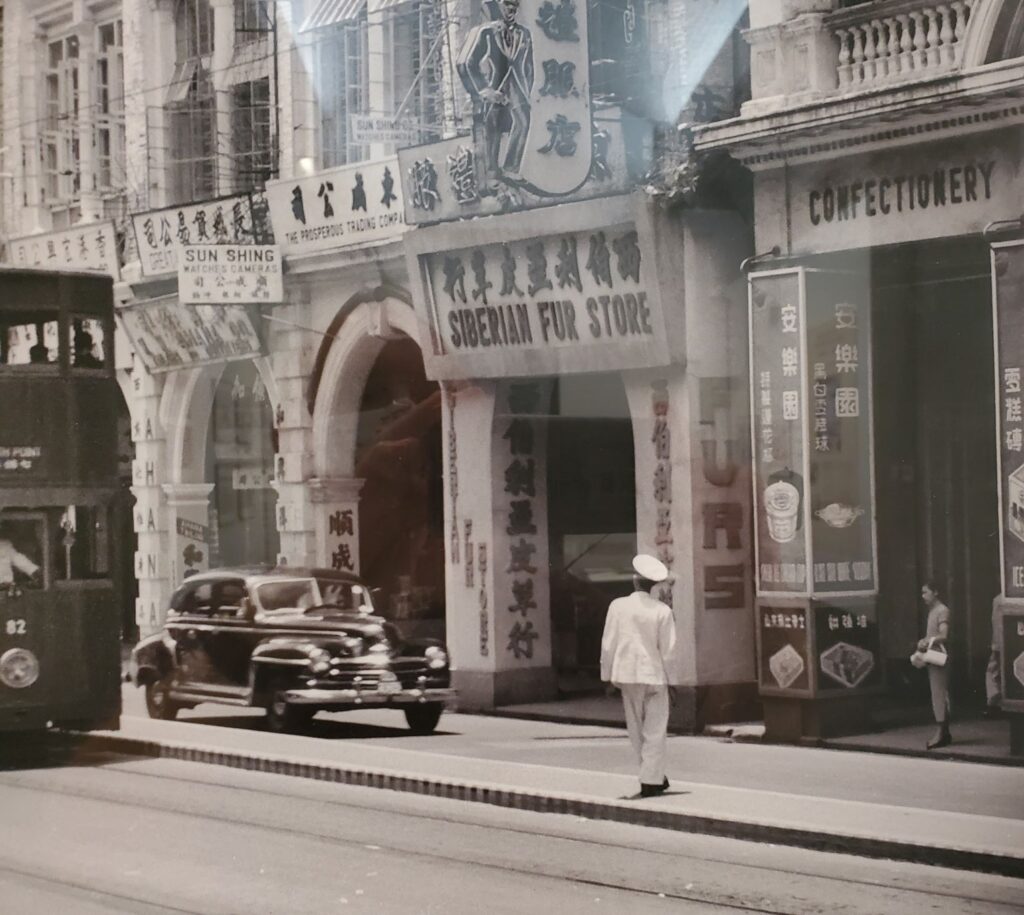
Queen’s Road Central, Hong Kong, ca. 1947. The On Lok Yuen Building, with a retail shop with the word, “Confectionery” over the doorway. Notice the tram heading eastwards towards North Point.
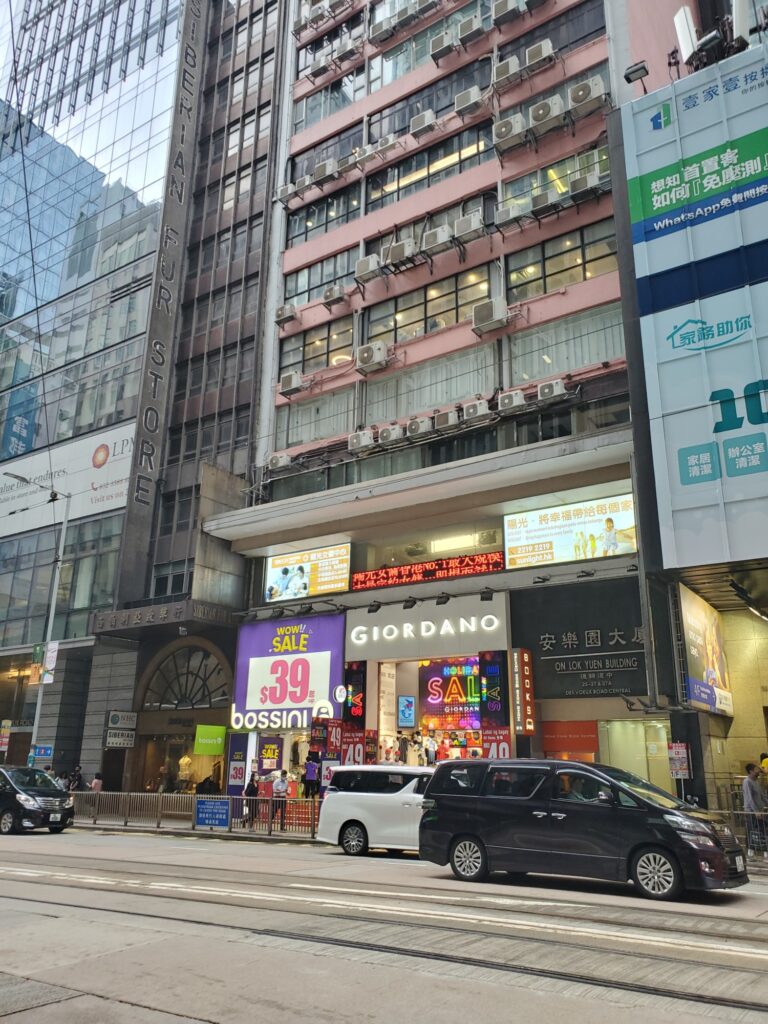
The same site in 2022. Notice the tram tracks, and that the Siberian Fur Store is still next to the 1960s On Lok Yuen building!
The Pipe Organ in China Project Website: Updates for November 2020.
29 November 2020
We have received word that the 1908 Hinners pipe organ Op. 839 (NBO2018) that was moved to Ningbo in 2018, was badly damaged during the passage of Typhoon Mitag in early October 2019. This storm caused water leaks in the bell tower of the church that ran down to the organ gallery, dissolved the glue in the windchest table, and which then dripped into the key mechanism. At present the organ is unplayable and has been dismantled, but it is hoped that over the next several years the time and money will be found to repair it.
A most interesting, not to say unique, video about this organ, its remarkable move from the USA to China, and the 2019 catastrophe, “A Walking in Love Story”, can be seen here: https://www.youtube.com/watch?v=eG1kXs6F630&t=12s
Prof. Urrows’ lecture on François Ravary SJ and his development of a Sino-European musical culture in mid-19th C. Shanghai, was delivered via Zoom on 11 November to the Macau Ricci Institute at the University of St. Joseph in Macau. It has been recorded and can be seen here on YouTube: https://www.youtube.com/watch?v=IhXNUZ1i9rw&feature
A link has been added to the Links for the web page of the Japan Organ Society. This is not actually the journal of the Society, orugan-kenkyū (オルガン研究, Organ Research, est. 1973), but an occasional list of meetings, concerts, and organ events in Japan reported by the Society. It has not been updated since the summer of 2019, perhaps due to the COVID-19 epidemic.
Organs in the Census: 192
One year-to-date hits: 11,308
Hits since launch (June 2108): 23,008
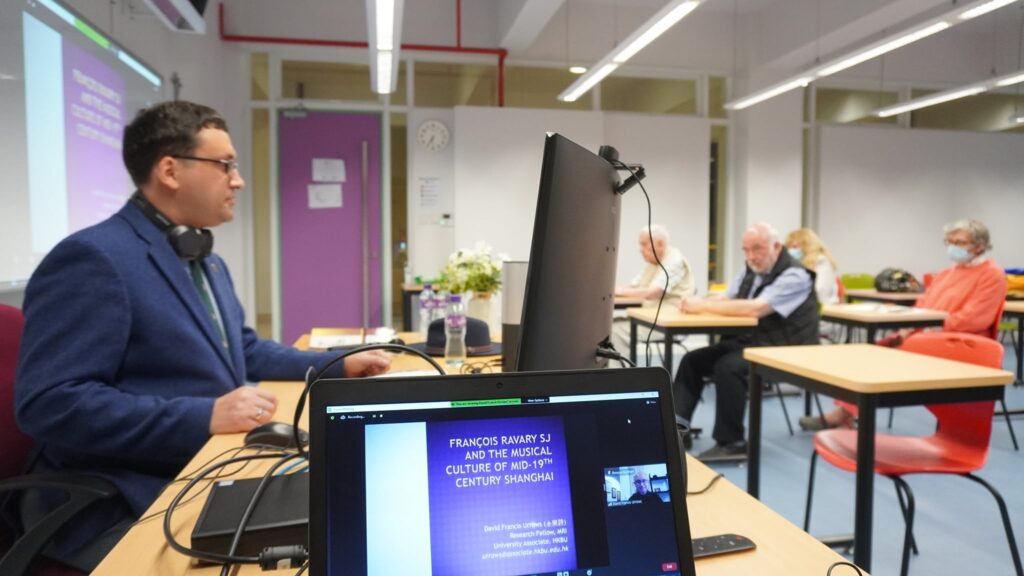
Father Jaroslav Duraj moderates the Zoom lecture given from Manila by Prof. Urrows on François Ravary and the Jesuit Musical Culture of Mid-19th C. Shanghai, University of Saint Joseph, Macau, 11 November 2020
The Pipe Organ in China Project Website: Updates for October 2020
2 November 2020
There are no new pipe organ installations to report this month, but word has reached us that the long-postponed renovations to the Cathedral in Macau have started, and that this will include the installation of the new Casavant organ, we hope by the end of next summer.
The October updates have been delayed by two days so that we could provide the link for Prof. Urrows’ interview with Guy Whatley, published 1 November in the online organ journal, Vox Humana.
Dr. Whatley discusses The Pipe Organ in China Project, Keys to the Kingdom, and a variety of related topics with Prof. Urrows, and we are very grateful to everyone at Vox Humana for their interest in this work. The interview can be found here: http://www.voxhumanajournal.com/urrows2020.html
Organs in the Census: 192
Year-to-date hits: 10,231
Hits since launch (June 2108): 21,305
Photo of the month: Advertisement for a foldable reed organ, from Guide to Catholic Shanghai (1937). The price is (still) in ‘dollars Mex’. These simple, ‘portable’ harmoniums were made by many small firms in China at the time, as well as larger companies, such as Moutrie’s. They continued to be made in the 1990s, when Prof. Urrows saw them for sale in music stores in Shanghai and Guangzhou.
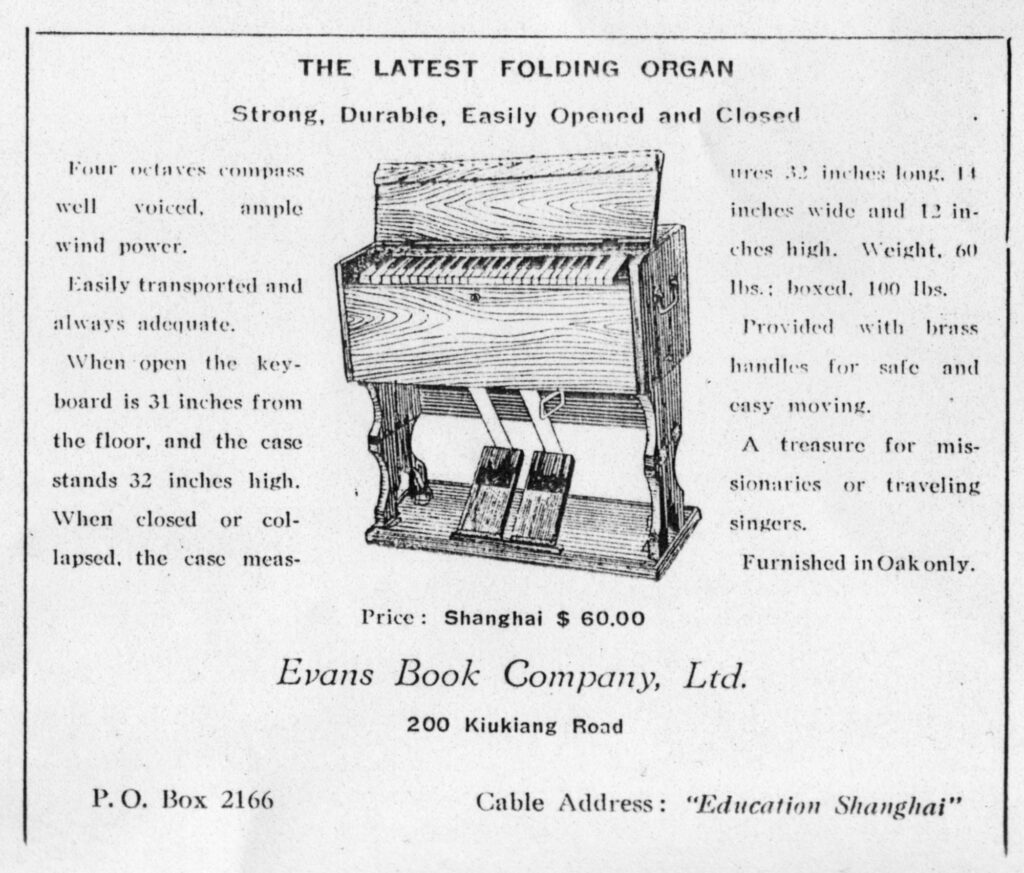
The Pipe Organ in China Project Website: Updates for September 2020.
30 September 2020
The following updates have been made on the POCP website this month:
MAC1831, small updates to images and text.
SHA1881, minor updates to text.
A new blog post from Prof. Urrows, about the controversy in 1865 over the design of Holy Trinity Cathedral in Shanghai, was posted on 2 September.
Prof. Urrows’ article, “Life and Death at Dongjiadu: A Jesuit writes during the Taiping Rebellion”, was published in Vol. 6 of The Journal of the Macau Ricci Institute (in English and Chinese.) Prof. Urrows is a Research Fellow of the Institute. This article concerns François Ravary SJ, the ‘mastermind’ behind SHA1857 and all the other bamboo organs built at Zikawei and Tushanwan. Please following this link to download the article:
Finally, The Project was sorry to learn, belatedly, of the death of Herr Dr. Paul Steinmeyer, on 3 August 2019, at the age of 85. Dr. Steinmeyer was the heir to Orgelbau Steinmeyer, a venerable firm of German organ builders in Oettingen, Bavaria, which closed down in 2001. Dr. Steinmeyer kept the factory is good condition, conducted tours, and the building is now an organ museum. Most importantly, he managed the archives of the firm which operated for 154 years. During the 2000s he provided The Project with important information and documents relating to the one Steinmeyer organ installed in China (SHA1932), as well as to their renovation of the 1909 Link organ in Qingdao (TAO1909) in the same year.
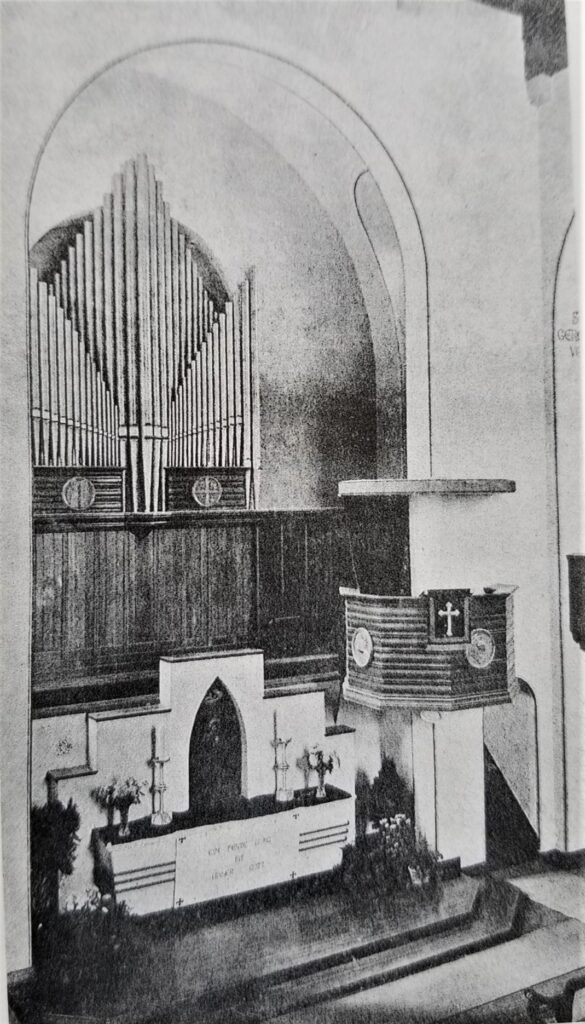
SHA1932, from The Far East Magazine, 1934-36.
Photo of the Month (below): Choirboys rehearsing with a harmonium at Pakhoi (Beihai), Guangxi Province, 1920s or early 30s. Note the two cantors singing from the double music stand, and the harmonium player in ‘civies’.
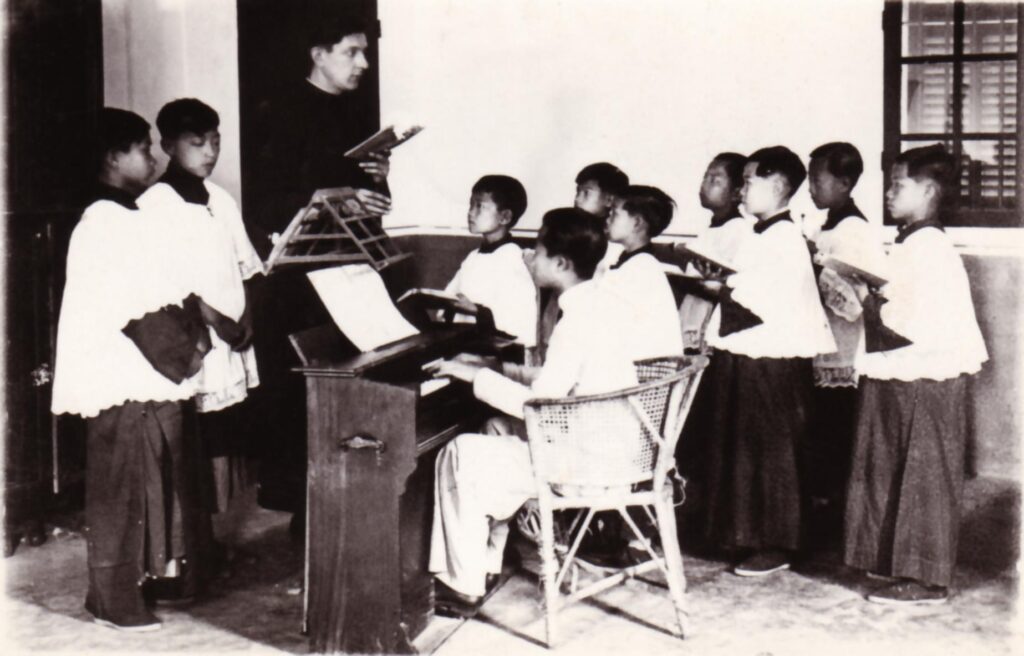
Organs in the Census: 192
Hits over the past year: 10,422
Hits since launch: 20,450
HAPPY MID-AUTUMN FESTIVAL 中秋節
from the POCP.
‘In the name of common sense’: Shanghai and the Anglican Cathedral of the Holy Trinity.
2 September 2020
Prof. Urrows writes:
Having written two posts for this blog on the humorous harmonium (which is somehow easier to poke fun at than the pipe organ) I came across something from research done 30 years ago, that I have always hoped to pass on for its unintentional funniness. This doesn’t exactly have to do with the pipe organ, but is related to one of the churches in China that played a big role in that history: Holy Trinity Cathedral in Shanghai.
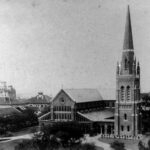 The present building (still standing) was constructed between 1866 and 1869, replacing an earlier structure that had fallen into disrepair. The organ for the earlier Holy Trinity Church was the two-manual and pedal Gray and Davison organ (SHA1856). This instrument was moved into the new Cathedral church upon its dedication in 1869, before being replaced by a three-manual Walker in 1883 (SHA1883a).
The present building (still standing) was constructed between 1866 and 1869, replacing an earlier structure that had fallen into disrepair. The organ for the earlier Holy Trinity Church was the two-manual and pedal Gray and Davison organ (SHA1856). This instrument was moved into the new Cathedral church upon its dedication in 1869, before being replaced by a three-manual Walker in 1883 (SHA1883a).
Shortly before the new church was opened, an irate member of the English community in Shanghai, using the pseudonym ‘Nemo’ (nobody), inveighed in the local newspaper against the new building and its furnishings (specifically the pews) in a letter to the Editor that is worth remembering. Much of this probably had to do with the general dislike of the Sir George Gilbert Scott’s design, modified in Shanghai by a local architect named William Kidner. These sorts of Gothic Revival buildings executed largely in brick, were not too different from the great railway stations of the Victorian era (or vice versa). This can be seen at St. Pancras Station in London, also designed by Scott.
The letter, dated 9 April, appeared in the North-China Daily News on 13 April 1869, under the headline, “The New Church.” The Editor added at the end, that “The bilious climax which our correspondent reaches, in his last sentence, is simply sublime.”
To the Editor of the North-China Daily News.
Dear Sir, — What is going to be done about those church seats? Although removed from the magnificent structure destined at some period to be the new Church, (but which internally is excessively like the Strand Music Hall[1], with a slight dash of Barclay and Perkins’ Brewery[2] about it,) to the more humble shed adjacent, yet from their presence in the compound at all, there seems no doubt of their being misapplied to the purpose to which they were intended.
In the name of common sense I protest against such uncomfortable benches being accepted; surely they cannot have been made from any design! If they were, I suggest that they be presented, accompanied with an address and a leather medal, to the able individual who conceived such perfection in the way of ugliness and discomfort.
We have all subscribed liberally to the Church, but rather than it should be disfigured with seats like those made for it, let us subscribe again, to have proper, partitioned, comfortable benches, instead of these abortions between a school form and a garden seat.
When in the Church two days ago, I studied the architecture and formation of the choir seats. Foolishly I sat in one, and being rather broad and square shouldered, I regret to say, I was caught by two projecting arms at the height of the shoulders, so that I could with difficulty get out again. These choir seats really are very chaste; but after the first Sunday or two, I fear the fair creatures who so kindly and so beautifully do sing, will be found wanting – unless they retain agreeable reminiscences of the school “back-board”, which these choir seats have been made most perfectly to imitate.
I have seen many churches in England and elsewhere, but I never yet came across one with “bottle green” glass windows. There were, doubtless, intended to add to the harmony of colours so beautifully displayed in the new church. These, for those who have not seen them, it may be well to mention. They are Red, Black, White, Brown, Blue, Stone colour, and Bottle green. The “tout ensemble” may be imagined. In addition to the Music Hall and Brewery style, which have been so ably combined, the Bottle green windows give it another peculiarity, making it strongly to resemble the Greenwich Baths and Wash-houses[3], with a touch of a Corn market.
On Sunday next, I would suggest to church-goers that additional zest will be given to their appetites, and a fruitful subject furnished them for discussion, if, after church, they will visit the structure which will have cost more money than, and exceed in ugliness, any building of the like kind put up anywhere on this earth.
Yours truly,
NEMO
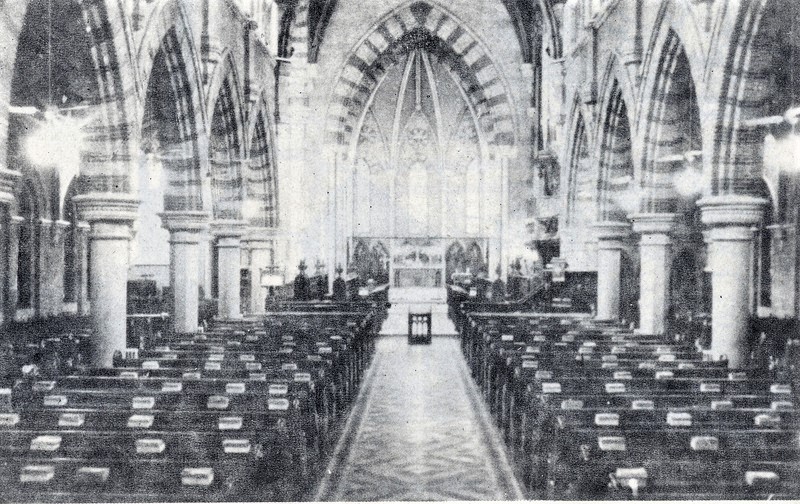
The interior of Holy Trinity Cathedral, Shanghai, about 1890. It seems the uncomfortable seats had been replaced by normal pews.
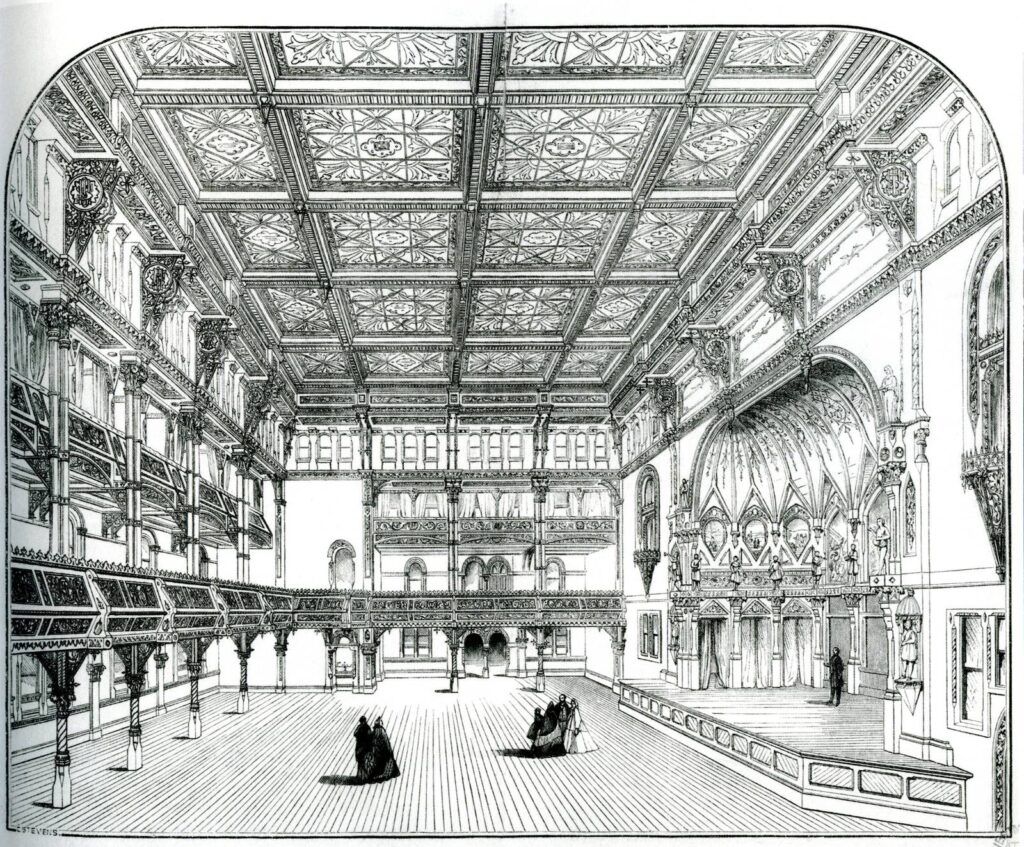
The Strand Musick Hall around 1854: Temple of Culture?
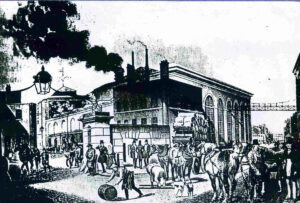
Barclay and Perkins Brewing Co, Park St., Southwark, in the 19th C. Note the tall windows on the right hand side.
[1] Built 1864 on what is now Aldwych in London, but demolished in 1868, a fact that ‘Nemo’ does not seems to have known.
[2] A noted London brewery, located on Park Street, Southwark.
[3] Built 1850-51 on Trafalgar Road, torn down in the early 1920s, and replaced by a new building (1923) now under threat of redevelopment.
The Pipe Organ in China Project Website: Updates for August 2020
30 August 2020
The following things have been updated on the Website during the past month of August 2020:
A previously unrecorded installation, HAR2015, has been added to the Census.
Photo of the Month: The Free Christian Evangelical Church in Shanghai (built in either 1920 or 1939, sources do not agree) at 25 Wulumuqi Beilu, photographed in 2013. Now called the Xin-en (Grace) Church. We cannot trace an organ here, and so it probably made do with a harmonium and/or a piano before 1949.
We wish all our visitors health and happiness and patience to cope with the ongoing epidemic.
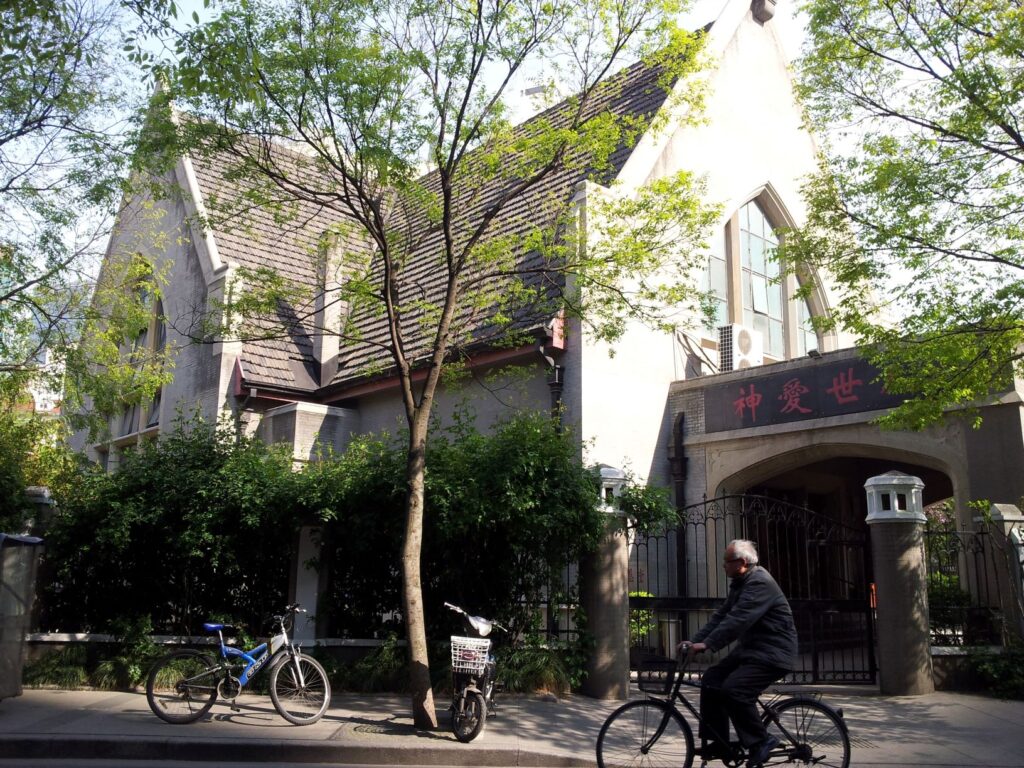
Organs in the Census: 192
Hits year-to-date: 10,432
Hits since launch: 19,678
The Pipe Organ in China Project Website: Updates for July 2020
31 July 2020
The following things have been updated on the Website during the past month:
The Errata list has been updated.
The FAQs have seen a small, comprehensive revision.
There is an update to PEK1687, connected with an email we received from Mr. Guido Schumacher, of Schumacher Orgelbau in Belgium.
Mr. Schumacher reports to us that the engravings in Athanasius Kircher’s Musurgia universalis (1650) which were used for the construction of the automatic playing mechanisms of PEK1680, PEK1682, and PEK1683 by Tomás Pereira, and the organ-fountain built for the Kangxi emperor by Ferdinand Verbiest (PEK1687), are actually based on an earlier source. The book in question was written by the French Huguenot engineer, architect, and inventor Salomon de Caus (1576-1626): Les raisons des forces mouvantes avec diverses machines tant utilles que plaisantes aux quelles sont adjoints plusieurs dessins de grottes et fontaines of 1615. Such ‘borrowing’ by authors was very common at this time, before the concepts of copyright and of intellectual property were developed and accepted.
More importantly, Mr. Schumacher and architect Yves Weinand have built a replica of one of de Caus’ hydraulic organ-fountains. This really brings Flettinger’s description of the 1687 organ-fountain in Beijing to life. Pictures and more information can be found at: http://www.orgel-schumacher.com/fr/references/curiosites/michaelstein-musique-ancienne.
The Project very much appreciates Mr. Schumacher’s communication of this interesting information.
Year-to-date hits: 10,118
Hits since launch: 18,712
Photo of the Month: the interior of St. Saviour’s Church, Guangzhou (Canton). This photo, taken in 2010 in the former London Missionary Society (Anglican) church, shows a ‘fake’ pipe organ: what is installed is actually a Rodgers electronic, with a split chancel façade of dummy pipes on either side of the altar for decoration. The church celebrated its centenary in 2019, and can be found at 184 Wanfu Road in the Yuexiu district. The nearest metro stop is probably Beijing Road on Line 6 of the Guangzhou metro.
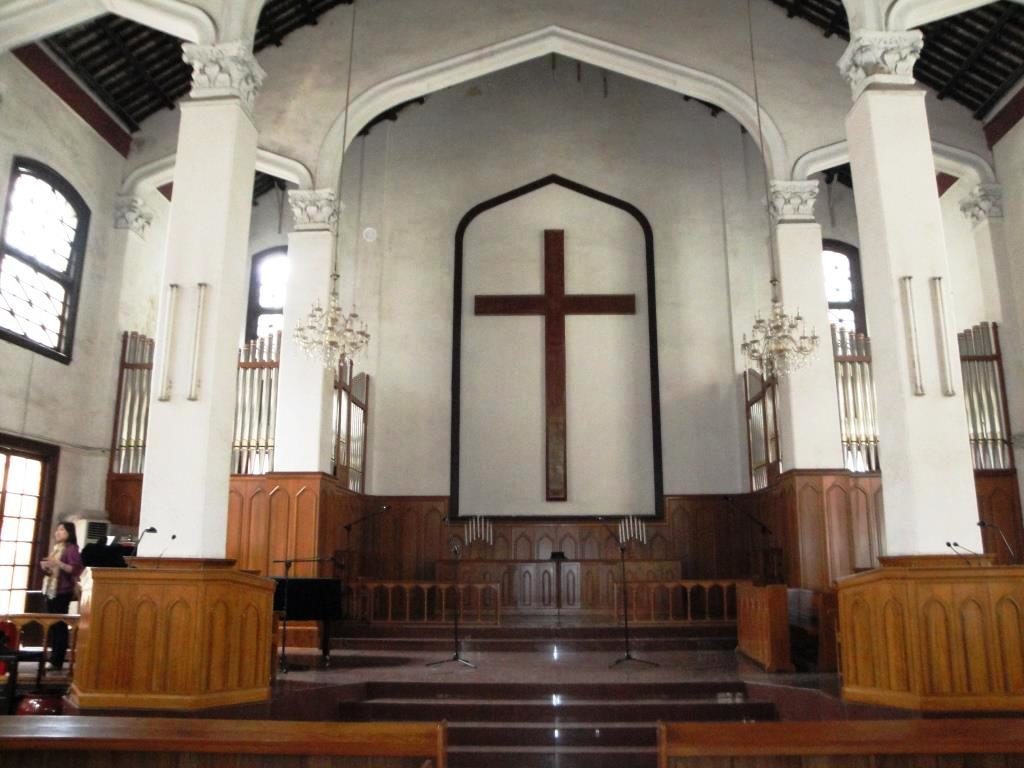
St. Saviour’s Church, Guangzhou (Canton), 2010.
The Pipe Organ in China Project Website: Updates for June 2020
29 June 2020
This month has been relatively quiet at The Project. But a big event occurred on 20 June: the Second Anniversary of the launch of the POCP Website on 20 June 2018. To date we have had 9,182 hits in the past year, and 17,183 since the launch!
The following are the updates posted this month:
- Small updates to HKG1908 and SHA1925
- The Errata list for Keys to the Kingdom has been updated.
- A new blog post from Prof. Urrows, on data relating to the importation of Philippine organs into China in the 17th – 19th centuries.
- Photo of the Month: over 30+ years The Project has accumulated a lot of photographs and images that don’t really fit on pages for individual organs, but that are still a part of the history of the pipe organ in China. So we decided to share some of these, and make this a monthly addition to the site’s Updates.
This month’s photo (below): August or September 1966, Red Guards and students sack the Nantang, Beijing, and burn books and furnishings. The banner hanging on the façade reads “Long live (lit., ‘ten thousand years to’) Chairman Mao!” PEK1890, moved to this church in the late 1950s, cannot be traced after this event.
- Finally, we noticed over this month that some of the photos/images on certain pages had become ‘tipped’ at 90 or even 180 degrees! We have no idea how this happened, or why, and attribute it to an internet gremlin. As we find these skewed images we are editing them back into their proper position. Please bear with us!
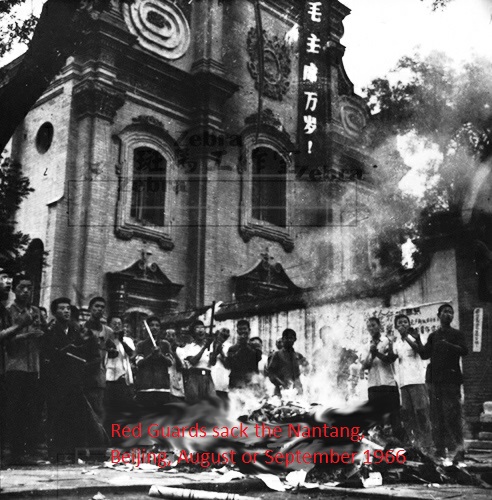
Further Thoughts on some Philippine Pipe Organs in China
19 June 2020
Prof. Urrows writes:
In Keys to the Kingdom, at several points I advanced the hypothesis that some of the organs in Macau and southern China in the 17th Century may have been made in and imported from the Philippines. The first of these is FCW1631, the ‘Western qin’ played by Giulio Aleni to a group of excited onlookers on 8 May 1631 at the little mission at Sanshan in Fujian province (see pp. 41-46). Other such instruments are the organs in Madre de Deus (St. Paul’s) Macau (MAC1670, MAC1701, MAC1709, MAC1743a, and MAC1743b), CAN1678, and finally MAC1831, the organ at the Santa Clara convent, which I believe to be a much earlier organ than its date of first mention. The only pipe organ indisputably known to have come from the Philippines to China is CAN1703, which confirms however that the idea that such a trade is at least plausible.
By way of background explanation I wrote several pages on the complex political situation existing at the time between Spain and Portugal, and between both these nations and China, in particular the enclave of Macau which would have been the natural point of entry for most if not all imported instruments. This was despite the more-or-less consistent ban on trade between Macau and Manila at this period (the ‘dual monarchy’ of 1580-1640). My writing was based on data going back to the mid-20th Century, and I mentioned that the hypothetical importation of pipe organs from Manila had to be balanced by “the lack of documentation about these instruments” which “might possibly hang on the fact that no one in Macau was supposed to be trading with the Spanish at Manila (or vice-versa)” during the dual monarchy, “except during an experimental sanction of commerce in 1629, which was quickly rescinded in 1633.” Almost all my sources were thus Macau or Portugal-based.
Recently I have been reading some new analysis of the trade situation and patterns, in particular an article, published by the Instituto Cultural de Macau in 2003 [1], which looks at the problem from Manila and the Spanish point of view. I had read this article while writing Keys to the Kingdom, but lack of space prevented my using it as a source, coupled perhaps with an over-reliance on Portuguese/Macau sources as definitive.
Prof. Seabra has gone through a lot of trade records (many originating in the AGI – Archivo General de Indias) and has come up with some figures that show that during this period “direct trade from Macao to Manila…was maintained on a regular basis, with the annual arrival of a least one Portuguese ship from China.” This is correct, and also noted in my book: this annual arrival was an official government-sponsored ship, and not a private trader. But it is precisely the private cargo trade (which Seabra calls the “private illegal trad[e]”) that would have taken advantage of the opportunity to ship an organ from the Manila to Macau. This is where Seabra has found new and interesting data. For example, in the period for the hypothetical shipment of FCW1631 from the Philippines to China, Seabra gives the following figures for Portuguese ship arrivals from Macau in Manila:
1629: 2
1630: 6
1631: 3
1632: 4
1633: 3
and then as one would expect
1634: 0
He goes on to quote “annual amounts and percentages of imports subject to tax in Manila.” So, unlike Macau, where there are next to no tax records at all (since no one was supposed to be trading with Manila in the first place) here we find that between 1613 and 1631, Macau imports to Manila (that is, Macau outbound, and not exports back to Macau) varied from between 5 and 36% of all the port tax collected. In 1630 this trade accounted for 35%, amounting to 194,000 ‘Portuguese pesos’ [sic].
Almost all the ships mentioned here had to be private traders, flying the Portuguese flag. If I were a gambler, and believed blindly in my own hypothesis, and if I had to pick a year in which I thought that FCW1631 may have come to China, I would definitely pick 1630 from the list above, based on the number of ships crossing the South China Sea, and the value of their outbound cargo. Seabra’s lists don’t confirm that all these ships returned, or returned safely to Macau (there were sometimes diversions to Macassar, to get around the inbound customs problems.) But it is a new avenue for research on this little corner of the larger topic: where did some of the organs of 17th Century China come from, if they were not built locally?
[1] Leonor Diaz de Seabra. “Power, Society, and Trade: The Historic Relationship between Macau and the Philippines from the 16th to 18th Centuries.” Revista de Cultura, International Edition 7 (July 2003), pp. 46-58.
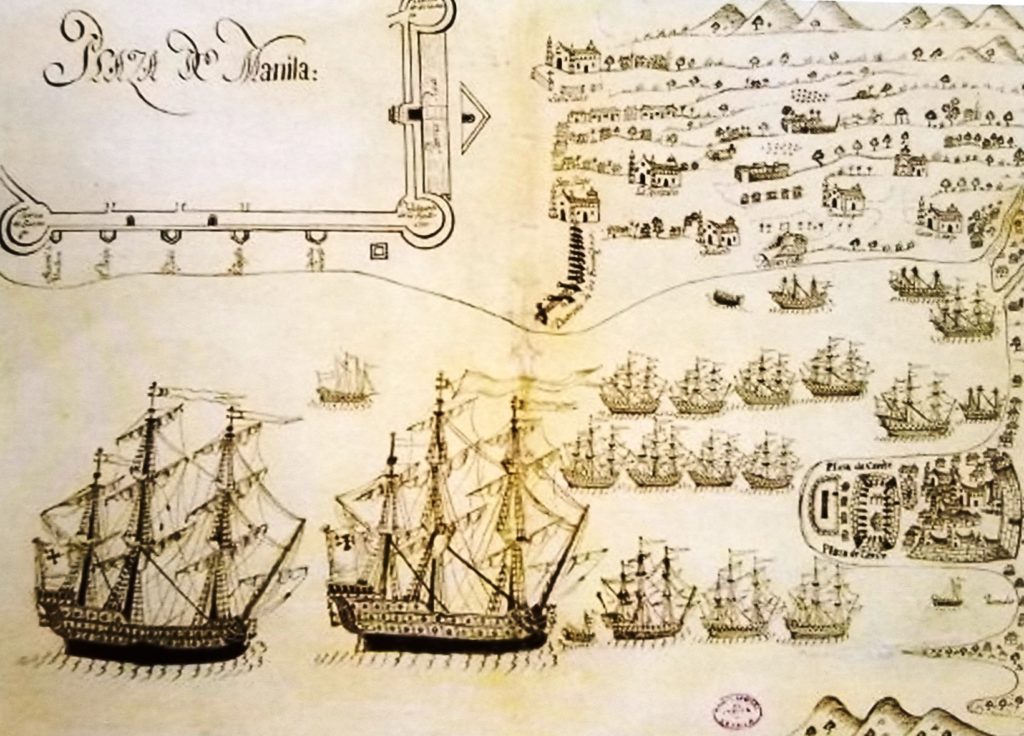
Manila Bay, early 18th C. drawing.
The POCP Website: Updates for May 2020
30 May 2020
Despite the ongoing lockdowns all over the world, there has been a lot of activity at the Project in the past month.
1. New installation: A three-manual concert organ at the New Yunnan Grand Theater in Kunming, built by Freiburger Orgelbau and installed in 2017 (KMG2016).
2. Two blog posts by Prof. Urrows, on George Benjamin Fentum (1843-1914), organist in Singapore, Shanghai, and Australia, and PEK1869.
These three updates were made possible by information sent in by our friends around the world. We would like to thank Lionel Hong, Xu Mengfei, Deirdre Wildy, and Keith Robinson.
A few other changes include:
renumbering MAC2018a to MAC2018 (as the Casavant in the Cathedral of Macau announced for that year has still not yet been installed),
and minor updates to
MAC1831 and
One-year visits: 8,441
Total hits since launch: 15,713
Stay safe, everybody!
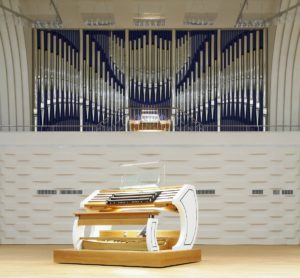
KMG2016
G.B. Fentum (1843-1914): British Organist in Singapore, Shanghai, and Australia.
13 May 2020
The Project does not actively deal with the questions of repertoire or performers in the history of the pipe organ in China, except where these things have some important bearing on the history of instruments themselves. One of the organists mentioned in Keys to the Kingdom, in connection with the Gray and Davison (SHA1856) and Walker organs (SHA1863b, and SHA1883a) in Shanghai was G.B. Fentum, and his name and excerpts from his letters have appeared in publications by the Project going all the way back to Prof. Urrows’ original articles in TAO in 1993.
Recently, we heard from Mr. Keith Robinson in the UK, who is writing what promises to be an interesting book on Sir Robert Hart (1835-1911, long-time inspector general of the China Imperial Maritime Customs) and his musical activities. Hart knew Fentum, and some biographical information on Fentum prepared by Deirdre Wildy (Head of Special Collections & Archives, The McClay Library, Queen’s University Belfast) was passed on to us as well. We are grateful to Mr. Robinson and Ms. Wildy for their help in learning more about Fentum, to which Prof. Urrows has here added his own findings. (Some further information on Fentum in Singapore has been found in the e-book, The Singaporean Soundscape: Musical Renaissance of a Global City, ed. Jun Zubillaga-Pow and Ho Chee Kong (2014), available here: https://www.scribd.com/document/242878621/The-Singaporean-Soundscape .)
Fentum was born George Benjamin Fentum in St. Helier, Jersey, Channel Islands. His father, also named George, was a ‘professor of music’ (meaning simply a music teacher.) His family appears to have been widely involved in music, and the manufacture of musical instruments: a John Fentum (fl. 1774- ca. 1835) was a violinist and music publisher and seller in London, with a shop in the Strand established by his father, Jonathan Fentum. In Keys to the Kingdom (pp. 190-191) G.B. Fentum is discussed in connection with the Walker organ in Shanghai’s Holy Trinity Cathedral (SHA1883a), a major installation that replaced an earlier organ by Gray and Davison (SHA1856), which was in turn moved and reinstalled in the Masonic Hall on the Bund (built in 1867).
Ms. Wildy’s research confirms (as also noted in FN 423) that Fentum first moved from the UK to Singapore in the about 1865. It is reasonable to surmise that he was opening a branch of business for his father or other relatives, as we know that he was importing and selling pianos, instruments, and sheet music. He was also organist of St. Andrew’s Cathedral (1865-72), and director of the Singapore Amateur Music Society. Ms. Wildy reports that he did not like the climate and fell ill, and moved to Shanghai in 1872. His departure may also have been due to his failure to successfully set up a music school there, with a Dutch or Flemish colleague named I.C.H. Iburg. Ms Wildy has found press references to Fentum in Shanghai starting around 1875: accompanying a performance of Cox and Box in 1876; playing piano in a chamber music concert (including a Beethoven piano trio) in 1878; and accompanying what must have a very early if not the first performance of Handel’s Judas Maccabaeus (date not given, but before mid-1886) in China. As noted in Keys to the Kingdom, Fentum, like most of the organists at Holy Trinity Cathedral, was a Mason, and ‘District Grand Organist of the Grand Lodge of Northern China E.C.’ between 1878 and 1886 (see photo).
Ms. Wildy mentions finding a reference from 1878 about the push to replace Holy Trinity’s failing SHA1856 at Fentum’s instigation. Mr. Robinson has established a connection with Hart through a recital Fentum gave at Holy Trinity on 28 May 1886, the eve of his departure for Australia, where he spent the rest of his life. This recital included works by Lemmens, Gounod, Mendelssohn, Guilmant, Bach Beethoven, and Batiste. The previous month he had given a farewell recital at the Masonic Hall, with works by Beethoven (Piano Trio in C Minor, Op. 1 no.3, with a Mr. Ibert, violin (could this have been Iburg?), and a Mr. MacDonald, cello), Charles de Bériot (Violin Concerto No. 9 in A minor, Op. 104), and a piano concerto by Mendelssohn. In Australia “he was responsible for having many organs built there”, according to Ms. Wildy, although we do not have any details about just what installations these might have been. In Keys to the Kingdom, Prof. Urrows noted that Fentum played the Mendelssohn D Minor concerto in Singapore in 1899, and accompanied Elijah at the Town Hall in Melbourne in 1902. Ms. Wildy adds that he was director of music at the Presbyterian Women’s College in Sydney. He died in 1914.
More research should be conducted on musicians like Fentum, who were active in the ASPAC region between the start of the Treaty Port era (ca. 1840) and the end of the First World War. Much could be learned about the musical lives of the time, of the integration and development of audiences and practioners of Western music in Asian environments in the nineteenth century, and about just how these cultural transfers partly led to the saturation and, to some extent, lasting hegemony of Western concert music in Asia. This saturation has long displaced (or at least ‘relegated’, as they say in sports) traditional musics in the urban public eye (and ear), an anomaly that highlights its apparently unshakeable place in modern, developed Asian cultures. Also significant is the fact that Fentum appears to have been one of the only organists in China ever to make his living entirely as a professional musician, and not an amateur organist with a ‘day job’.
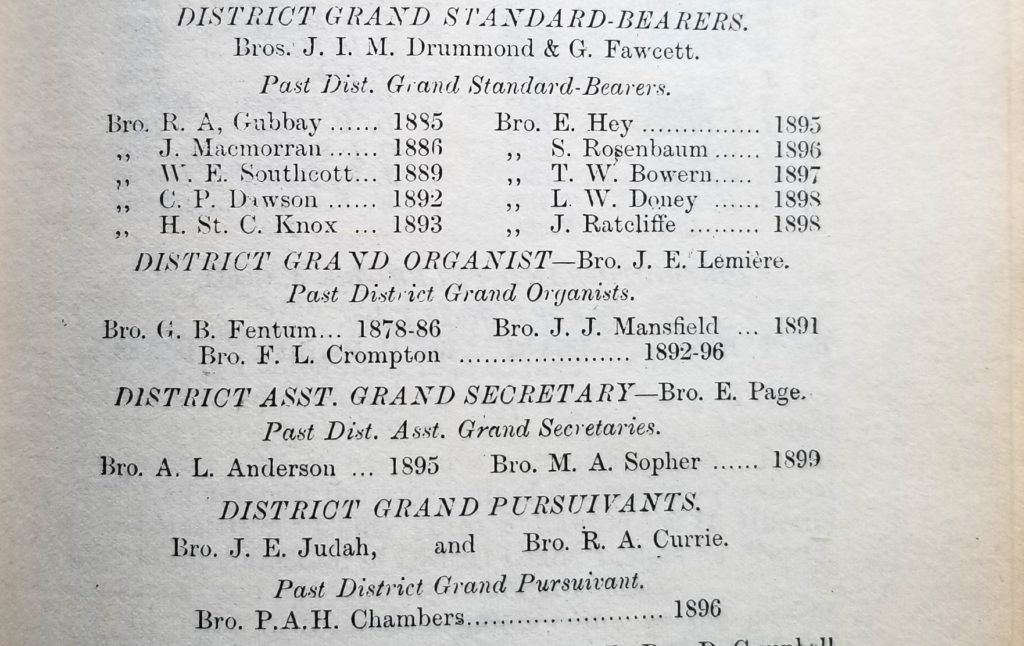
From: F.M. Gratton. Freemasonry in Shanghai and Northern China. Second ed. (Shanghai: Office of the North-China Herald, 1900). Fentum is listed as Masonic organist, 1878-1886. F.L. Crompton, who succeeded to the post in 1892, was also titular organist of Holy Trinity Cathedral.
New Information on PEK1869
9 May 2020
Prof. Urrows writes:
Last month I received an interesting citation from my colleague, Lionel Hong, at Fu Jen University in Taiwan. This is a reference to PEK1869, the Fermis et Castay organ in the New ‘Old’ Beitang in Beijing, about which very little is actually known. The information I received, although slight, helps us to understand more about this mysterious installation, an organ that was at the center the of a minor political struggle between France and China (and the French Lazarists in Beijing) in the 1880s (see Keys to the Kingdom, pp. 178-79, 181-186, and 209-210 for the story of the organ and the church.)
The immediate source for the citation is an article published last year by Liu Qinghua, of Central China Normal University, in Wuhan (who I happened to meet at a conference in Belgium in 2012.) Liu’s article (in Chinese, with a somewhat problematic parallel English translation) is entitled: Textual Research on “The Scenic Illusion Painting of the Feast of the Sacred Heart in Beitang” in National Library of France [sic.], published in Chinese Arts Quarterly (Vol. 6/2, June 2019, pp. 1-35.) Liu’s citation relevant to PEK1869 comes in turn from a document found in the Number One Palace Archives in Beijing, and originally published in Beijing in 1998 in a volume entitled Late Qing-era Studies (清末教案. 第1版. 中囯近代史资料丛刊续编. 北京市: 中華書局, 1998, see pic below.)
The palace document in question is an inventory prepared by Qing government officials in December 1887. This inventory was made immediately after the retrocession by the French Lazarists of the New ‘Old’ Beitang site to the Chinese government. The actual handover of the deeds and the keys to the church was accomplished with a procès-verbal signed by the Bishop, Alphonse Favier, on 14 December 1887. But it had been long preceded by a negotiated agreement, known as the Convention Favier-Detring of August 1886. This agreement between Bishop Favier, Gustav Detring (the French customs chief at Tianjin), and the Chinese, represented by veteran diplomat Li Hongzhang, enraged the French government which considered the site of the old Cathedral to be sovereign French territory. However that may be, in exchange the Chinese government agreed to provide a new site and a build new church (the present Beitang, or ‘North Church’, at Xishiku). It is also known that the Dowager Empress Cixi wanted the organ left in the old church, which she planned to renovate into an audience hall and a kind of theater, and this condition was stipulated in the 1886 Convention. Here is the comment contained in the December 1887 inventory that mentions the organ:
The first [i.e. upper] floor of the church. (Note: In the center of the hall, one large [pipe] organ, inside are 941 pipes in total, outside [the case, near the balcony] railing are 58 additional pipes.
The first thing of interest is the very specific number of pipes – 941. It strains credulity to think that the Chinese officials could have counted the pipes inside the case, and so they probably got this number from Favier and the other Lazarists at the center of the negotiations over the fate of the church and its grounds. I have translated as additional where the Chinese text uses the characters for ‘spare’ (备 用). Of course, they could easily count the pipes in the façade, either from the floor of the building or up in the organ gallery over the South door. But they could not count the ones they could not see, and so in this case I think these 58 façade pipes should be counted within, and not on top of the total of 941 pipes. A less-likely scenario is that the use of the term for ‘spare’ meant that the officials had been told that these pipes in the façade were dummy pipes.
(A further suggestion has been made by one of our visitors that this comment (‘outside the balcony railing’) might refer to a rueckpositif. However, attractive as this idea may be, there are several problems. Rueckpositif divisions were not typical of French organs, although as was pointed out to us the organ at the Abbey in Foix, partly built by the Castay firm in 1869, has one. But this is a large, 40-stop organ. 58 pipes, while reasonable for an organ facade, is too many for the facade of a rueckpositif, and if this was the total interior count, why build a separate division for only one rank? And what, then, would have been under expression? The Grand orgue? The more information we acquire, the larger the number of questions about this organ.)
In any event, these functionaries didn’t even know the accepted term for pipe organ in Chinese, calling it 大風琴 (big harmonium) rather than the established 管風琴 (pipe organ), and repeatedly using the characters 笛 (transverse flute) or 筩 (tube) instead of 管 (pipe).
If the façade contained an entire rank of pipes, perhaps a 4ʹ Montre, or a collection of 8ʹ and 4ʹ diapasons, then we may suppose that the manuals had a range of 58 notes. This is possible, though it is slightly larger than the 56 notes which were characteristic of the organs of Cavaillé-Coll at this date. Based on this manual range, and assuming a 30-note pedal board, I propose the following reconstructed rough specifications:
Total pipes: 941
1 Pedal rank (usually a 16ʹ Bourdon) -30
1 Plein jeu V (5 x 58 notes) -290
621 pipes available for the other manual stops
621/58
=10.7
So, say 11 manual stops, several of which, perhaps including a Viola and a Viola célesté, ran from Tenor C with only 44 or 46 notes, and which would account for the .3 shortfall in the division above. Eleven stops are too many for a single manual organ; so there must have been two manuals.
Result: two manuals and pedal (II/12+Ped):
Grand orgue: 5 stops
Récit: 6 stops (including the possible célesté)
Pedal: 1 stop
and the usual couplers
It would, of course, be most interesting to compare this hypothetical back-calculation with the actual specs of the organ, should they surface someday. And other specs could be worked out from the total pipe count, especially if one removes the hypothetical Plein jeu, and substitutes a simpler mutation such as Nazard.
Finally, the other important thing about this new information is that it has come from a primary source that has absolutely nothing to do with music or the arts. This anomaly has been very characteristic of the research and research approaches developed by The Project since its founding in 1989. It is also at the heart of a fundamental misunderstanding, one by which doors to libraries and archives have been slammed in my face over the years, with the remark “we have nothing about music” offered as some sort of excuse for not wanting to hear me out or help with my research. In this instance, a bit of ‘bean counting’ by palace bureaucracy quite inadvertently preserved important data about one of the pipe organs in nineteenth-century China. It is also significant that this is one of the few bits of data to have emerged from the problematic Chinese ‘palace archives’, which have a very crossed history and of which large parts have been lost since the fall of the Qing dynasty in 1911.
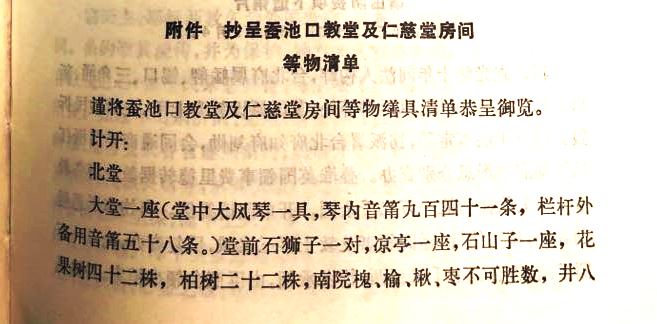
The POCP Website: updates for April 2020
27 April 2020
Despite the continuing lockdowns all over the world due to the Covid-19 epidemic, the Project does have a group of updates for April 2020.
There are updates to the following pages:
MAC1831: new image and small update to text
HKG1908: new image and small update to text
PEK1999b: minor update and link to an interesting interview on the German-language website klassik.com with the builder (Oberlinger) from 1999.
We have also noted that Casavant has released the specs for the organ (Opus 3925) that is supposed to be erected in the Cathedral of Macau. This project, originally scheduled for 2018, has been repeatedly delayed, but the projected specs can be found here: http://casavantfreres.com/Jimdo/ProjectsTables/ProjectsPages/3925-MacauCathedral.html
The Errata/Corrigenda list for Keys to the Kingdom has been updated. To find it, scroll down almost to the end of the What’s New posts.
We would also like to let our visitors know that the main picture on each page (the one in the upper right-hand corner) can be enlarged by clicking on it. Sometimes it can be enlarged twice, and then the last click will return it to its original size on the page.
Stay Safe!!
One-year visitors: 8, 059
Total hits since launch: 14, 514
Updates to the POCP Website for March 2020: The letters of François Ravary S.J.
28 March 2020
This has been an extraordinary month world-wide, and there are as a result no updates to the Census or the Website for March 2020. We hope that everyone is safe and following all the precautions set out in different places around the world, and we can only say that we hope for the best.
Prof. Urrows, however, sent us a communication from his lockdown in Manila. He writes that despite the limitations, and the cancellation and postponement of a research trip on which he is actually supposed to be now, he is still managing to work on his new book, Jesuita Cantat: The Letters of François Ravary S.J., and a European Musical Culture in Mid-Nineteenth Century Shanghai. This research is being funded by the Instituto Ricci de Macau in 2019-2020, of which Prof. Urrows is presently a Research Fellow.
Father Ravary, as those who have read Keys to the Kingdom will know, was the mastermind behind the Shanghai bamboo organ workshop of the 1850s and 1860s. However, he and his colleagues did much more than that: they brought music and music education together as important aspects of the curriculum of the College of St. Ignatius at Zikawei; Ravary founded the first brass band in China (1857), and his colleague, Hippolyte Basuiau founded the first public chamber orchestra (ca. 1870); the organ workshop eventually became part of the musical instrument manufactory at the Tushanwan orphanage, and thus the first place in China where harmoniums were manufactured for public sale.
Prof. Urrows has transcribed and translated eight letters now in the Jesuit archive in Vanves, France, written between 1856 and 1861, for this book. Here is a sample from a letter written in 1857. Ravary writes to Basuiau in Paris about a two-manual and pedal harmonium which was about to be shipped to Shanghai, and of the erection of SHA1857, the ‘Bamboo Organ of Tungkadoo [Dongjiadu]’:
“[W]e have read, re-read, and meditated on the interesting details which you have communicated about the Parisian instrument, now awaited here. Brother Deleuze, our illustrious builder of bamboo organs, is over the moon. He awaits the harmonium, about which so much has been said, with artistic impatience; but he, neither more nor less, wants to compare and evaluate the instrument which you have sent to us with the one that has come from his hands. The future will tell. In a month, the case will be settled.
“Such Chinese pride! you’re going to say? To compare a miserable stick of bamboo with those brass reeds so painstakingly fashioned by a pair of expert hands! What do you expect? Dear Father; it is a pride understandable in an artist, just like a mother madly infatuated with her baby, which she finds beautiful even though it’s the homeliest child in town.
“Joking apart, dear Father, the work on the bamboo organ is now finished. The organ has been placed in a magnificent loft which they built at the Cathedral [of St. Francis Xavier] and which, just to mention in passing, had amplified and decorated the church perfectly. The organ is in place, and after eight or ten days the public will be allowed in to hear it. Our case has been heard, and we have won. Yes, won, because I tell you in all sincerity that our success has surpassed all of my expectations. Today everyone is free to give an opinion, and all the opinions are unanimous in praising the organ and its builder. Thanks to the [design and] construction of the building, and the [resulting] transmission of its echoes, the effect of the [tonal] ensemble is admirable and a marvel!
“The day for the inauguration is fixed for the beautiful Feast of the Assumption [15 August]. On that day, I think, we will have a fine service…”
Further details of the progress on this important new publication from The Project will be posted here from time to time.
One-year hits: 8,350
Total website visits since launch: 13,992
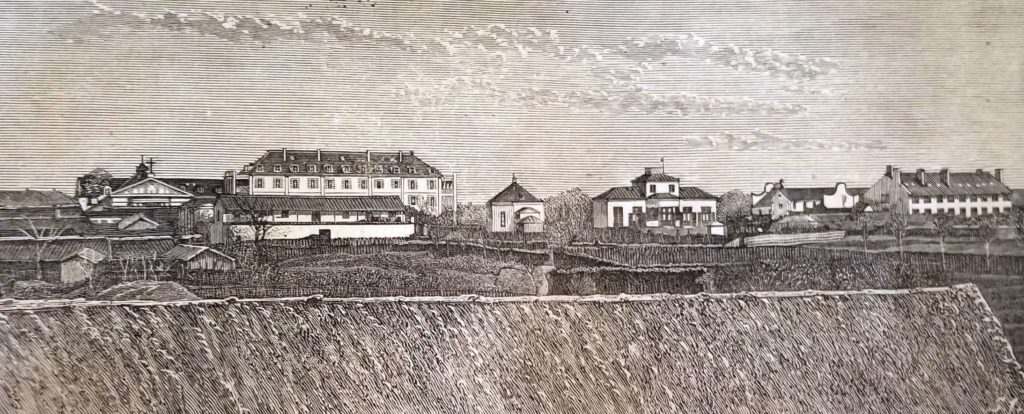
Zikawei, Shanghai, around 1870. The ‘Doric’ Church of St. Ignatius is on the left, followed by the Jesuit Residence, two buildings of the Observatory, and on the right, dormitories and the house of the Auxiliaries of Souls in Purgatory.
Updates to the Pipe Organ in China Project Website for February 2020
1 March 2020
Owing to the relocation of the Project’s files to Manila, things have been a bit slow in the past month.
An interesting communication was received from Dr. Bruce Duncan at The Organ Society of Western Australia. Dr. Duncan created some early lists, still available online, of organs in China, Japan, Korea, Indonesia, Malaysia, Thailand, Taiwan, and Vietnam,. However, he has noted that it has not been easy to keep these lists up-to-date (something we know very well here at the Project.) Nonetheless, we appreciated hearing from him.
We have added to the Links page the links for the Organ Society of Western Australia (maintained by Dr. Duncan), another covering the entire Australian organ scene, and a link for a site dedicated to organs in New Zealand.
Link to Dr. Duncan’s lists (the Korea page is under construction):
China list: http://www.clacklinevalleyolives.com.au/Pipeorgan/China/China.html
Indonesia: http://www.clacklinevalleyolives.com.au/Pipeorgan/Indonesia/Indonesia.htm
Japan: http://www.clacklinevalleyolives.com.au/Pipeorgan/Japan/JapanCity.html
Malaysia: http://www.clacklinevalleyolives.com.au/Pipeorgan/Malaysia/Malaysia.html
Taiwan: http://www.clacklinevalleyolives.com.au/Pipeorgan/Taiwan/Taiwan.html
Thailand: http://www.clacklinevalleyolives.com.au/Pipeorgan/Thailand/Thailand.html
Vietnam: http://www.clacklinevalleyolives.com.au/Pipeorgan/Vietnam/NotreDame.html
Dr. Urrows also attended the 45th Bamboo Organ Festival at Las Piñas, south of Manila this month. A link for the Bamboo Organ Foundation’s website has also been added.
One-year page views: 8,938
Page views since launch: 13, 277
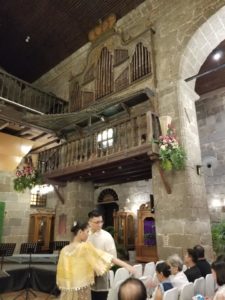
The 1824 Bamboo Pipe Organ, built by Father Diego Cera.
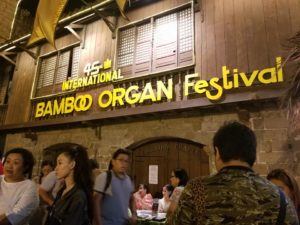
Updates to the Pipe Organ in China Project Website for January 2020
18 January 2020
Owing to the relocation of the Project’s office this month, the January updates are being posted early.
- The Errata list for Keys to the Kingdom has been updated. Please see What’s New and scroll down to the post for 23 June 2018 (when the list was first posted.)
- A lengthy blog post on Fr. Sigismondo Meinardi 1713-67, who built PEK1741, written by Prof. Urrows, was posted earlier this month.
- The Project was very happy to receive earlier this month copies of Fr. Theodor Josef Rühl’s 聖歌彙集風琴譜 (Beijing, Fu Jen University, 1939), as well as the 1935 hymnal, 聖歌彙集 (published in Yanzhou), which Rühl appears to have edited. The volume of accompaniments (see below) is most interesting, not least for the date appended to the last page: “Shanghai, August 21, 1939. Theo Rühl”. This means that Rühl was still in China at this date, after his sudden departure from Beijing June of that year (see Keys to the Kingdom, pp. 225-228, for the whole story, as far as anyone knows it.)
- A former student sent us a recent picture of the Concert Hall at the High School of the Central Conservatory of Music in Beijing, with PEK2004a in the background. It has been added to that page.
1-Year Page Views: 9,624
Hits since launch: 12, 564
We wish all our friends and visitors a Happy Year of the Rat! Gung Hei Faat Choi! 恭喜發財!
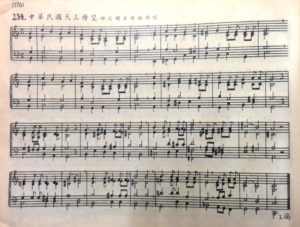
From Theodor Rühl’s 1939 volume of accompaniments for the 1935 SVD Chinese hymnal.
Further details on Fr. Sigismondo Meinardi da San Nicola (1713-67)
13 January 2020
Prof. Urrows writes:
As we noted in a What’s New post of 28 April 2019, the letters of Father Meinardi were (re-) published last year by the municipal government of his home town, Druento, in the northwest of Italy, and edited by Prof. Eugenio Menegon, of Boston University.
The letters reveal much more about Meinardi and his musical activities than I had access to when I received from a colleague in 2014 a paragraph, extracted from the 1964 Rome publication of the letters, about his mechanical box organ (listed in the POCP Census as PEK1741) built for the Qianlong emperor. I summarize here, after reading the three long scholarly articles, and all 75 letters in the book (all in Italian, a somewhat tiresome activity, I have to say), a few key findings that are relevant to The Project.
Father Sigismondo was born in Turin in 1713, and baptized as Paolo Antonio Meinardi. His father was a doctor, and the family soon moved to Druento, where he grew up. Having entered the priesthood, and the order of Discalced Augustinians, he was assigned to the China mission. His letter of recommendation stated among other things, that he “is an expert in making harpsichords.” He sailed from Lorient in Brittany to Macau in December 1736. Lorient was the main port for the French East India Company, which explains his departure on a ship from this place. The East India Company also persuaded the captain of his ship to give him special permission to take a harpsichord with him to China .
A year and half later, after arriving in Macau, and then going to Guangzhou, he received permission to travel to Beijing as an “organaro”. This generally means ‘organ builder’; but as in other eighteenth-century cases, it seems that most of the ‘organs’ which Meinardi built were barrel organs with automata and/or automatic playing mechanisms and, as he called then, bagatelle. It is a bit of a stretch to call him an organ builder in the real sense, and anyway he was in Beijing for much of the time that Florian Bahr (1706-71) was there, and no doubt he couldn’t compete with such a professional in the field.
Meinardi arrived in Beijing on 8 April 1738. He was quickly introduced to Qianlong and, after a few days, “I was called by order of the emperor to play on various harpsichords and organs which had come from Europe. When I finished, the emperor said that he wanted a harpsichord [small enough to be] hidden in a bag, for him to take to Tartary; five palms long, and able to play by itself.” The following year, he wrote that “the emperor has excused me from painting and clock-making, and I’m only to occupy myself with making organs.”
Meinardi enjoyed a friendship with Hong Zhou (1712-70), fifth son of the Yongzheng emperor, and a younger brother of Qianlong. In 1740, Hong asked him for and organ “three palms high, that plays Chinese tunes all by itself” This was probably a study for the larger automatic organ (PEK1741) built for Qianlong the following year. It is worth quoting the whole story, since only a part of it is included in Keys to the Kingdom and on the Website page for this organ:
“In this year [of 1741], to give you news of my bagatelle, I built a small organ, about three palms high and two palms wide, with bellows and a cylinder, all hidden inside the sound box made of rare brazil wood and boxwood, so that outside one could not see anything but the sound box and twenty pipes. Inside there were also small bells, which I also made; [the mainspring] automatically activated the bellows and made the cylinder rotate, playing three Chinese sonatas [suonate, possibly better translated as ‘melodies’ or ‘tunes’]. To crown it, with the clever help of Father [Giambattista] Serafino (1692-1742) I made a rooster as large as a duck, which, when each sonata [tune] ended, would stand up, raise his head, flap his wings, and sing cucùlucù. Father Serafino and I presented this to the Emperor on the 1st of August [1741], who enjoyed it a lot, and who gave each of us two pieces of silk, the same as he wears himself, as a gift.
“The fifth Lord, his younger brother [Hong Zhou], saw that he wanted to have one made [by me]. When finished, and because he had to order the court officials to give me the necessary materials, he only gave me three pieces of damask cloth, probably because I didn’t make [it with] the cucùlucù mechanism…”
At the end of 1741, Meinardi was one of the three priests summoned to the palace to teach music (along with Teodorico Pedrini (1671-1746), and Bahr) and the following year his name appears in the court records of musicians. Meinardi recorded the original instrumentation of the famous chamber ensemble of the 1740s quite accurately: six violins, one cello, eight recorders, four transverse flutes, one tromba marina, and two harpsichords. As late at 1747, he was still being called to the imperial palace to regulate ‘organs’, but this may very well mean mechanical instruments.
Pedrini died in 1746, and Meinardi seems to have been involved in rebuilding the 1723 Xitang – which Pedrini had both founded and built – and finished this work in 1753. This is the last interesting detail about his musical activity, although the organ does not figure in it. I let him tell the story for himself, of the schola cantorum which he founded there:
When the Xitang “was finished to the glory of God, I wanted to have Mass sung on the solemn feasts with Chinese music. In this, God aided me, because a Chinese prince of my acquaintance told me he wanted to help, and gave me some Chinese instruments. Then I went on with the most difficult part: I taught eight boys to sing the [Ordinary] of the Mass, and to Chinese music. The other Christians accompanied on the instruments, and already they have sung Mass on different occasions to a big crowd, more or less as I intended…”
Meinardi died in Beijing on the 29th of December 1767, at the age of 54. This publication of his letters and the scholarly articles (as Il mondo di Sigismondo), goes a long way to raising his status as an important missionario-musicista in China during the reign of the Qianlong emperor, one who was already active in trans-cultural musical exchange two-and-more centuries before it became ‘trendy.’
Updates to the Pipe Organ in China Project Website for December 2019
27 December 2019
“Cast thy bread upon the waters: for thou shalt find it after many days.” (Ecclesiastes 11:1)
- We thought about this Old Testament verse this month when we received an email from a visitor to the Website, informing us that one of the two ‘mystery’ organs in Beijing (see What’s New, April 2019) was in fact built by the Oberlinger firm. This is the organ at the Union (or, Yanjing) seminary at Qinghe, Haidan, on the far northwest side of the city.
This raises another question in connection with another mystery organ: PEK2004b, the Oberlinger organ reported to us as installed at the ‘Nestorian Church’ in Beijing. As the Census webpage states, we have long considered this (un-located) site as likely to be a spurious report of a non-existent organ in a fictitious church.
An appealing hypothesis now is that the word, union, and second syllable of Nest-orian would sound almost identical to a native Chinese speaker, especially one with a weak command of English. And so perhaps this is how the confusion arose: through a garbled transmission of the name of the location; the putative ‘Nestorian’ organ may turn out to be the one at the Union Seminary.
An inquiry was sent to the Oberlinger firm at the start of December, but at post time no reply had been received. Until this issue is resolved, we have not updated the page for PEK2004b.
March 2022 update: the mystery seems to have finally been solved, and the Census entry for PEK2004b has been updated to reflect the true location of the instrument. See the page for explanation.
- In another interesting development, Prof. Urrows received an email from a scholar in Germany in late September relating to Father Professor Theodor Josef Rühl SVD (1903-59).
In 2015 Prof. Urrows gave a paper at a conference in Hong Kong on Father Rühl, which however has not been published in full. Parts of it are, in a different form, in Keys to the Kingdom (see pp. 224-228). It occurs to us that visitors to this site might be able to help with gathering more information about this elusive figure. Fr. Rühl is perhaps best known for his discovery of the 12 Sonatas for violin and basso continuo of Fr. Teodorico Pedrini (1671-1746) in the Beitang Library in Beijing in 1935.
In particular we would like to track down copies of any of Rühl’s musical compositions. These include the Lieder Communion, Op. 24 (originally published by Schwann in Düsseldorf), which title suggests that there were at least 23 opuses preceding it. Another work that would be most interesting to see, is his book (in Chinese) on organ playing and accompaniment (see the illustration below), published in Beijing in 1939.
Please use the Contact Us page to send information, which is always gladly received and acknowledged.
3. There is a small update to an earlier post on Alois Strassl.

Total website visits: 12,076
One-year views: 9,995
A Merry Christmas and a Happy New Year
2020 to all our friends! 新年快乐!
Updates to the Pipe Organ in China Project Website for November 2019
3 December 2019
November was quiet month at The Project. There is one major news article to share:
This month marked the 30th Anniversary of the installation of HKG1989, the IV/93 Rieger organ in the Concert Hall of the Hong Kong Cultural Centre. An article/video appeared on the Hong Kong Government’s website to mark this:
https://www.news.gov.hk/eng/2019/11/20191101/20191101_162654_454.html
The Project notes that organists Simon Chan and Shirley Cheng, interviewed here, were both students of Prof. Urrows at HKBU.
Total one-year hits to date: 10,106
Total hits since launch: 11,744
Number of organs in the Census: 190
SHA1934a: A newly-noted account of its destruction in August 1966
9 November 2019
Prof. Urrows writes:
In Keys to the Kingdom, a variety of partial transcripts of interviews conducted by The Project over three decades appear. Sometimes these accounts are shorter than a full sentence, sometimes they amount to several paragraphs. One of the longer reports (see pp. 298-99) was the result of a 1998 interview with the former curator of SHA1934a, the 3-manual Austin organ installed at what was then the American Community Church in Shanghai. The informant detailed for me its destruction by Red Guards in mid-August 1966.
Recently I picked up a used copy of Colin Thubron’s travel narrative, Behind the Wall: A Journey Through China (1987). This was one of a number of such accounts published in the 1980s by famous travel writers who had the opportunity to visit China during what is called the ‘normalization period’ following the fall of the Gang of Four in 1976. Thubron was traveling in China in the autumn and early winter of 1985, mostly by rail. He interviewed staff at the Shanghai Conservatory, and then recounts that he visited (seemingly by accident) the nearby Community Church, by then known (as it is today) as the International Church.
While it is impossible to say to whom he spoke to in 1985, his account completely confirms that given to me 13 years later:
“Walking one day along a suburban street [Hengshan Lu], I glimpsed behind high walls the chancel of a church, and snooped into a close where a mullioned vicarage stood green with ivy. Even the flowers looked English. Down the nave the dark-wooded pews and the clouded glass spread a liturgical somberness, so that I did not notice the sacristan until he had flitted up behind me – a wraith of a man with delicately boned features…He waved his arm about the nave. ‘The harmonium is relayed by microphones, since our organ was smashed in the sixties.’
The Cultural Revolution: its rupture lay across every past. Even in the present people lived with its detritus – split families, brutalized psyches, a whole skein of invisible divides. The old man sat down in the pew beside me: his height seemed to remain the same. ‘The organ was a gift from America, but it was so old that they had no spare parts for it.’ He spoke of it with tenderness. ‘And do you know who broke it? Red Guard students from the Shanghai Music Conservatory. Can you understand that?’ He put on his glasses as if this might help. ‘I can’t. Nor how they could break our violin.’ He said ‘violin’ in English. The word’s poetry seemed suddenly tragic. ‘How could anyone break a violin?’
[…]
‘As for this place, it was used as a rehearsal studio for those Revolutionary operas.’ We sat in a momentary silence, facing the altar where the makeshift stage had once usurped the sacraments under the voiceless organ. ‘What I don’t understand,’ he said, ‘is that nothing inside those young people told them they were doing wrong…’”
(Colin Thubron. Behind the Wall: A Journey through China. London: William Heinemann Ltd., 1987/Penguin Books, 1988, pp. 148-49.)
The comment about ‘spare parts’ probably has to do with the effort in the early 1950s to acquire a new blower for the organ, which was prevented by a U.S. State Department decision that it would be “contrary to the national interest.” The harmonium mentioned may have been the large 1931 Watkins and Watson 2-manual and pedal harmonium I noted in the former Alumni Room in April 1990, less than five years after Thubron’s visit (see photos below.)
Although this is a sad story, it is important that it continued to be told. Thubron was able to record this account less than a decade after the end of the Cultural Revolution, and it is helpful confirmation of the general accuracy of the accounts which I obtained between 1989 and 2016.
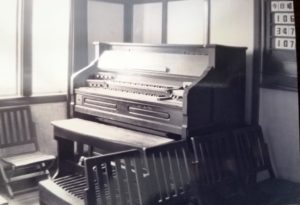
II/Ped harmonium, Watkins and Watson, London, ca. 1931.,in the former Alumni Room, International Church, Shanghai, April 1990.
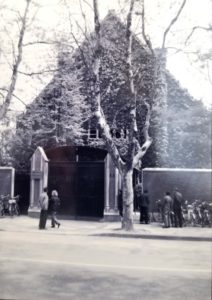
International Church, Hengshan Lu, Shanghai, April 1990 (note the bicycles.)
Updates for October 2019
31 October 2019
Updates to the Pipe Organ in China Project Website for October 2019:
Although there are no new installations to report this month, there are several updates.
- New photos have been added to PEK2004a and SHA1918 with additional comments on the respective pages.
- A forthcoming blog post from Prof. Urrows will deal with a previously unremarked published, corroborating source for the sorry story of SHA1934a and its destruction in 1966 during the Cultural Revolution.
- On a recent visit to Suzhou and Shanghai, Prof. Urrows met with Fr. Anthony Chen, Director of the Guangqi Research Center and Press (named for Paul Xu Guangqi (徐光啟, 1562-1633), friend of Matteo Ricci and an early Roman Catholic convert.) Zikawei Cathedral was visited, looking very nice after its recent renovation, and Prof. Urrows and Fr. Chen made a trip to the Minor Basilica of Shesan, outside of Shanghai. There is no organ there, but there is a loft clearly intended to house an instrument. Fr. Anthony was very interested to learn of the Project, and has invited Prof. Urrows to return to lecture next year.
However, nothing is known, according to Fr. Chen, about the organ reported earlier this spring as under design for Zikawei Cathedral. Information on this installation will be posted as it is received.
At the same time, it was depressing to learn that the construction work in the vicinity of Dongjiadu and St. Francis Xavier Church (site of SHA1857, the ‘Bamboo Organ of Tungkadoo’) has been so destabilizing, that in 2016 the church was closed for safety reasons. The local government has ‘promised’ to restore it when the wholesale domicide of the area is done and the new, luxury homes are completed.
One-year views: 10,010.
Pipe organs in the Census: 190
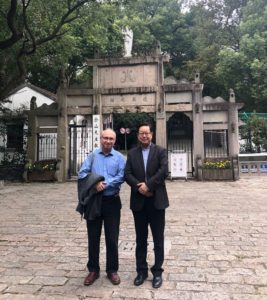
Prof. Urrows and Fr. Chen at the foot of Shesan Hill.
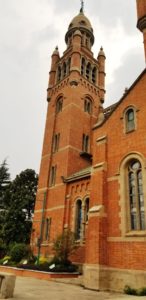
The Shesan Basilica, designed by Alphonse de Moerloose (1858-1932).
Updates to the Pipe Organ in China Project Website for September 2019
29 September 2019
- 30th anniversary of the POCP.
September 2019 marks the 30th Anniversary of what became The Pipe Organ in China Project. Prof. Urrows tells the story of how it all started in the Introduction to Keys to the Kingdom. It is perhaps is worth mentioning that the unnamed colleague, whose question about the ‘Bamboo Organ of Tungkadoo’ started the whole thing, is now also retired but very much alive and enjoying (we think with some surprise) the effect of his apparently simple question thirty years ago.
萬歲,萬歲,萬萬歲! man seúih, man seúih, man man seúih!
- Review of Keys to the Kingdom in the Galpin Society Journal.
The first published review of Keys to the Kingdom: A History of the Pipe Organ in China in a ‘scholarly’ publication has recently appeared in the Spring issue of the Galpin Society Journal (http://www.galpinsociety.org/journal.htm), LXXII (2019) pp. 241-242. Written by Prof. Stewart Carter of Wake Forest University, it is for the most part a positive review, and we appreciate Prof. Carter’s close reading of the text. Indeed, he has identified one important theme of the book when he writes that it is not only “an engaging, thorough study of the pipe organ in China…it is more than that. It is also a history of Christianity in China through the ‘lens’ of the organ.”
We would just like to clarify two points. The POCP was founded at Hong Kong Baptist University (or HKBU, as it is now known); it is a Hong Kong government-funded tertiary institution, and has never been known as the ‘Baptist University of Hong Kong’. And Prof. Urrows retired from the teaching staff in 2018, not in 2016, and continues to be affiliated as a University Associate.
- Beijing ‘Organ Festival’.
An “International Organ and Electronic Organ Festival” was held in Beijing between 4 and 8 September 2019. Part of the festival was held at the Central Conservatory of Music (CCOM), and at least one concert was played at the National Center for the Performing Arts (“The Egg”) on PEK2007a.
Just what this festival consisted of is not clear. There is nothing about it on the CCOM website (http://www.ccom.edu.cn/), although there were reportedly recitals on the Rodgers hybrid at CCOM, lectures, and master classes. The inclusion of ‘electronic organ’ and other substitutes for a pipe organ in the title is telling: Rodgers and Viscount were in fact major sponsors, see: https://www.viscountinstruments.com/news/beijing_international_organ/ and
http://www.rodgersinstruments.com/news/rodgers-china. Casavant also sent a representative, and L’ensemble InSpiration from Montréal performed as well.
That this kind of event can be held at all is a big and positive development for organ culture in Mainland China, and these kinds of educational opportunities are much needed. However, it does not seem to have been publicized internationally (even to Hong Kong or Macau), making the ‘international’ aspect dependent upon the presence of a couple of organ and electronic organ manufacturers (and the promotion of their instruments), and a handful of invited performers. We hope one day to see a proper festival (or even a POE, or organ academy) that will really promote the pipe organ, of which there are now plenty in Beijing alone for such an event to be successful. For the time being, however, events like these are probably doing good.
- Meeting with Robert Nield.
In Keys to the Kingdom, reference is made at various points (especially in Chapters 4 and 5) to Robert Nield’s The China Coast: Trade and the First Treaty Ports (2010). This small, but valuable book is largely free of the usual cant and onerous ‘official historical narrative’. It is a refreshing, objective look at a tumultuous and difficult period in East-West relations. Prof. Urrows reports that he had the pleasure of finally meeting Robert Nield himself at an art gallery opening in Hong Kong at the start of September. A cordial conversation followed. We recommend Mr. Nield’s books to anyone interested in this topic.
- Updates to Census pages:
HKG1933a: some updating based on information sent by a colleague in Hong Kong about this two-manual Blackett organ, and an additional report of a choir organ, also at Rosary Church.
YCF1937: there is a small update to this installation following a communication received from the Klais firm in Bonn.
- Census/Hits.
Organs in the POCP Census: 190
Hits as of 29/09/19: 9, 756
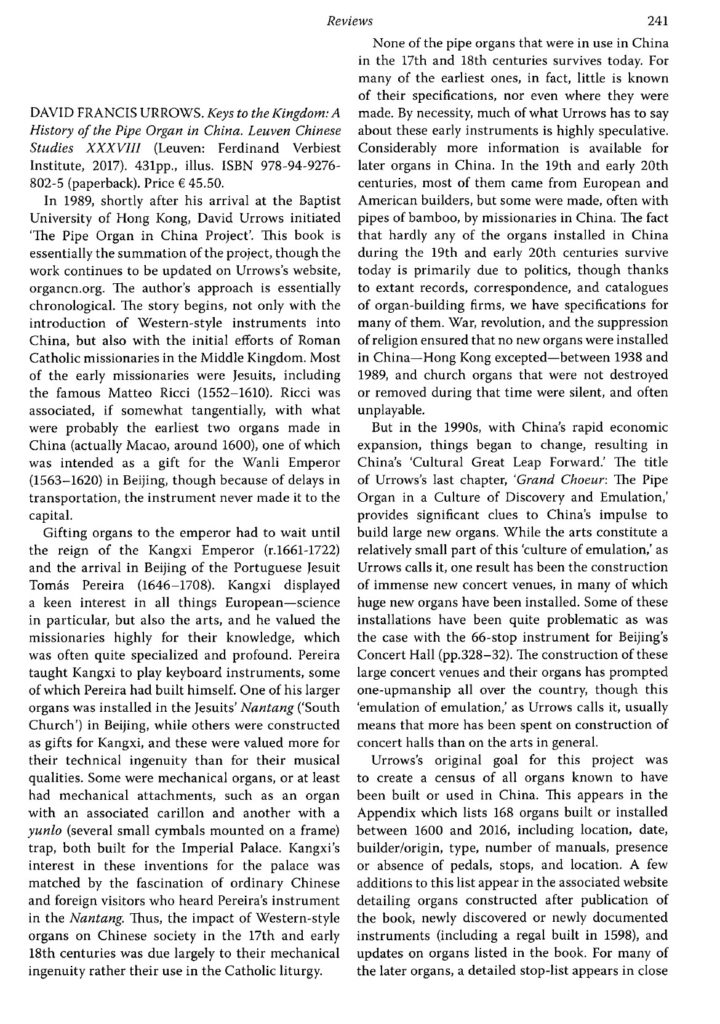
Updates to the POCP Website for August 2019
29 August 2019
- New pics have been uploaded for: PEK1902; and MAC2011, the III/37 Casavant organ at Church of São Lazaro, Macau (these photos were taken by Prof. Urrows at the time of the dedication of the organ.) Some formatting changes to the text on earlier (pre-1949) instruments in the Census have started, and there are further changes/clarifications to details on FCW1915.
- The HKAGO Summer Organ Academy (SOA): The Hong Kong Chapter of the American Guild of Organists held its second Summer Organ Academy, a camp-like, six-day event for young organists, between 11 and 16 August (https://agohk.org/2019/05/20/summer-organ-academy-2019/). The final concert was given on 18 August on the Rieger organ at the Hong Kong Academy for Performing Arts (HKG1986). A number of the functioning pipe organs in the territory were visited by the students and teachers as well, with opportunities to learn about the differences between them, and open console time. A couple of photos (from the HKAGO website) of the week follow at the bottom of this page. The Project is committed to supporting educational programs such as the SOA. If any visitors to the site have information about similar events in China, please contact us to let us know, and we may include the information in a future Update.
3. The Project is sad to note the passing on 1 August of Prof. R.G. (Gary) Tiedemann (1941-2019), of Shandong University (山东大学), Jinan, PRC, and formerly on staff at the School of Oriental and Asian Studies (SOAS) at the University of London.
Prof. Tiedemann was a giant in the world of China and Christianity studies, and an authority on the Boxer Uprising of 1900. He was a distinguished author, a great personal resource for countless China scholars, and was consulted on many occasions during the writing of Keys to the Kingdom. Without his vast knowledge of many obscure people, places, and events, and his willingness to share his expertise, the historical side of Chapter 4 would be much diminished. He will be greatly missed by everyone connected to The Project. An obituary posted to his website can be found here:
https://rgtiedemann.com/2019/08/05/professor-r-g-tiedemann-1941-2019/
4. New book about Fr. Sigismondo Meinardi: as mentioned in an earlier update, a new edition of the letters of Sigismondo Meinardi OAD has been published in Italy. Fr. Meinardi built an elaborate mechanical box organ during the reign of the Qianlong Emperor, listed in the Census as PEK1741.
The link for (free) download of the entire book is: https://www.comune.druento.to.it/it-it/vivere-il-comune/rubriche/il-mondo-di-sigismondo-1880-1-20bf3a4b322e734557081b008ab49bae
The book is described by the publishers as follows:
Assessorato alla Cultura del Comune di Druento, ed. Il mondo di Sigismondo. Un druentino nella Cina del XVIII secolo. Lettere dell’agostiniano scalzo Padre Sigismondo Meinardi da S. Nicola. Druento & Venaria Reale (Torino): Comune di Druento – Tipografia Commerciale, 2019, 248 pages, local publication, no ISBN.
This is a reset and slightly revised edition of 75 “Turinese letters” in Italian, first printed in a limited edition in 1964 (Sigismondo Meinardi da San Nicola OAD. Epistolario. Parte prima. Lettere originali inviate a Torino. Roma: Edizioni di «Vinculum» – Rivista interna dello Studentato Teologico di Gesù e Maria dei PP. Agostiniani Scalzi, 1964), with some additional essays. These letters were sent to his family and his superiors in Turin by Meinardi (1713-1767, Xi Chengyuan 席澄源), a missionary in Beijing and a clockmaker for the Qianlong emperor.
5. Website hits to date: 9,137.
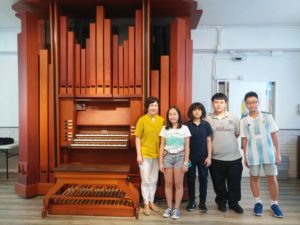
Chapter Dean Elizabeth Wong, and students at HKG2016.
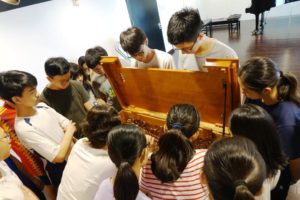
SOA students an up-close look at the inner workings of HKG2014.
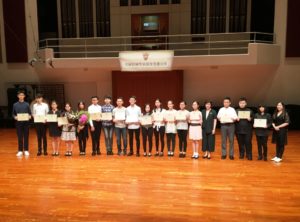
The participants in the final recital at the Academy for Performing Arts, on HKG1986.
Updates for July 2019
29 July 2019
Updates to the POCP Website for July 2019:
- New photos have been added to:
2. Project Founder Prof. David Francis Urrows visited Macau in July, and found that the planned IV/54 Casavant, Op. 3925, for the Cathedral is now apparently ‘on hold.’ No work (at least visible work) has been done in the Cathedral, in particular on the organ loft which should probably hold the antiphonal division. We will update when further information about this major installation, originally planned for 2018, become available.
- Fr. P. Antonio Riganti PIME (1893-1965)
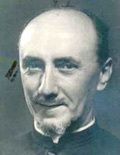
While in Hong Kong earlier this month, Prof. Urrows acquired two volumes of music by Fr. Antonio Riganti, a PIME[1] missionary who through his ministry had a major impact on music in the Roman Catholic churches of Hong Kong between 1919 and 1965. These compositions are contained in two rather misnamed folios, A Collection of Liturgical Organ Pieces, Vols. 2 and 3. These were edited by the Hong Kong Diocesan Sacred Music Commission and published in 1995 and 1996, respectively.
Most of the works in the two collections date from the mid-1930s, when Fr. Riganti was serving at St. Joseph’s Church, Central (he was Rector of St. Joseph’s between 1927 and 1948.) This church, torn down in 1966-67, was the site of HKG1919. It is possible, therefore, that at least some of Fr. Riganti’s organ compositions were written for, or even played on, this Blackett and Howden organ. The music itself was edited (rather amateurishly) from manuscripts obtained from the PIME archives, as Hong Kong itself does not appear to have any surviving collection of Fr. Riganti’s works. Riganti also composed choral pieces, masses, piano compositions, and chamber music.
The Project is, in general, not much concerned with organ repertoire; but it is certainly interesting to see what was passing for liturgical music at this time. Most of it is a kind of ‘liturgical salon music’; the works have charm, but are highly and in some ways excessively chromatic, many pieces seem more suited for the harmonium, or even the piano, than the pipe organ, and with rather sparing use of the pedal division they lack a certain impact (HKG1919 probably only had a 16ʹ Bourdon in the pedal division, and is known to have had no reed stops.) Most have, however, dates and places of composition, usually St. Joseph’s (see illustration).
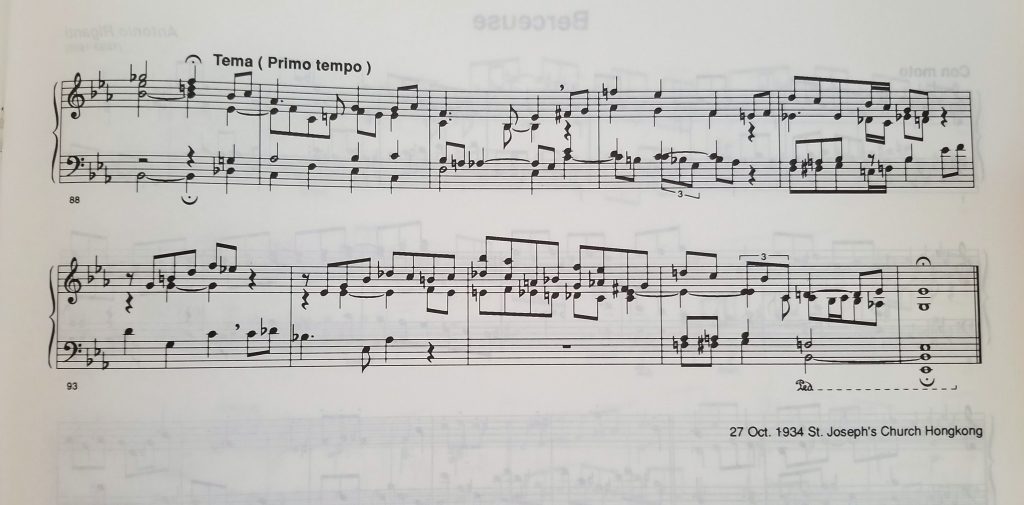
Further information about Fr. Riganti and his music is available at the following webpages:
https://archives.catholic.org.hk/In%20Memoriam/Clergy-Brother/A-Riganti.htm
https://musicasacra.org.hk/publish/riganti_en.html
https://musicasacra.org.hk/publish/organpiece_tw.html#05
[1] Pontifico Istituto Missioni Estero (Pontifical Institute for Foreign Missions), now based in Rome, but founded in 1850 in Milan and still sometimes known as the ‘Milan Missionaries’.
Organ Music in 17th C. China, de Arauxo, and the Facultad Organica
10 July 2019
Prof. Urrows writes:
At the end of Chapter 1 of Keys to the Kingdom (pp. 50-54), I wrote a few cautious paragraphs about what music might actually have been played by Jesuits (and others) on the organs of seventeenth-century China. There has been, over the past 25 years, a lot of speculation about this topic, and the question of how the office was sung, to what music, etc. Some of it remains in the realm of possibilities; a lot more of it is sheer fantasy by pseudo-scholar performers. As I wrote, “we enter into a completely speculative world of shadows and hypotheses when we try to find a prudent answer to the question of what music would have been performed on the four or five early pipe organs of China.”
Nonetheless, hypotheses have to be made in order for knowledge to advance. In remarking on the Portuguese political and cultural dominance of the China mission at this time, I mentioned a group of popular Iberian composers of the day, including the Spaniard, Francisco Correa de Arauxo (ca. 1576-1654). I also commented that “it is frustrating not to be able to say that one member of the second or third generation of China missionaries might have had a copy of de Arauxo’s influential 1626 Facultad Organica.”
This week, the Lubranos, well-known antiquarian dealers in rare music editions and manuscripts in New York, advertised for sale an original copy of de Arauxo’s Facultad. Describing it as “a rare and important early source relating to the organ, organ playing, and organ music in tablature notation”, the catalog price is a whopping 14, 500 USD. But what struck me most was the handwritten inscription of the original owner on the title page (below): “Collegii Parisiensis Societat. Jesu.”, that is, the Paris College of the Jesuit Order.
This does not offer prima facie (or really, any) evidence that a copy of this work did eventually get to China. But it is intriguing that one of the few surviving copies (only about 12 are known) was owned by a Jesuit College. This certainly is highly suggestive, and it offers a bit of support for the hypothesis that music of this kind — tientos and versos in the Iberian style — would have been just what organists such as Diego de Pantoja, Manuel Rodriguez, and Tomás Pereira would have played in China. For those interested, there is modern edition, edited (poorly) by Macario Santiago Kastner (Union Musical Española, 1948/52; reprinted 1974), and which costs a lot less than the Lubranos’ copy (see “New Acquisitions July 2019” at https://www.lubranomusic.com/catalogues.php).
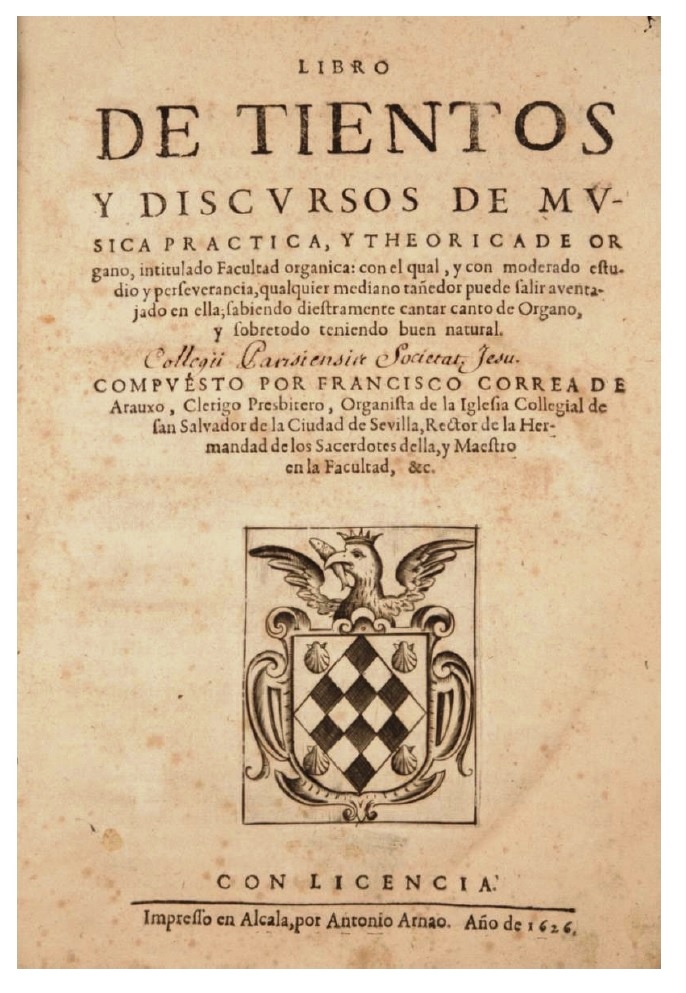
Updates to the POCP Website for June 2019
30 June 2019
Update for June 2019, our first year anniversary:
A new four-manual Klais organ has been installed in the Urban Concert Hall of the Sichuan Conservatory, in Chengdu, Sichuan Province. CHD2019 is a IV/68 mechanical/electric instrument, with a very large number of super- and sub-octave couplers. The specs can accessed here: https://www.klais.de/m.php?tx=243
Information about the new hall (another futuristic, ‘xenophiliac’ building) can be found here: https://archello.com/project/urban-concert-hall-in-chengdu
Site hits to date (slightly over one year since launching the site): a very lucky 8,001!
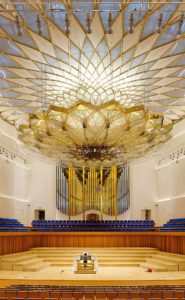
CHD2019 (from builder’s website)
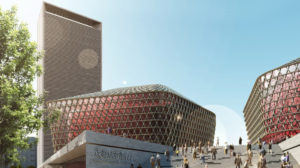
Concert Hall, Sichuan Conservatory (from architect’s website).
Happy 1st Anniversary POCP Website
20 June 2019
Today is the first anniversary of the opening of The Pipe Organ in China Project Website, on 20 June 2018.
When we started, we had only the pre-1949 organ installations up on the site, and during the Summer of 2018 the post-1949 instruments were added. New installations have also gone into the Census, various gremlins in the Census have been sorted out, and many new illustrations have been found and uploaded.
To date, we have had 7,827 visitors to the site, that is over 20 per day, on average.
A big Thank You to all our visitors and friends!

Alois Strassl (1903-76), an Austrian Organist in Guomindang China.
14 June 2019
The great music encylopedist and conductor Nicholas Slonimsky (1894-1995) once said that “it is the goal of every musicologist to become a footnote.” On page 340 of Keys to the Kingdom just such a footnote appears, and is dedicated to mentioning Alois Strassl, an Austrian organist, conductor, and editor, who worked in Nanjing between 1932 and 1938. No comments or records relating to Strassl as an organist during his China years have yet been found. This is why he is not mentioned in the main text (and there is no entry for him in the Index – one of the Project’s ‘rainy day’ desiderata is the creation of an improved Index for the book.)
In May, Project Founder Prof. David Francis Urrows travelled to Austria, where he met with his colleague and friend, Prof. Gerold Gruber of the University of Music and Performing Arts, Vienna. Prof. Gruber is the director of Exil-Arte: The Center for Banned Music, a scholarly organization founded in 2016 (www.exilarte.at) In the course of discussion, Strassl’s name came up, and while he was not exactly an exiled composer (he returned to Austria from China about 1938), his presence in China in the lead-up to both the Sino-Japanese War and the Second World War makes him a person of potentially considerable interest.
Strassl was born in Linz (Ried) on 21 June 1903. After graduating from local schools, he studied Musicology and Art History at the University of Vienna (1923-30), where he teachers included Robert Lach, Rudolph von Ficker, Wilhelm Fischer, Robert Haas, Hans Gál (also a teacher of Prof. Urrows, at the University of Edinburgh), Ferdinand Habel, Egon Wellesz, Carl Fürich, Walter Tschoepe, C. Girisch, and Hermann Graedner. He completed his PhD in 1930, with a dissertation on the subject “Das Inhaltsproblem in der Meßkomposition der Wiener Klassik” (The Problem of Content in the Masses of the Viennese Classical Era.) From 1923 to 1926, he was Titular Organist of the Basilica Maria Treu, and Choirmaster there until 1930. Between 1928 and 1931, he was a presenter on Radio Vienna.[1]
According to an obituary published in 1976, after graduating from the University of Vienna, Strassl, “owing to his musical talents and abilities…was chosen from more than 30 other European candidates in 1932 to serve as Professor and Conductor at the Central University in Nanjing, China.”[2] He was subsequently Principal Conductor of the Nanjing Musical Association, and also conducted the Shanghai Symphony Orchestra, as well as acting as Director for Western music programming for Nanjing National Radio[3], where he gave numerous broadcasts on Western music, and introductions to concerts of Western music works and exhibitions of Western art. In 1935 he received the Austrian Service Cross (Verdiesntkreuz) for Art and Science, and in 1936 became an Honorary Fellow (Eherenring) of the National Central University of Nanjing. Among the most important of his activities as an ‘influencer’ in China, is that he was the teacher of Ma Geshun (马革顺, 1914-2015), China’s most prominent choral conductor of the 20 Century, who studied with him at the Central University between 1933 and 1937.
“After he returned [to Austria] in 1937 [sic.] he took up and important post at the RAVAG (now the Austrian Radio) developing musical programming. After serving in the army in World War Two, he was appointed Professor at the Musikhochschule in Vienna and was later appointed Director of the [Austrian] State Library. In addition to his professional duties, he taught at the Vienna Conservatory, was organist of the Piaristenkirche, and directed various choirs.”[4] Among these appointments were the directorship of the Vienna Oratorio Choir (1949-56), the Haydn Orchestral Society (1958-1962), Choir Director at St. Erhard’s, Vienna (1951-1967), and other academic posts and honors. As Oberstaatsbibliothekar from 1956 to his death in Vienna in 1976 (“after a long illness”), he was honored in 1968 with the title, Hofrat (State Councilor).[5]
Strassl also published editions of music of both F.J. and Michael Haydn, and W.A. Mozart. For the POCP, his most interesting publications are the ones that deal with China. These include the following:
*“Nanking” in: Kulturgeschichte Nankings. Edited by Prof. Dr. Chu Sieh [Chu Xie?] (Shanghai: The Commercial Press, 1936). (As this was a Chinese-English text, the original English title was probably something like ‘A Cultural History of Nanking’.) December 2019 update: A copy of the Chinese version is at the Main Library at Hong Kong Baptist University. It does not contain any writing by Strassl, but Strassl contributed 56 photographs to this volume. We are still looking for the English version.
“Einführung in the chinesische Musik” (Introductory Essay), in: Fritz Kornfeld. Die tonale Struktur chinesische Musik (Mödling bei Wien: St. Gabriel-Verlag, 1955).
Journalistic writings and lectures, published at various times and in various venues:
*“Religiöse Verhältnisse in Nanking” (1937/38); *“Katholische Kulturarbeit in China” (1946); “Kulturgeschichte Chinas” (1946); *“Kung-dse [= Confucius] und der Musik” (1946); “Kult- und Profanbauten” (1946); *“Nanking” (1946); “Das Yang-tse” (1946); *“Chinesische Philosophie und Musik” (1948, guest lecture given at the University of Graz); “Die Geschichte der chinesische Musik” (1950); “Die dumpfe Trommel, der berauschende Gong” (1952); “Die chinesische Opernfarbtonfilm: Liang Shan-po” (1954); “Chinesische Musik” (1954).
Strassl also left an unpublished book manuscript: Musikgeschichte Chinas, Ursprung und Entwicklung (‘A History of Music in China: Origin and Development’), as well as a number of derived essays and lectures, on topics including ‘Confucius’, ‘Landscape and Music’, ‘The History of Chinese Theater’, ‘Chinese Grave Cults’, ‘Shandong and the sacred Taishan Mountain’, ‘Jiangxi and Jiangsu, the Provinces of Central China’, and ‘The Popular Theater in China: The ‘Flower Garden’’. He also lectured on Chinese music topics at the Vienna Volkshochschule, and for the Austrian UNESCO commission.
NONE of Strassl’s publications listed above have been located by the Project. We would be very grateful for any visitors who may be able to send us information, or even copies of any of these items, especially those marked with a (*).
[1] Biographisches Lexikon von Oberoesterreich, Vol. 8 (1963), “Strassl, Alois”.
[2] Rieder Volkszeitung, No. 34, 19 August 1976.
[3] Biographisches Lexikon von Oberoesterreich, Vol. 8,
[4] Rieder Volkszeitung, No. 34, 19 August 1976.
[5] Biographisches Lexikon von Oberoesterreich, Vol. 8
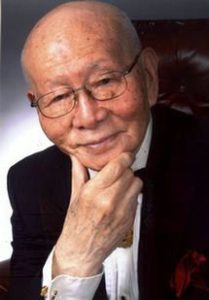
MA Geshun (‘Gershwin Ma’, 马革顺, 1914-2015), Strassl’s most important student in China.
Updates for May 2019
8 June 2019
The Project has no updates to the Census for the month of May 2019.
However, an interview with Project founder, Prof. David Francis Urrows, has just been published in the newsletter (Peninsula Pipings) of the Palo Alto/Peninsula Chapter of the American Guild of Organists. Prof. Urrows was Chapter Dean in 1996/97, and had other positions of responsibility with the Chapter prior to that.
Editor Katherine Ou discussed the Project and the website with Prof. Urrows, and the extract from the newsletter can be accessed through the pdf file below.
As of today, the website has had 7, 615 hits. 20 June will be the one-year anniversary of the launch of the site!
Happy Dragon Boat Festival to all our visitors!
Updates for April 2019: Another Casavant in Beijing, W.C. Blackett, and Fr. Meinardi
28 April 2019
- A major contract has been let for the new China Philharmonic Hall in Beijing, with the winning bid made by Casavant Frères. The new hall, which will house the China Philharmonic Orchestra, will be built next to the east gate of the Worker’s Stadium (properly, the Beijing Worker’s Sports Complex, known locally as gongti.) In between the Second and Third Ring Roads, and not immediately in the city center, the area is served by several subway lines, though none are actually at the stadium itself. It is south of the popular Sanlitun nightlife area.
In China, ‘leisure’ (康樂, =sports) and ‘culture’ (文化, =art) tend to be linked together at government levels under the same administrative department. Placing a concert hall next to a sixty-year old, 66,000-seat football stadium does not appear incongruous there. The new building will be yet another futuristic (‘xenophilic’) piece of architecture having nothing to do with its surroundings, especially the Soviet-style stadium next door. Details about the design can be found here:
Casavant has not yet released further details, including specs and CAD images. The Project will update on this as information comes in.
- Following a meeting with members of the local AGO chapter in Hong Kong in April 2019, some new information on William Charlton Blackett’s organs has been added to the following instruments:
- We have also learned that a new edition of the letters of Fr. Sigismondo Meinardi (1713-67) edited by Prof. Eugenio Menegon of Boston University, has just been published. This updates the 1964 ‘edition’ of most of these letters (really just a mimeographed, stapled gathering) published over half a century ago in Rome. The new book, Il mondo di Sigismondo, is however a local publication by the authorizes in Druento, without an ISBN number. We understand that a free online version of the book will be available later.
Fr. Meinardi appears on p. 123 of Keys to the Kingdom in connection with an automatic box organ he built along with Fr. Giambattista Serafino (1692-1742) in 1741 for the Qianlong emperor. Meinardi reported that the organ’s barrels played “three Chinese sonatas”, but just what these pieces of music were is unknown today. Further information about the new book is available here (in Italian): https://www.comune.druento.to.it/it-it/appuntamenti/il-mondo-di-sigismondo-67934-1-60e934853c612b0ec865731f1eb080fe
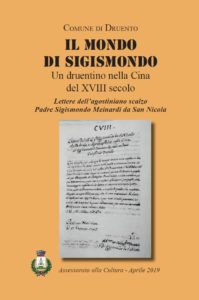
More on the ‘Bamboo Organ of Tungkadoo’ (SHA1857/1881.)
21 April 2019
In the course of looking for material on another topic, Project founder Prof. Urrows came across a hitherto undocumented article in The North-China Herald for 9 May 1925, “The Old Tungkadoo [Dongjiadu] Cathedral”. This article provides some addition information about SHA1881 (the final incarnation of the ‘Bamboo Organ of Tungkadoo’, originally SHA1857). According to the anonymous reporter:
“The Cathedral is also remarkable for having what is probably the only bamboo organ in the world. This is an organ of bamboo pipes all of local workmanship and it was used until recently and had a very sweet tone. Unfortunately owing to some trouble with the blowing apparatus the organ has fallen into disrepair and in consequence is not used now.”
This may mean that the 1918 renovations undertaken by Monsignor Lécroart not only included replacing some of the pipes, but may also have seen an electric blower added, although this is not clear from way in which the article is phrased. By 1932, Fr. Roger Doherty SSC heard the organ play at Christmas Midnight Mass, so there were some (until now) undocumented repairs by unknown persons in the intervening seven years. It is possible some work was done in 1925 by the Jones brothers who, at precisely the same time as this article appeared, were busy at Holy Trinity Cathedral beginning the installation of the great Harrison & Harrison organ, SHA1925. Since they overhauled the earlier Walker organ (SHA1883a) in Holy Trinity at this time and reinstalled it at Zikawei, it is plausible that they might have also have been asked to make some repairs to SHA1881, but this is only a hypothesis.
The NCH article was accompanied by a handsome picture of the nave and high altar (below), taken from the organ gallery by doctor, photographer, and amateur organist R[obert] V[yvyan] Dent (1893-1963), who must surely have played the instrument that was sitting right behind him! It is a source of endless frustration that no photograph of the bamboo organ has yet come to light, not even one by Dent who would have had every reason and opportunity to take one.

Two Mystery Organs in Beijing
4 April 2019
During the almost-30 years of The Pipe Organ in China Project’s existence, from time to time we have received reports about pipe organs which turn out either to be false, untraceable, or just too tenuous to follow up or include in the Census.
We have two photographs of organs said to be in Beijing, about which no other information has ever come to us, other than the image. If any of our visitors has any information about these instruments, please use the Contact Us page to send your report. We will gladly acknowledge all verifiable information we receive.
Mystery Organ 1:
This photograph was sent to the Project in 2010. It is described simply as “a German organ in Beijing”, and the implication at the time was that it is a privately-owned positive organ. Although it looks ‘old’, we believe it is a modern replica of an 18th C. design or inspiration.
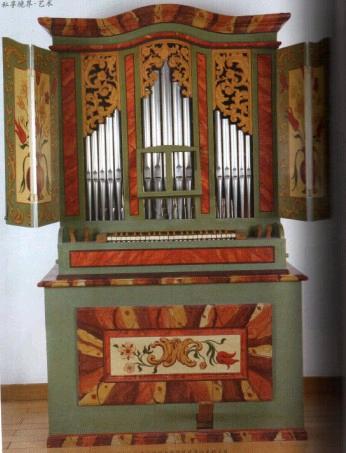
Mystery organ 1: positive (German?) in Beijing.
Mystery organ 2:
This instrument is somewhat less mysterious. The photograph was sent to us in 2009, and is apparently a small pipe organ in the loft of the church at the Union (Yanjing) Seminary at Haidan in Beijing, established in 1986. We have never succeeded in getting in to the Seminary, and no other information appears to be available (no online source can be found naming a builder.) We surmise that it was built around 2005-09, possibly by a German organ builder.

Mystery organ 2: small church organ at the Union Seminary, Haidan, Beijing.
We would appreciate any information our visitors have to share. (The Chinese-language captions on the photos do not help with this, and only identify Beijing as the location.) Thank you! 谢谢!
Updates for March 2019
30 March 2019
This has been a quiet month at The Pipe Organ in China Project, except that page views up to today have reached 5, 462!
A new three-manual and pedal Rieger organ, FCW2018b, was dedicated in November in Fuzhou. This is located in the new, large Flower Lane (Hua xiang) Church, a ‘megachurch’ with over 20,000 members.
New photos have been added to the pages for HKG1887 and HKG1930.
Further data on a photo (from 1916) has been added to FCW1915, and some old confusion over the identification of two different churches in Fuzhou has now been cleared up (including the original ‘Flower Lane Church’.)
While not in China, the Project’s founder had the opportunity to visit Singapore in March, and play on the newly-restored and enlarged 1912 Bevington two-manual organ at the Roman Catholic Cathedral. The work was carried out by Diego Cera Organ Builders, and is a model of what should urgently happen to the similarly derelict, or near-derelict organs in Hong Kong built for Roman Catholic parishes in the 1920s and 30s by William Charlton Blackett.
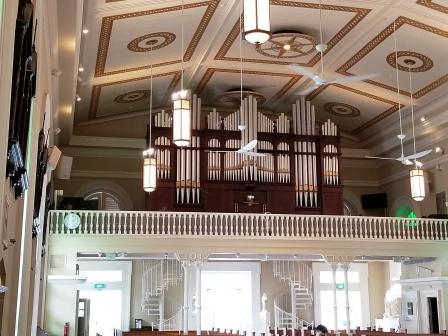
1912 Bevington, RC Cathedral, Singapore.
The Humorous Harmonium, con’t.
23 March 2019
Another amusing anecdote about the reed organ has come to the Project’s attention this past month, while we were (as usual) looking for something else. This is a letter to the editor, published in the venerable missionary journal, The Chinese Recorder, in the issue for September 1916 (p. 647). Written from Yungchow (Yongzhou) in southern Hunan province, it is yet another example of how the reed organ/harmonium played such large role in missionary life – especially in the introduction of Western music to Asia – and of the global reach of the growing U.S. music industry after the American Civil War.
The Project has not (yet) been able to identify the irritated Mr. Alfred W. Hill, but he does not seem to have been a missionary and was probably a businessman or other professional.
Estey reed organs were very popular, both in China and in ASPAC generally, at this date. From the 1880s Estey had even marketed a special ‘Acclimatized Organ’, which was supposed to stand up better to the local, humid climates.
To the Editor of “The Chinese Recorder.
Dear Sir: I wish to find a purchaser for an Estey Organ which has through an error come to be on my hands. The history of the error is this. Writing to a friend in Ireland for a friend in China for information re prices of organs, I was either so ambiguous or my friend in Ireland so stupid that he read my letter as a request to send out an organ. Almost the first thing I again heard about it was the organ’s arrival in China. An organ is about the one thing I don’t want, and I think if you publish this note in your correspondence columns, someone who may want an organ may be led to take the thing off my hands.
The organ in an Estey, Model BH, walnut, listed in England [at] £58. I am advised by my Irish friend, who made the mistake, to offer @ £30 price down.
With many thanks for space in your paper for my note.
Yours Sincerely,
Alfred W. Hill
Yungchow, Hunan
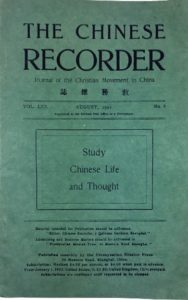
Update for February 2019, and More Details on Fr. Torre da Omegna OFM (1808-48)
25 February 2019
This month there are no updates to the Census of new instruments; but the Project has been excited to learn that a contract has been let for a three-manual and pedal, 32-stop, electric action pipe organ for the Cathedral of St. Ignatius at Zikawei (Xujiahui) in Shanghai. Further details will be forthcoming later in the year about this successor to SHA1883a.
New photos have been added for HKG1927b (taken in 2013, before the repainting of the church’s interior.)
The major activity this month has surrounded WHN1846, and the discovery (noted in the previous What’s New post) that this locally-built organ in a remote location had pipes made of bamboo. As reported, this increases the number of builders/locations of bamboo organs in China to at least 2, and pushes back the starting date of this type of organ by a decade. Through the thoughtfulness of our colleague, Prof. Francesco Maglioccola, it is possible to share some more biographical details about the builder of this instrument, culled from recondite material which Prof. Maglioccola has located in archives and libraries in China and Italy, and which he has kindly shared with the Project.
Father Giovanni Battista Torre da Omegna (嚴懷義)was born in 1808 at Cusio in the province of Novara, in the Piedmont region (some sources call this part of Liguria.) The House of Torre was an old noble family, and Giovanni showed an interest in the religious life as a boy. He was ordained a priest in 1831, and his first overseas posting was to Palestine. He spent time as priest and administrator in Bethlehem, Beirut, Tripoli, and Cyprus. He returned to Italy briefly in 1842, and then left for China, his “second homeland.”
Conditions in the vicariate of Huguang (today’s Hubei and Hunan provinces) in 1843, where he was sent shortly after the conclusion of the First Opium War, were not good for missionaries. Nonetheless, it was during his brief five years of service there that he built the bamboo pipe organ for the little church at Tianmen, near Hankow (Hankou; today, part of the megacity of Wuhan).
In 1848, the bishop, Giuseppe Novella da Carpasio (1805-72, whose letters are the source of information about the organ), and a Spanish friar, Fr. Miguel Navarro (1809-77), were expelled from Huguang and exiled to Canton (Guangzhou). Fr. Torre da Omegna was named Vicar general of Wuchang in their places. But after only a few weeks in this role, while bringing the sacraments to a sick parishioner in Wuchang, he was arrested on 30 January 1848, on the orders of the local ‘governor’, ‘Kiam-hia-hiem’[1]. Fr. Torre was maltreated, and starved in prison for three weeks, apparently not so as to kill him but to ‘persuade’ him to leave the area.
Eventually, due to his deteriorating condition, he was sent under the guard of a minor mandarin to Canton. Here, after long negotiation, he was released into the custody of Dr. Peter Parker (1804-88), a renowned physician, Protestant missionary, and eventual diplomat. But he was past the medical help of the time, and there was nothing to be done. He died on 15 April of his injuries. Some sources say he died in Hong Kong, but the eyewitness account by Monsignor Novella says he died in Parker’s house in Hog Lane, Shamian, Canton, which doubled as his hospital. Parker arranged for a steam launch to take his body to Hong Kong, where, to the dismay of his Roman Catholic confrères, an autopsy was performed. The conclusion was that he had died of an inflammation of the brain. The Franciscans now consider him a martyr.
Father Torre da Omegna was buried in a small Catholic cemetery, “eastwards of Cantonment Hill” (today’s Hong Kong Park) and outside the British residential settlement (British Hong Kong was only founded in 1841-42, and was still quite small at this date.) The location of his original grave is lost; but it was somewhere south of Queen’s Road East in present day Wanchai, on the hill that is now is crossed by Sun, Moon, and Star Streets, appropriate enough for a Franciscan!
A 1926 publication (in Latin) by Fr. Cosma Sartori, printed at Hankow[2], mentions that “This Father Torre was famous in scientific and mechanical arts”, but adds nothing further about the pipe organ.
Website Hits to date: 4,143!
[1] As given by Msgr. Novella in his letter. Perhaps this ‘Kiam’ was actually the local daotai, as the Governor-General (or Viceroy) of Huguang at this date was one Yu Tai 裕泰 (in office 1839-51).
[2] Cosma Sartori OFM. Elenchus biographicis ac chronologicis notis ornatus complectens missionarios externos ac indigenas qui sacrum obierunt ministerium in vicarialibus apostolicis de Hu-Kwang, de Hu-Peh, de Hu-Peh Orientali, de Han-Kow. (Hankow: Missio Catholica, 1926), p. 54.
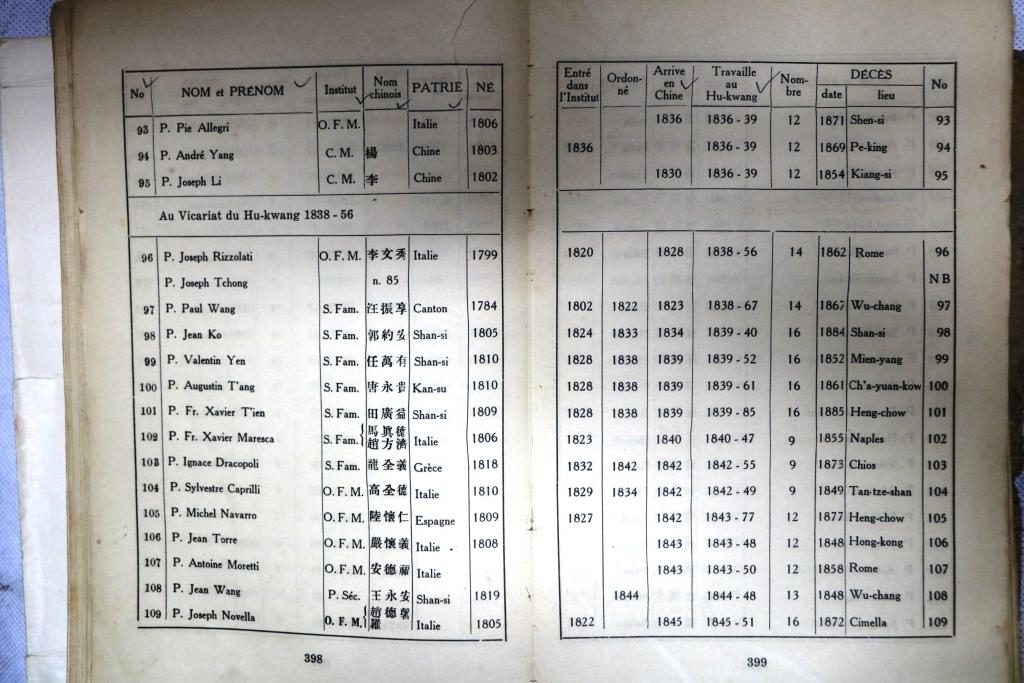
From a Franciscan necrology, Fr. Torre listed as No. 106 (“Jean Torre”) with incorrect place of death (“Hongkong” instead of Canton.) Fr. Navarro is No. 105, and Msgr Novella is No. 109.
Another Bamboo Organ in China: WHN1846
8 February 2019
In an exciting new discovery, we have received word from our colleague, Prof. Francesco Maglioccola in Wuhan, that a letter written in 1845 (and published in 1848) has been found relating to Fr. Giovanni Battista Torre da Omegna, and concerns the organ Fr. da Omegna built for the little church at Tianmen, WHN1846.
The letter, written by Fr. Giuseppe Novella da Carpasio, mentions that the pipes of WHN1846 were made of canne cinesi — bamboo!
This pushes back the frontier of organs with bamboo pipes in China by more than a decade before the great ‘Bamboo Organ of Tungkadoo’ in Shanghai (SHA1857). Did the Shanghai builders (Jesuits) know of Fr. da Omegna’s organ? Did Fr. da Omegna (a Franciscan) know of the organs of Fr. Diego Cera (an Augustinian Recollect), built with bamboo pipes in the Philippines in the first quarter of the 19th C.? Fr. Cera died in 1834, so it is unlikely that any of them ever met (besides belonging to different orders, and living in different administrative areas.) We will probably never know for certain, but this is a major find in history of adapting bamboo to pipe organs in Asia.
We are also grateful to our graduate student, Francesco Teopini, for helping with the translation of Fr. da Omegna’s letter:
“This church [at Tianmen], which anywhere in Italy would move [one] to compassion, is nonetheless the biggest and most beautiful, or at least the least miserable and the least dirty of the whole Vicariate; and from this, you can get an idea of all the other inconveniences. It is enough to tell you that it has no windows, and that it would not receive any light, were it not for a big hole in the middle of the roof, from where, when it rains, water pours down as in the streets. One of our priests, Father Giovanni Battista Torre da Omegna, has made a beautiful organ, taken here for a miracle of European intelligence, with [pipes of] bamboo [canne cinesi], which are not unlike the ones in India. As a matter of fact, it is so sweet and so harmonious, and it was built with such mastery, that not even an Italian church would dislike it. People came from different places to see it…”
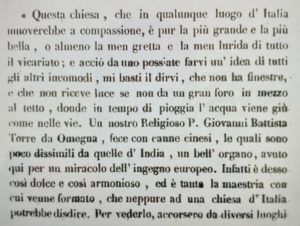
Albert Louis Faurot (1914-90) and the Humorous Harmonium
6 February 2019
By Project Founder, Prof. David Francis Urrows.
Albert Faurot was an American missionary-musician, pianist, conductor, opera producer, and (in a small way) philanthropist. A graduate of Park College and the Oberlin Graduate School of Theology, he came to China in 1936 to teach music at Foochow College for the United Board for Christian Higher Education in China. He later taught at Hwa Nan College, Foochow Christian University, and the National Fujian Academy of Music. In October 1950, he was ejected from China along with all other foreign missionaries, and taught for one year at Kobe College in Japan. In 1952 he moved to the Philippines. As a choral conductor, arranger, and concert pianist, he gave what were probably the Chinese premieres of many important 20th C. works, from Randall Thompson’s Alleluia in Fuzhou in 1950, to George Crumb’s Makrokosmos in Beijing in 1981.
In one of his earliest published writings, he tells an amusing story which nonetheless points to the large role played by the reed organ/harmonium in missionary life in China in the second half of the 19th, and first half of the 20th centuries. He doesn’t give any source for this, but it is worth reprinting here anyway:
A missionary who arrived at the turn of the [20th] century tells of waking the first morning to hear in the girls’ dormitory the sound of a dozen little [reed] organs being played. For several mornings this continued, the scales and arpeggios and little pieces starting promptly at six. On inquiring of the Chinese Dean the reason for this, the missionary was told that it was the “six o’clock rule.” The missionary protested that it seems rather heartless to require the girls to practice at six on winter mornings, in the dark, unheated rooms. “Oh,” explained the Dean, “the rule is not that they must practice at six, but that they cannot practice before six. Otherwise they would begin in the middle of the night! But nothing,” the Dean continued, “could prevent them from practicing silently on the organ key-boards, until the clock struck six, when their little bound feet began pumping the bellows.”[1]
In Faurot’s youth (he grew up in the American Midwest) the term, organ, usually meant reed organ/harmonium, especially in mission contexts. If this story is true, then these were probably ‘baby organs’ of the melodeon type. Such instruments were not only imported, but were already being manufactured in China at this time by both missions as well as by commercial firms, such as Moutrie in Shanghai. They were small, often built to fold up into a box, and relatively inexpensive (see 1933 advertisement from the Lazarist establishment in Beijing.) While the Project does not survey reed organs, these kinds of stories (funny or not) add to a body of literature showing how the organ and organ literature were dispersed in China before 1949.
POCP founder Prof. Urrows is currently working with Silliman University in Dumaguete in Negros Oriental, Philippines (where Faurot taught from 1952 until his death) on a research project documenting the life of this important American musician, who had a lasting influence in the three Asian countries (China, Japan, the Philippines) where he taught and concertized (he is mentioned briefly in connection with FCW1915.) A Festschrift of Faurot’s writings is planned for publication next year in connection with the thirtieth anniversary of his passing.

[1] Albert Faurot. “New Music for an Ancient Land: How Western Music Went to China”. The Etude, 66/2 (February 1948).
Updates for January 2019
23 January 2019
Here are the POCP updates for January 2019: we report on two new Casavant installations, in Fuzhou (concert organ) and Shanghai (unit organ.)
A new photograph has also been added to SHA1857, (site of the ‘Bamboo Organ of Tungkadoo’.)
We are still waiting for news of the forthcoming large Casavant installation in the Cathedral in Macau, which should be in place by mid-year.
The Project is also excited to announce that over the past month, the number of hits on the site has spiked from just over 2,000 to 3,118 today! A 50% increase in cumulative traffic in less than 5 weeks.
We wish all our visitors and friends a Prosperous Year of the Pig. 恭喜發財!
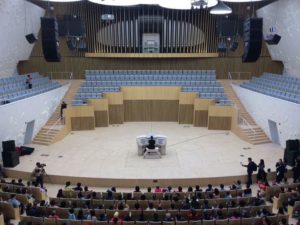
FCW2018, inaugural recital, December 2018.
Updates for December 2018
24 December 2018
Christmas and Holiday Greetings from The Pipe Organ in China Project.
There are three updates for new installations this month, all oddly in Zhejiang Province:
Of these, the Ningbo installation of a 1908 Hinners organ is significant as the third known relocating of an existing organ to China. This is of course a trend that should be encouraged, despite a certain resistance to the concept in context. The Hinners firm was located in Pekin, IL, and it is somewhat amusing to know that the name of the town has been attributed to the (erroneous) 19th C. belief that Peking (Beijing) was on the exact opposite side of the globe from the town. The earliest known pipe organ in Korea (a I/7+Ped tracker) was also built by Hinners, in 1919 (sadly, destroyed in the Korean War.) There are also reports (unverified) of a Hinners organ in pre-WWII Manila.
The Hangzhou (Hangchow) installations at Zhejiang Conservatory are both by Freiburger Orgelbau.
We are also very pleased to tell you that, six months after launching this site, we now have over 2,000 hits.
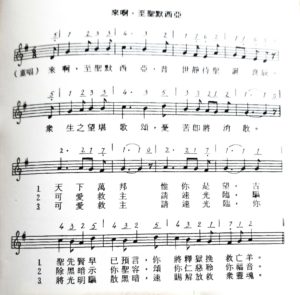
Merry Christmas! 聖誕快樂! And see you again in the New Year. POCP
Update for November 2018
3 December 2018
This has been a quiet month at The Pipe Organ in China Project.
There is an update to
including a CCTV video short from a couple of years ago, about the program in organ study recently introduced at the Shanghai Conservatory. The organ is heard, but only in snippets of the T & F in D minor.
If any of our visitors finds links to performances on organs in China, we would be happy to add these to the respective pages. Please use the Contact Us page for this purpose.
W.C. Blackett: new biographical information and video of the blowing apparatus in HKG1934
14 November 2018
In the past month the Project has received several communications relating to William Charlton Blackett (1859-1941), the most important organ builder ever to work in Hong Kong.
The first item, courtesy of our friend and colleague Stuart Wolfendale, is a link to a historical website devoted to Heaton, Newcastle-on-Tyne, where Blackett founded his first organ firm with Charles William Howden around 1890 (Blackett and Howden). A section on Blackett and Howden can be found here, including information about Blackett’s risky 1917 trip from London to Hong Kong onboard the S.S. Fushimi Maru: https://heatonhistorygroup.org/tag/heaton-methodist-church/?fbclid=IwAR3qGWldMYd4WlQqWeXsAy9ObPXunUaGUd-mjnsG_LCpiAm0ZF1-F8c6–Q
Thanks to the kindness of Mr. Lee Ping Yin, the Project also recently received a short video of the blowing mechanism of HKG1934, at St. Teresa’s Church, Kowloon Tong, Hong Kong. This is the ‘big wheel’ system referred to by the informant who provided information about the organ at Rosary Church, Kowloon (HKG1933a), and is certainly unique as far as we are concerned.
The Project hopes that HKG1934 will eventually be restored to playing condition.
If Size Matters, How Do We Measure It?
5 November 2018
By Project Founder, Prof. David Francis Urrows
In the course of China’s ‘organ race’ (see FAQs) the issue of the size of organs has been a prominent theme. The Project has recorded comments about this one-upmanship feature of the race, and the sometimes odd or purely symbolic decisions to build (or at least label) organs with specific numbers of stops, such as the 88 stops of SHA2005, and the 56 stops of ORD2010.
The problem with defining the size of a pipe organ is a fraught business, and only gets more complicated as the size of the instrument increases. There are three basic measurements:
- Number of stops
- Number of pipes
- Weight
All three of these are not as clear as they might appear at first, and are subject to manipulation. Does the number of stops include only the number of real stops, or of all speaking stops? That is, are we counting the stops backed up by an actual rank of pipes, or ranks extended, transmitted, borrowed, or otherwise re-utilized by the builder to create a new stop out of an existing stop?
The number of pipes is even more open to deceptive practices, since certain types of stops use multiple pipes per note (as with Mixtures and Mutations.) Thus an organ builder can bulk up the pipe count, at little expense, by including many mixtures and mutations in the instrument without making it bigger in a tonal, or musically significant way.
Weight is the crudest measure of size, and only really an issue with very large organs.
Recently, an attempt to establish a metric which rationalizes all these issues was published in the online journal of the American Guild of Organists (AGO), Vox Humana. This system, devised by Polish organist Michał Szostak, uses a form of real rank count to gauge the size of a very large organ. This system privileges organs with lots of mixtures: but it also makes allowance for stops that are not full-length, and averages out mixtures with varying numbers of pipes per note. The article can be found at:
The greatest battle of the largest organs has always been between the Atlantic City (NJ) Boardwalk Hall Organ, and the Wanamaker Organ in Philadelphia. Using Szostak’s system, Atlantic City comes out ahead due to its rank count (517 vs. 470), even though Wanamaker has more stops (395 vs. 381). He provides charts for the largest organs in the United States, Europe, and the world. It is significant that the majority of the instruments in these charts are located in either the U.S., or Germany.
How this metric would apply to the question of the size of some of China’s larger organs, such as HKG1989, CAN1995b, PEK2007a, and FCW2017, is not entirely clear. It would be extremely interesting to follow up this exercise, but it is difficult to get accurate specs for some of these instruments, as has been noted in Keys to the Kingdom and elsewhere on this website. However, it also remains to be seen what criticism Szostak’s system will encounter, and how widely it may be accepted and used in the future.
Updates for October 2018
30 October 2018
Updates for October 2018 on The Pipe Organ in China Project Website:
XAN2016 (new installation)
FCW1915 (updated information)
CAN1995a (stop list added)
Happy Hallowe’en from The Pipe Organ in China Project!
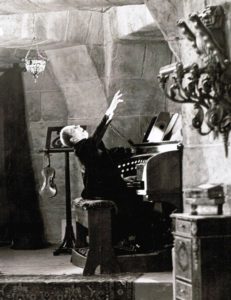
Updates for September 2018
4 October 2018
New organs by three different builders have been added to the Census:
We are anticipating additional new instruments by the end of the year in Macau and Fuzhou, so please check back regularly. Some new pictures have also been added to MAC1831 after a trip by the project founder to Macau in late September.
Thanks to all our visitors for your continuing support. We have added a tracker to the site so that we can see how many hits we are getting, and other data. So far we are very encouraged! (And, no, we do not know why Monsignor Garnier (see previous post) has become the ‘mascot’ of our Facebook posts, when we have subsequently added new pictures.)
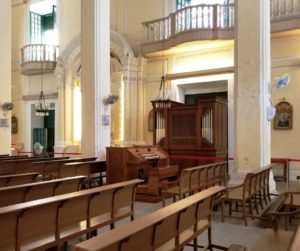
MAC2018a
Further thoughts on FCW1931
11 September 2018
By Project founder, Prof. David Francis Urrows
______________________________________
FCW1931 is the small bamboo organ reported by Hong Kong organ enthusiast, Peter Cheung, in 1975. In his book, Pipe Organs, Electronic Organs, and Organists, and also in a letter to the South China Morning Post (24 February 1975), Cheung reported that in 1931 he had seen a “bamboo organ, quite small, with all bamboo pipes, built by foreign missionaries…in a small church in Foochow, Fukien Province.”
On p. 272 of Keys to the Kingdom I questioned whether this could have been one of François Ravary and Léopold Deleuze’s bamboo organs of the early 1860s. It would be quite extraordinary to think that there were further builders in late 19th or early 20th Century China of such instruments after the death of Deleuze in 1865, and that of Ravary in 1891. One cannot rule out the remote possibility that Deleuze’s student apprentices in Shanghai might have carried on the tradition; they certainly are known to have continued building normal reed organs/harmoniums at the Tushuwan orphanage near Zikawei. But there is no evidence that new bamboo organs continued to be built after Deleuze’s death, aside from the fact that Ravary continued to tinker with those already installed until 1891.
While Cheung did not identify the ‘church’ in question, I have assumed cautiously that this was probably a Roman Catholic church or chapel, although there is actually no evidence for this assumption. Or is there?
Recently I revisited a short report, published on page 3 of the North-China Daily News on 20 January 1896, about the consecration of a Roman Catholic chapel in Fuzhou:
“In its account of the consecration of the new Roman Catholic Chapel at Foochow, the Echo mentions that Bishop Masot[1] presented the ground and the organ; the French consul, M. Frandin[2], originated the idea and worked hard to get it carried through; Count P. de Barthelémy[3], on a visit to Foochow, gave a comparatively large sum to start subscriptions for the purpose; Mr. Fairhurst[4] and Count de Galembert[5] guaranteed the outlay until the subscriptions were collected; Bishop Garnier[6] of Shanghai gave the altar-piece and the candlesticks; and Sir Robert Hart[7], Bart., contributed $400; besides many others.”
The Shanghai paper abstracted this from the Foochow Daily Echo, which ran from 1884 to 1911 (or later), the original of which I have not yet located. It would be very interesting to see this, as it might contain more detailed information, for example, the name and dedication of the ‘chapel.’ When I first read this around 2013, I printed out an A3 copy, marked the paragraph, and wrote at the top of the page “Fuzhou – probably a harmonium”.
Yes, it states that the organ was procured by the local bishop, Salvator Masot. No, it does not identify the church (although it was clearly not St. Dominic’s Cathedral.) But the name that jumped out at reading it again was that of Bishop Valentin Garnier from Shanghai, someone who in fact knew both Ravary and Deleuze, the masterminds of the bamboo organ workshop at Zikawei, very well.
Garnier appears once in Keys to the Kingdom, in an account by another priest written in December 1881:
“We spent the Feast of St. Francis Xavier [3 December] at Dongjiadu with Monsignor Garnier. The Cathedral was very well decorated, and Father Ravary inaugurated four stops of his organ, the only ones which were ready under the circumstances. When the other twenty are in place, it will truly be an instrument worthy of a cathedral, even in France.” (p. 172.)
The organ referred to here is SHA1881, Ravary’s final expansion, to a III/24 instrument, of the ‘Bamboo Organ of Tungkadoo’ that he and Deleuze had originally built a quarter-century earlier (SHA1857). So, Garnier was very much in the thick of the matter of the bamboo organs.
An appealing hypothesis emerges here: could Garnier have off-loaded one of the half-dozen small bamboo positives, built by Deleuze and his students in the later 1850s and early 1860s, onto Bishop Masot? He was generous enough with the altar and candlesticks, and it must have taken a good deal of ecumenical goodwill on his part to do this, considering the sorry history of relations between the Jesuits and the Dominicans in China over two tempestuous centuries.
All this is unprovable, at least at present. If we had been told more by Peter Cheung, we could rule in or out that the bamboo organ was seen in a Roman Catholic church. Failing that, what we have is a report of an ‘organ’ installed in 1896 in a Roman Catholic chapel in the right city, Fuzhou. (At this date, ‘organ’ generally meant reed organ.) The instrument, if built by Deleuze, et al., would have been about thirty years’ old at that point: but Deleuze built things to last, as his one remaining positive, now in Paris in the Musée de la Musique, shows (SHA1858). Cheung, showing up in 1931, thirty-five further years later, describes an instrument that answers well to what we know of Deleuze’s small bamboo organs. And he was evidently told that it had been “built by foreign missionaries” and thus was not an imported instrument, and probably of considerable age by that time.
A published study such as Keys to the Kingdom is not the place for flights of fancy speculation such as this. But the internet is just the place, and the Project puts forward this line of inquiry and hopes someday to improve on it when more information is available.
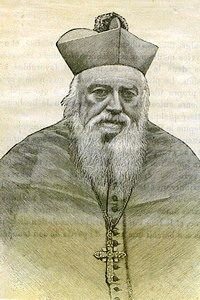
Valentin Garnier SJ
[1] Salvator Masot y Gómez OP, Vicar Apostolic of Fujian Province, 1845-1911.
[2] Joseph Hippolyte Frandin, 1852-1924.
[3] François Pierre Sauvaire de Barthélémy, 1870-1940.
[4] Thomas Fairhurst, tea merchant, dates unknown.
[5] Probably Henri de Bodin de Galembert, 1854-?
[6] Valentin Garnier SJ, Vicar Apostolic of Jiangnan (Kiangnan) Province, 1825-98.
[7] Notable inspector general of the China Imperial Maritime Customs (CIMC) Service, 1835-1911.
Link for Keys to the Kingdom
1 September 2018
The non-functioning link to the website of the Ferdinand Verbiest Institute’s page on Keys to the Kingdom has now been fixed.
If there is any problem with the button on that page, the correct URL is: https://www.kuleuven.be/verbiest/publications/lcs/lcs38
Thank you for your patience on this matter.
Updates to the website, August 2018
25 August 2018
Updates to the site in the last month (August 2018) include the following items:
Main illustrations (pics) have now been added to all pages for 17, 18, and 21 C. organs, and many other illustrations have been added to different pages. The text has been revised for 17th C. organs, and we are gradually standardizing the language of reporting on the site.
Additions to the Census:
and: HKG1977a is now re-numbered HKG1982; HKG1977a is assigned to a different and newly-identified installation.
New pages up to 2016
3 August 2018
Pages for all organs listed in the Census (Appendix) to Keys to the Kingdom have now been uploaded! These includes several instruments which were not known to the Project at the time the final authorial edit was completed in September 2016.
The Project will now focus on instruments which have been installed in the past 24 months, and on enhancing the existing pages with more (and in some cases, better) photographs and illustrations. We are particularly interested to hear from any visitors to the site who may have material of this kind to share. Please communicate with us through calcant@organcn.org
Thank you all for your continuing support.
New pages uploaded
27 July 2018
Pages for all organs installed in Macau, Hong Kong, and Mainland China for the first half of the present decade (2010-2014) have now been uploaded. Pages for installations up to the present date will follow in the next couple of weeks.
Thank you for your support and your patience.
Contact Us page up and working
24 July 2018
The Project is pleased to announce that the Contact Us link is now working.
If you experience any difficulty with sending us a message by clicking on the link, please copy the email address (calcant@organcn.org) and paste it into your usual email program and proceed from there.
Thank you all for your patience.
New pages
20 July 2018
Pages for all pipe organs installed in Hong Kong, Macau, and Mainland China in the decade 2000-2009 are now up.
Further pages for the current decade (2010- ) will be created in the coming weeks (there are a very large number of these).
Updates on pages
16 July 2018
All pages for organs installed in Hong Kong and Mainland China between 2000 and 2004 have now been uploaded. Pages for the second half of the decade will follow in the next week or so.
The Project would like to point out that this site is mainly for research and dissemination, and only incidentally for publicity or other matters.
We are aware that the Contact Us page is not functioning correctly, and we are working this week on getting this fixed. Thank you for your patience.
Updates on the new organs
12 July 2018
Pages have now been uploaded for all pipe organs in Mainland China and Hong Kong built in the 1970s and 1980s. Further pages will appear shortly.
3 early regals in China
10 July 2018
The Project has consistently eschewed dealing with pipe organ-like instruments such as the regal, the harmonium, and all kinds of electronic and digital organs, except where these occasionally shed some light on the larger topic, or are important for the association of ideas.
Recently, our colleague Prof. Patrizio Barbieri published an article in Informazione Organistica (see below, and also PEK1720) from which some very interesting information about three regals in China has emerged.
The first of these is a regal presented to the Jesuits in 1598 by Rannucio I Farnese, Duke of Parma (r. 1592-1622). This was “a regal contained in a small writing desk to be sent to the Jesuit fathers…who have been instructed to present it to the King [sic.] of China.” Rannucio’s interest in the China mission may have been influenced by his mother, Maria of Portugal, and the fact that the China mission was almost entirely both Jesuit and Portuguese until the second quarter of the seventeenth century, due to the establishment by the papacy of the padroado. It was this same Duke of Parma who later sent an extravagant claviorganum to China (MAC1620).
It seems unlikely this 1598 regal ever got to Beijing, but this raises at the same time the interesting question, that if it did, is this then the organo used in Beijing in 1611 at the funeral of Matteo Ricci? This is a question easy to pose, and virtually impossible to answer.
The second regal appears over a century later, and was presented to the Kangxi emperor by the papal legate Charles Thomas Maillard de Tournon in 1707. Information about this comes from a letter written four years later by Teodorico Pedrini, who remarked that “Musical instruments are very pleasing to him [Kangxi], the best is a small regal presented to him by the late Cardinal [de Tournon].”
The third and last regal was a small instrument, a “regoletto…decorated with inlay” brought to Kangxi in 1719 with the embassy of the papal legate, Mezzabarba. This was among the instruments that included PEK1720.
We are grateful to Prof. Barbieri for sharing his research with us.
PEK1720: major update
9 July 2018
Through the kindness of our colleague, Prof. Patrizio Barbieri, many new details about PEK1720 have recently come to light. This information is contained in the article, “Musical Instruments, Gut Strings, Musicians and the Corelli Sonatas at the Chinese Imperial Court: The Gifts of Clement XI (1700-1720)”. Informazione Organistica, XXVIII/2 (December 2016), pp. 205-257.
This article also contains some additional interesting information which will be noted in future News posts. The entire volume is dedicated to the memory of the late Prof. Peter Williams, with whom Prof. Urrows studied at Edinburgh University in 1979-80.
Keys to the Kingdom: Errata corrigenda
23 June 2018
Keys to the Kingdom: A History of the Pipe Organ in China
A running list of errata, typos, and other text issues. Corrections to items listed in the Census (pp. 347-59) are dealt with on the pages for individual organs on this website.
TOC (p. 7)
Interlude I: for 137, read 139
Chapter 4: for 149, read 151
Chapter 1
p. 26, para. 2, for (1584-1601) read 1557-1603.
p. 43, para. 2, for “establish an anti-meridian”, read established
Chapter 2
p. 78, fn 138, for “the diagrams…” read the trigrams
p. 82, para. 1, for “MAC600”, read Mac1600
Chapter 3
p. 132, para. 2, for “and continued to cultivated traditions”, read the cultivated
Interlude I
p. 143, para. 1, for “Louis de Poirot, in 1814” read 1813
Chapter 4
p. 167, chart 4.3, for “Trompette (reed, to Tenor c [?])” read “from Tenor c”.
p. 172, para. 2, for “Seminary of Brugelette” read pensionnat of Brugelette.
p. 172, fn 372, for “Presumably Jules Dufour d’Astafort” read Léon Dufour. The Project is working on finding out more about this figure.
p. 180, fn 400, for “Cathédale de Pékin”, read Cathédrale
p. 201, para 2, for “Fonatanier”, read Fontanier
Chapter 5
p. 219, para. 2, for “Thomas, our la Mission de Pékin”, read ou la Mission de Pékin
p. 232, para. 4, for “Rieger Op. 2736 (II/31)” read Op. 2737 (II/14)
p. 237, para. 2, for “SHA1888”, read SHA1883a
p. 261, para. 3, for “SHA1934”, read SHA1933
p. 263, para. 2, for “Schumann shared the duties”, read Schuhmann shared
p. 264, Chart 5.11, II. Manual, 13., vox celestis should have: 8′
p. 271, Chart 5.13, for “FCH1915” read FCW1915.
p. 277, para. 3, for “from the 1884 Walker”, read from the 1887 Walker
Chapter 6
p. 288, para. 1, for “managed to archives”, read the archives
p. 308, para. 1, for the Seifert organ, mis-numbered as “HKG1975”, read HKG1973; for “four ranks (but nonetheless with two manuals and pedal) read with four ranks on one manual, and with a pull-down pedal).
p. 309, para. 2, for “made in the 1980s”, read made in 1993
p. 317, para. 2, for “in Beijing in 2011 (PEK2011)”, read 2012 (PEK2012)
Chapter 7
p. 332, fn 759, for “an 40-minute metro ride”, read and a 40-minute metro ride
Appendix
p. 358, PEK2015b, for “Casvant”, read Casavant
Bibliography
p. 400, 5.
For “Allsop, Peter W.” read Peter C.; and add page numbers, “43-59”.
Last update: 19 February 2024
POCP Website Online
20 June 2018
The Pipe Organ in China Project Website is now up and online at www.organcn.org! At present pages for all the historical (i.e. pre-1949) instruments are available for viewing. More photos, pics, and enhancements will gradually be added to these pages.
The new installations (i.e. post-1949) will be also be added over the next few months. Please check back frequently as the site is enlarged.
